
U.S.
Department of
Justice
Office
of
Legal
Counsel
Office
of
the
Deputy
Assistant
Attorney
General
Washington.
D.C. 20530
November
30, 2001
MEMORANDUM
FOR
ALBERTO
R.
GONZALES
COUNSEL
TO
THE
PRESIDENT
FROM :
John C. Yoo (signature of John C. Yoo)
Deputy
Assistant
Attorney
General
Robert J. Delahunty (signature of Robert J. Delahunty)
Special Counsel
RE :
Treaties
and
Laws
Applicable
to the
Conflict
in
Afghanistan
And
to the Treatment
of
Persons
Captured
by
U.S.
Armed
Forces
In
that
Conflict
In
the course of
the
current
military
effort
to combat international
terrorism,
including
the
present campaign in Afghanistan against the al
Qaeda
terrorist organization and the Taliban
militia,
it is foreseeable that U.S.
military
forces
will
need to detain
foreign
nationals in the
course of conducting
military
operations. You have asked for our Office's views on several
questions concerning the application of certain treaties, domestic federal law, and customary
international
law to the armed
conflict
in Afghanistan.
1
In particular, you have asked about the
applicability
of the laws of armed
conflict
to the conduct of the U.S.
Armed
Forces towards
captured members of the al
Qaeda
terrorist group and of the Taliban
militia,
which
provides the
former
with
sanctuary in Afghanistan. We conclude that
these
treaties do not protect the al
Qaeda
organization,
which
as a non-State actor cannot be a party to the international
agreements
governing
war. We further conclude that the President has
reasonable
grounds to
find
that
these
treaties do not apply to the Taliban
militia.
This memorandum
expresses
no
view
as to whether
the President should decide, as a matter of
policy,
that the U.S.
Armed
Forces should
adhere
to
the
standards
of conduct in
those
treaties in the Afghanistan
conflict,
particularly
with
respect to
the treatment
of
prisoners.
We
believe it most useful to examine this question by focusing on the War Crimes Act,
18 U.S.C. § 2441 (Supp.
Ill
1997)
("WCA"),
which
directly
incorporates several provisions of
On
October 7, 2001, the United States Permanent Representative to the United Nations informed the
Security
Council
that the United States, together with other States, had initiated actions in the exercise of their
inherent
right of
individual
and collective self-defense under
Article
51 of
the
United Nations
Charter
in response to
the attacks on the United States of September II , 2001. See Letter
dated
7 October 2001 from the Permanent
Representative of
the
United
States
of
America to the United Nations addressed to the President of
the
Security
Council,
U.N. Doc. S/2001/946 (2001).
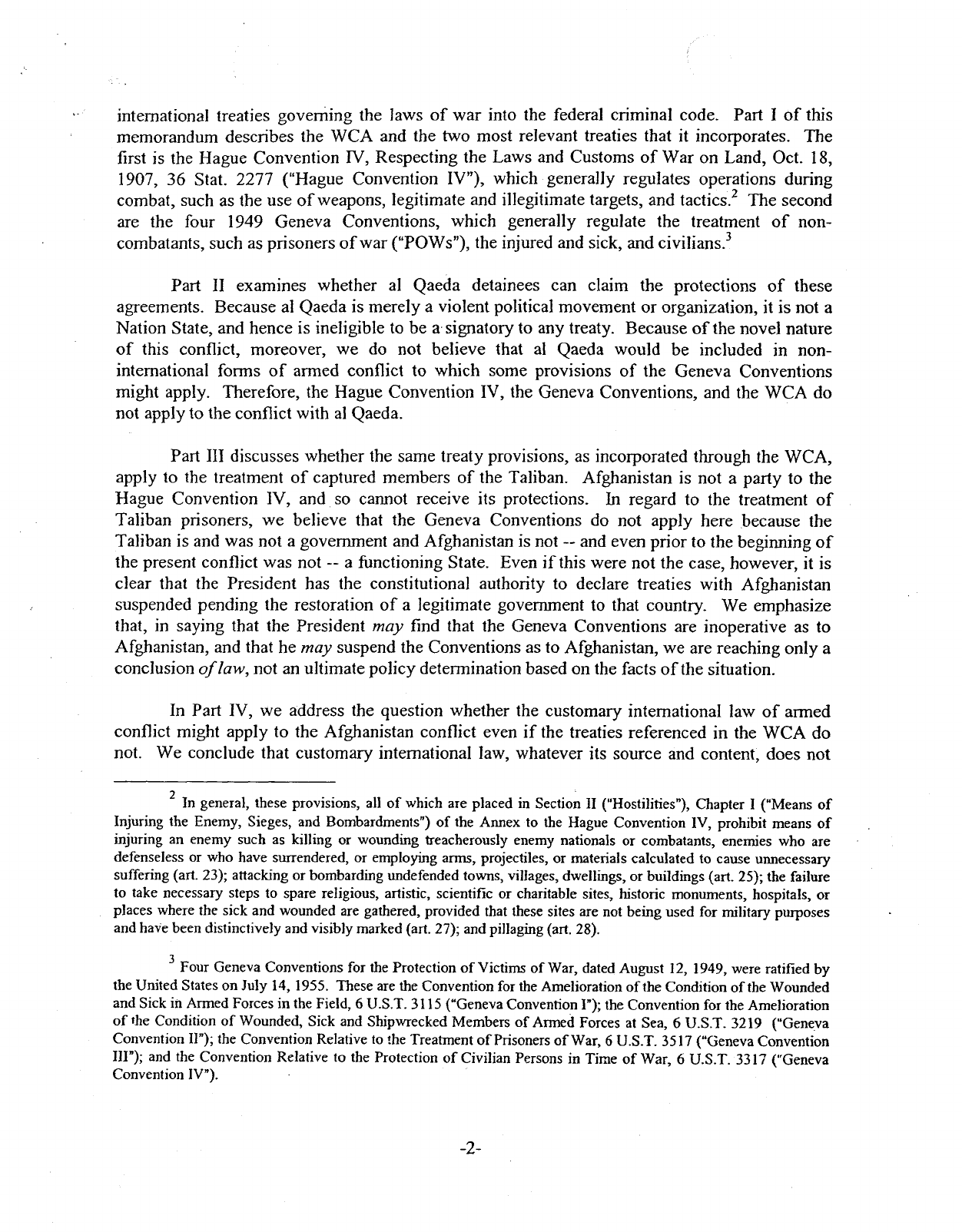
international
treaties governing the laws of war into the federal
criminal
code. Part I of this
memorandum
describes
the WCA and the two most relevant treaties that it incorporates. The
first
is the Hague Convention
IV,
Respecting the Laws and Customs of War on Land, Oct. 18,
1907, 36 Stat. 2277 ("Hague Convention
IV"),
which
generally regulates operations during
combat, such as the use
of
weapons, legitimate and
illegitimate
targets, and tactics.
2
The second
are the four 1949 Geneva Conventions,
which
generally regulate the treatment of non-
combatants, such as prisoners
of
war
("POWs"), the
injured
and sick, and
civilians.
3
Part II examines whether al
Qaeda
detainees
can
claim
the protections of
these
agreements.
Because
al
Qaeda
is merely a
violent
political
movement or organization, it is not a
Nation
State,
and
hence
is
ineligible
to be a signatory to any treaty.
Because
of the novel nature
of
this
conflict,
moreover, we do not believe that al
Qaeda
would
be included in non-
international
forms of armed
conflict
to
which
some
provisions of the Geneva Conventions
might
apply. Therefore, the Hague Convention
IV,
the Geneva Conventions, and the WCA do
not
apply to the
conflict
with
al
Qaeda.
Part
III
discusses
whether the
same
treaty provisions, as incorporated through the WCA,
apply
to the treatment of captured members of the Taliban. Afghanistan is not a party to the
Hague Convention IV, and so cannot receive its protections. In regard to the treatment of
Taliban
prisoners, we believe that the Geneva Conventions do not apply
here
because
the
Taliban
is and was not a government and Afghanistan is not
—
and even
prior
to the beginning of
the
present
conflict
was not
—
a functioning
State.
Even
i f
this
were not the
case,
however, it is
clear that the President has the constitutional authority to declare treaties
with
Afghanistan
suspended
pending the restoration of a legitimate government to that country. We emphasize
that, in saying that the President may
find
that the Geneva Conventions are inoperative as to
Afghanistan,
and that he may
suspend
the Conventions as to Afghanistan, we are reaching
only
a
conclusion
of
law,
not an ultimate
policy
determination
based
on the facts
of
the situation.
In
Part IV, we
address
the question whether the customary international law of armed
conflict
might apply to the Afghanistan
conflict
even if the treaties referenced in the WCA do
not.
We conclude that customary international law, whatever its
source
and content,
does
not
In
general,
these
provisions, all of which are placed in Section II ("Hostilities"), Chapter I ("Means of
Injuring
the Enemy, Sieges, and Bombardments") of the Annex to the Hague Convention IV, prohibit means of
injuring
an enemy such as killing or wounding treacherously enemy nationals or combatants,
enemies
who are
defenseless
or who have surrendered, or employing arms, projectiles, or materials calculated to cause unnecessary
suffering (art. 23); attacking or bombarding undefended towns, villages, dwellings, or buildings (art. 25); the failure
to take necessary
steps
to spare religious, artistic, scientific or charitable sites, historic monuments, hospitals, or
places where the sick and wounded are gathered, provided that
these
sites
are not being used for military purposes
and
have been distinctively and visibly
marked
(art. 27); and pillaging
(art.
28).
3
Four
Geneva Conventions for the Protection of
Victims
of
War,
dated August 12, 1949, were ratified by
the United States on
July
14,1955. These are the Convention for the Amelioration of the Condition of the Wounded
and
Sick
in
Armed
Forces in the
Field,
6
U.S.T.
3115 ("Geneva Convention
I");
the Convention for the Amelioration
of the Condition of Wounded,
Sick
and Shipwrecked Members of
Armed
Forces at Sea, 6
U.S.T.
3219 ("Geneva
Convention
II");
the Convention Relative to the Treatment of
Prisoners
of
War,
6
U.S.T.
3517 ("Geneva Convention
III");
and the Convention Relative to the Protection of
Civilian
Persons in Time of
War,
6
U.S.T.
3317 ("Geneva
Convention
IV").
-2-

bind
the President, or restrict the actions of the
United
States
military,
because
it
does
not
constitute federal law recognized under the Supremacy Clause of the
Constitution,
U.S. Const.,
art.
VI ,
cl. 2. However, we also conclude that the President has the constitutional authority as
Commander in
Chief
to
interpret and apply the customary or common laws of
war
in such a way
that they
would
extend to the conduct of members of
both
al
Qaeda
and the Taliban, and also to
the conduct of the U.S.
Armed
Forces towards members of
those
groups taken as prisoners in
Afghanistan.
I.
Overview
of
the War
Crimes
Act and the
Laws
of
War
Section
2441 of
title
18 renders certain
acts
punishable as "war crimes." The
statute's
definition
of that term incorporates, by reference, certain treaties or treaty provisions relating to
the laws of
war,
including
the Hague Convention IV and the Geneva Conventions. We believe
that the WCA provides a useful starting point for our analysis of the application of the Hague
Convention
IV and the Geneva Conventions to the current
military
operations, and the treatment
of
detainees, in the Afghanistan theater of operations.
4
A.
Section 2441: An Overview
Section
2441
reads
in
full
as
follows:
War
crimes
(a)
Offense.-Whoever, whether inside or outside the
United
States,
commits a
war
crime, in any of the circumstances described in subsection (b), shall be
fined
under this
title
or imprisoned for
life
or any term of years, or
both,
and
if
death results to the
victim,
shall also be subject to the penalty
of
death.
(b)
Circumstances.-The circumstances referred to in subsection (a) are that the
person
committing
such war crime or the
victim
of such war crime is a
member of the
Armed
Forces of the
United
States
or a national of the
United
States
(as defined in section 101
of
the
Immigration
and
Nationality
Act).
(c)
Definition.-As
used in this section the term "war
crime"
means
any conduct-
(1)
defined as a grave breach in any of the international conventions signed at
Geneva 12 August 1949, or any
protocol
to such convention to
which
the
United
States
is a party;
(2)
prohibited by
Article
23, 25, 27, or 28 of the Annex to the Hague
Convention
IV, Respecting the Laws and Customs of War on Land, signed 18
October 1907;
The
rule of lenity requires that the WCA be read so as to ensure that prospective defendants have
adequate notice of the nature of
the
acts that the statute condemns. See, e.g., Castillo v.
United
States, 530
U.S.
120,
131 (2000). In
those
cases in which the application of
a
treaty incorporated by the
WCA
is unclear, therefore, the
rule
of lenity
requires
that the interpretative issue be resolved in the defendant's favor.
-3-
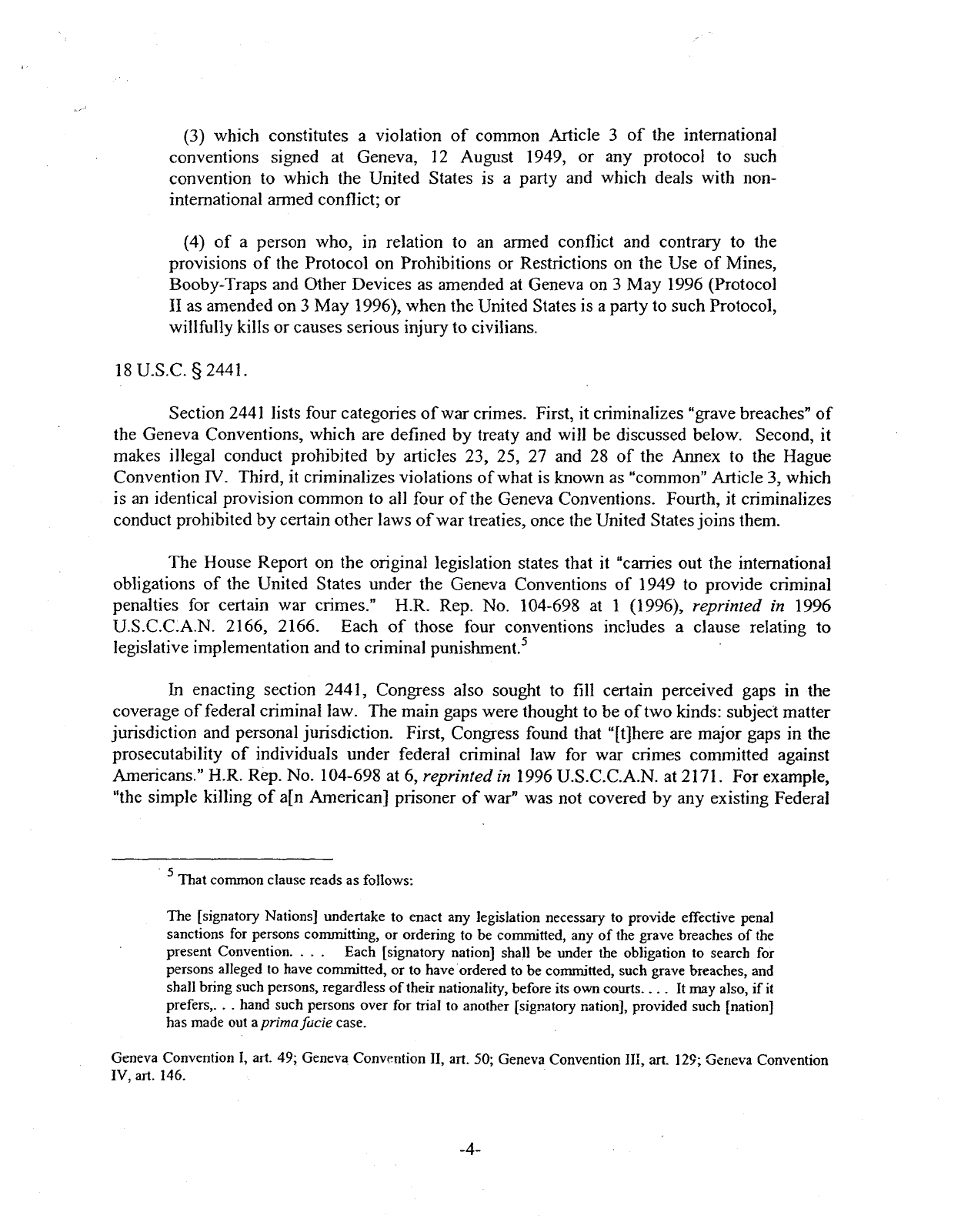
(3)
which
constitutes a
violation
of common
Article
3 of the international
conventions signed at Geneva, 12 August 1949, or any protocol to such
convention
to
which
the
United
States
is a party and
which
deals
with
non-
international
armed
conflict;
or
(4)
of a person who, in relation to an armed
conflict
and contrary to the
provisions
of the Protocol on Prohibitions or Restrictions on the Use of Mines,
Booby-Traps and Other Devices as amended at Geneva on 3 May 1996 (Protocol
I I
as amended on 3 May 1996), when the
United
States
is a party to such Protocol,
willfully
kills
or
causes
serious
injury
to
civilians.
18 U.S.C.
§2441.
Section 2441 lists four categories
of
war
crimes. First, it criminalizes "grave
breaches"
of
the Geneva Conventions,
which
are defined by treaty and
will
be discussed below. Second, it
makes
illegal
conduct prohibited by articles 23, 25, 27 and 28 of the Annex to the Hague
Convention
IV.
Third,
it criminalizes violations
of
what
is known as "common"
Article
3,
which
is
an identical provision common to all four of the Geneva Conventions. Fourth, it criminalizes
conduct
prohibited
by certain other laws
of
war
treaties,
once
the
United
States
joins
them.
The House Report on the
original
legislation
states
that it "carries out the international
obligations
of the
United
States
under the Geneva Conventions of 1949 to provide
criminal
penalties for certain war crimes." H.R. Rep. No. 104-698 at 1 (1996), reprinted in 1996
U.S.C.C.A.N.
2166, 2166. Each of
those
four conventions includes a
clause
relating to
legislative
implementation and to
criminal
punishment.
5
In
enacting section 2441,
Congress
also sought to
fill
certain perceived
gaps
in the
coverage of federal
criminal
law. The main
gaps
were thought to be
of
two
kinds: subject matter
jurisdiction
and personal
jurisdiction.
First,
Congress
found that "[t]here are major
gaps
in the
prosecutability
of individuals under federal
criminal
law for war crimes committed against
Americans."
H.R. Rep. No. 104-698 at 6, reprinted
in
1996
U.S.C.C.A.N.
at
2171.
For example,
"the simple
killing
of a[n American] prisoner of
war"
was not covered by any existing Federal
That
common clause reads as follows:
The
[signatory Nations] undertake to enact any legislation necessary to provide
effective
penal
sanctions for persons committing, or ordering to be committed, any of the grave breaches of the
present Convention. . . .
Each
[signatory nation] shall be under the obligation to search for
persons alleged to have committed, or to have ordered to be committed, such grave breaches, and
shall
bring such persons, regardless of
their
nationality, before its own courts It may also, if
it
prefers,.
. . hand such persons over for
trial
to another [signatory nation], provided such [nation]
has made out
a
prima
facie case.
Geneva
Convention I, art. 49; Geneva Convention
II,
art. 50; Geneva Convention
III,
art. 129; Geneva Convention
IV,
art.
146.
-4-
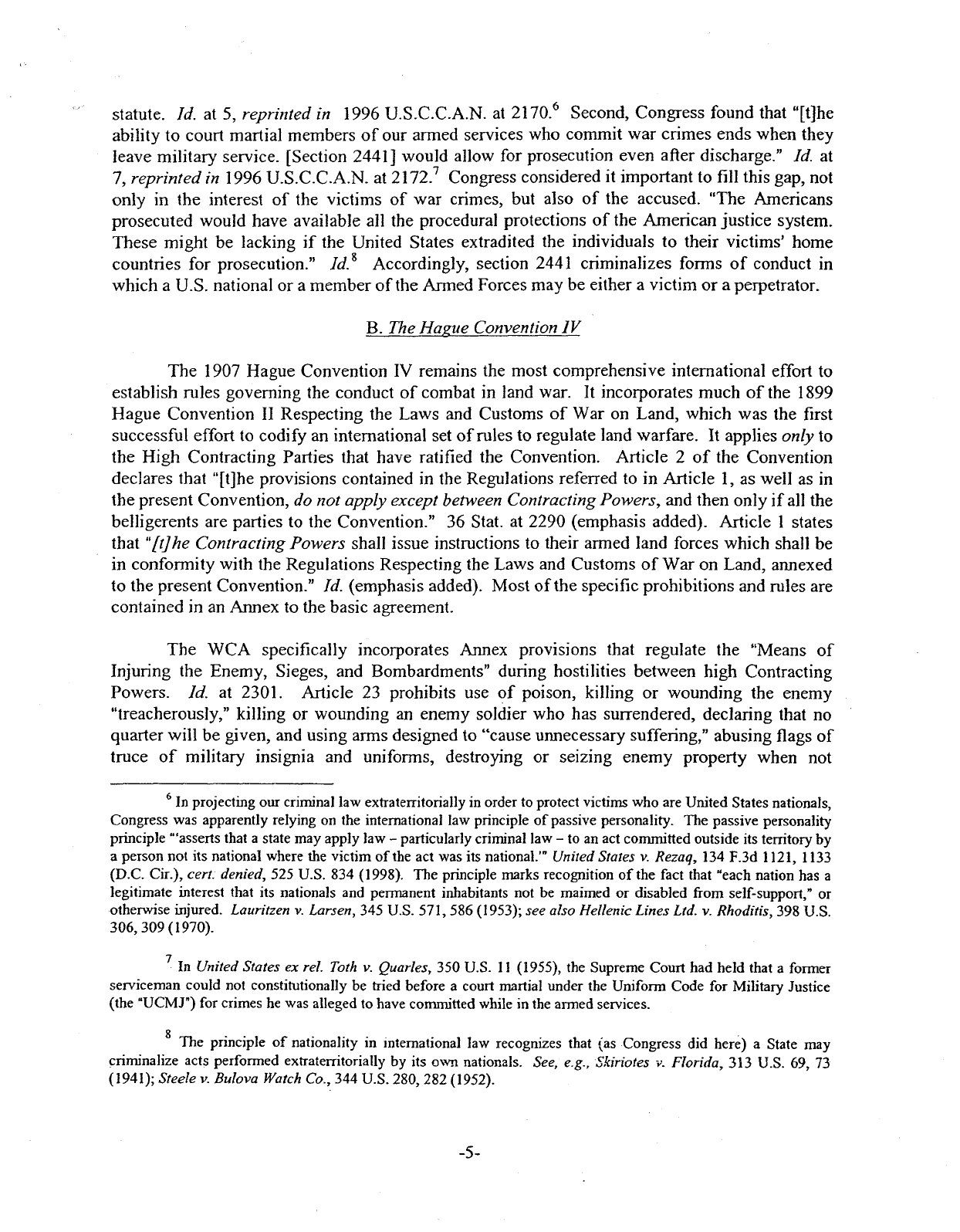
statute. Id. at 5,
reprinted
in 1996
U.S.C.C.A.N.
at 2170.
6
Second,
Congress
found
that
"[t]he
ability
to court
martial
members of our armed services who commit war crimes
ends
when they
leave
military
service. [Section 2441]
would
allow
for prosecution even after discharge." Id. at
7,
reprinted
in 1996
U.S.C.C.A.N.
at 2172.
7
Congress
considered it important to
fill
this gap, not
only
in the interest of the
victims
of war crimes, but also of the
accused.
"The Americans
prosecuted
would
have
available all the procedural protections of the
American
justice system.
These
might
be
lacking
i f the
United
States
extradited the individuals to their
victims'
home
countries for prosecution." Id*
Accordingly,
section 2441 criminalizes forms of conduct in
which
a U.S. national or a member of
the
Armed
Forces
may be either a
victim
or a perpetrator.
B.
The Hague
Convention
IV
The 1907 Hague Convention IV remains the most comprehensive international
effort
to
establish rules governing the conduct of combat in land war. It incorporates much of the 1899
Hague Convention II Respecting the Laws and Customs of War on Land,
which
was the
first
successful
effort
to
codify
an international set of
rules
to regulate land warfare. It applies only to
the
High
Contracting Parties that
have
ratified
the Convention.
Article
2 of the Convention
declares
that
"[t]he
provisions contained in the Regulations referred to in
Article
1, as
well
as in
the
present
Convention,
do not apply except
between
Contracting
Powers,
and then
only
i f
all
the
belligerents are parties to the Convention." 36 Stat, at 2290 (emphasis added).
Article
1
states
that
"[t]he
Contracting
Powers
shall
issue
instructions to their armed land forces
which
shall be
in
conformity
with
the Regulations Respecting the Laws and Customs of War on Land, annexed
to
the
present
Convention."
Id. (emphasis added). Most
of
the specific
prohibitions
and rules are
contained in an Annex to the
basic
agreement.
The WCA specifically incorporates Annex provisions that regulate the "Means of
Injuring
the Enemy,
Sieges,
and Bombardments" during hostilities between
high
Contracting
Powers. Id. at 2301.
Article
23 prohibits use of poison,
killing
or wounding the enemy
"treacherously,"
killing
or wounding an enemy soldier who has surrendered, declaring that no
quarter
will
be
given,
and using arms designed to
"cause
unnecessary
suffering,"
abusing flags of
truce of
military
insignia and uniforms, destroying or seizing enemy property when not
6
In
projecting our
criminal
law
extraterritorially
in order to protect victims who are United States nationals,
Congress
was apparently relying on the international law principle of passive personality. The passive personality
principle
'"asserts that a
state
may apply law -
particularly
criminal
law - to an act committed outside its
territory
by
a
person not its national where the victim of the act was its
national.'"
United
States
v. Rezaq, 134 F.3d 1121, 1133
(D.C.
Cir.),
cert:
denied,
525 U.S. 834 (1998). The principle marks recognition of the fact that "each nation has a
legitimate interest that its nationals and permanent inhabitants not be maimed or disabled from self-support," or
otherwise
injured.
Lauritzen v. Larsen, 345 U.S. 571, 586 (1953); see
also
Hellenic Lines Ltd. v. Rhoditis, 398 U.S.
306, 309(1970).
7
In United
States
ex rel. Toth v. Quarles, 350
U.S.
11 (1955), the Supreme
Court
had held that a former
serviceman
could not constitutionally be tried before a court
martial
under the Uniform Code for
Military
Justice
(the
"UCMJ")
for crimes he was alleged to have committed while in the
armed
services.
8
The
principle of nationality in international law recognizes that (as Congress did here) a State may
criminalize
acts performed extraterritorially by its own nationals. See, e.g., Skiriotes v. Florida, 313 U.S. 69, 73
(1941); Steele v. Bulova
Watch
Co., 344
U.S.
280, 282 (1952).
-5-

demanded by
military
necessity, or abolishing or suspending the rights of enemy nationals. Id. at
2301-02.
Article
25 prohibits attack on undefended buildings or towns. Id. at 2302.
Article
27
requires that
steps
be taken to
spare
certain buildings, such as hospitals, and
religious,
charitable,
and art centers, "provided they are not being used at the time for
military
purposes."
Id. at 2303.
Article
28 prohibits
pillage.
Id.
Other parts of the Hague Convention IV,
which
are not incorporated via the WCA,
provide
definitions as to belligerents,
spies,
and flags of truce, treatment of POWs and the sick
and wounded, and rules for occupations and armistices.
Perhaps
the most relevant provision in
this
regard is the
definition
of a belligerent who is
eligible
to receive the protections of the laws
of
war.
Article
1 of the Annex
states
that the laws, rights, and duties of war apply to those: a)
who
are commanded by a person responsible for their subordinates; b) who
have
a
fixed,
distinctive
emblem recognizable at a distance; c) who carry arms openly; d) who conduct
themselves according to the laws of war.
These
rules govern both regular armies and
"militia
and volunteer corps."
C.
Grave
Breaches
of
the Geneva Conventions
The Geneva Conventions were approved by a
diplomatic
conference on August 12, 1949,
and remain the
agreements
to
which
more
States
have
become parties than any other concerning
the laws of
war.
Convention I
deals
with
the treatment of wounded and sick in armed forces in
the
field;
Convention II
addresses
treatment of the wounded, sick, and shipwrecked in armed
forces at sea; Convention III regulates treatment of POWs; Convention IV
addresses
the
treatment of
citizens.
While
the Hague Convention IV
establishes
the rules of conduct against
the enemy, the Geneva Conventions set the rules for the treatment
of
the
victims
of
war.
The Geneva Conventions,
like
treaties generally, structure legal relationships between
Nation
States,
not between Nation
States
and private, subnational groups or organizations.
9
All
four
Conventions
share
the
same
Article
2, known as "common
Article
2." It
states:
In
addition to the provisions
which
shall be implemented in peacetime, the
present
Convention shall apply to all
cases
of declared war or of any other armed
conflict
which may
arise
between two or more of the
High
Contracting
Parties,
even
if
the
state
of
war
is not recognized by one of
them.
The Convention shall also apply to all
cases
of
partial
or total occupation of the
territory
of a
High
Contracting Party, even if the said occupation
meets
with
no
armed
resistance.
9
See Trans World Airlines, Inc. v. Franklin Mint Corp., 466 U.S. 243, 253 (1984) ("A treaty is in the
nature of
a
contract
between
nations.");
The
Head Money Cases, 112 U.S. 580, 598 (1884) ("A treaty is
primarily
a
compact
between
independent nations."); United
States
ex rel. Saroop v. Garcia, 109 F.3d 165, 167 (3d
Cir.
1997)
("[T]reaties are agreements
between
nations."); Vienna Convention on the Law of
Treaties,
May 23, 1969, art. 2, §
1(a),
1155
U.N.T.S.
331, 333 ("'[T]reaty' means an international agreement concluded
between
States in written
form
and governed by international law...") (the
"Vienna
Convention"); see
generally
Banco Nacional de Cuba v.
Sabbatino, 376 U.S. 398, 422 (1964) ("The traditional view of international law is that it establishes substantive
principles
for determining whether one country has wronged another.").
-6-
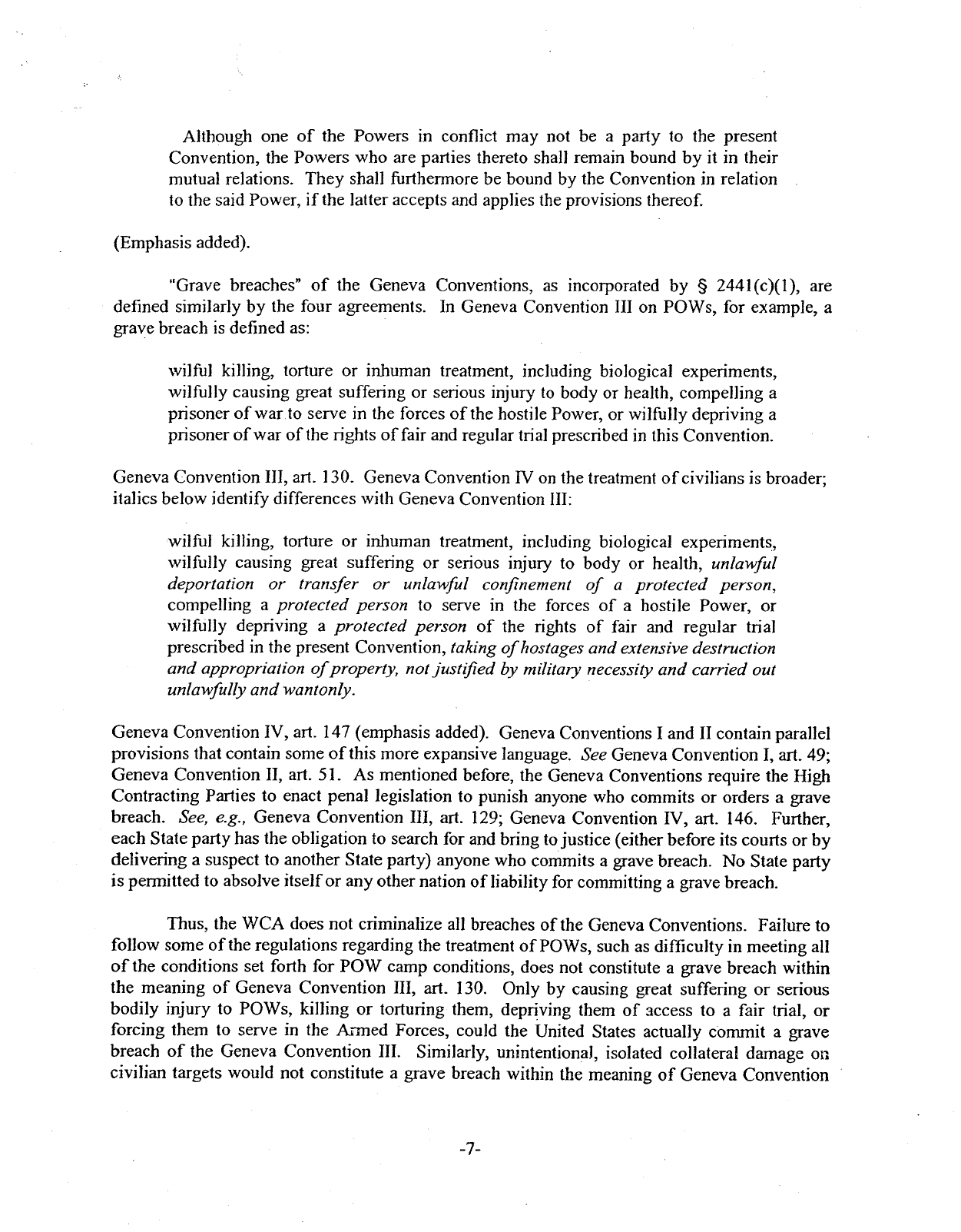
Although
one of the
Powers
in conflict may not be a party to the
present
Convention, the
Powers
who are
parties
thereto shall remain bound by it in their
mutual
relations. They shall furthermore be bound by the Convention in relation
to the said Power,
i f
the latter
accepts
and applies the provisions thereof.
(Emphasis added).
"Grave
breaches"
of the
Geneva
Conventions, as incorporated by § 2441(c)(1), are
defined
similarly
by the four
agreements.
In
Geneva
Convention
III
on POWs, for example, a
grave breach is defined as:
wilful
killing,
torture or inhuman treatment, including biological experiments,
wilfully
causing
great
suffering or
serious
injury
to body or health, compelling a
prisoner of war to
serve
in the forces of the hostile Power, or
wilfully
depriving a
prisoner
of
war of the rights of
fair
and regular
trial
prescribed in this Convention.
Geneva
Convention
III,
art. 130.
Geneva
Convention IV on the treatment
of
civilians
is
broader;
italics
below identify differences
with
Geneva
Convention
III:
wilful
killing,
torture or inhuman treatment, including biological experiments,
wilfully
causing
great
suffering or
serious
injury
to body or health, unlawful
deportation or transfer or unlawful confinement of a protected person,
compelling
a protected person to
serve
in the forces of a hostile Power, or
wilfully
depriving a protected person of the rights of
fair
and regular
trial
prescribed in the
present
Convention, taking
of
hostages and extensive destruction
and
appropriation
of
property, not
justified
by military necessity and
carried
out
unlawfully and wantonly.
Geneva
Convention
IV,
art. 147
(emphasis
added).
Geneva
Conventions I and
II
contain parallel
provisions that contain
some
of
this more expansive
language.
See
Geneva
Convention
I ,
art. 49;
Geneva
Convention
II,
art. 51. As mentioned before, the
Geneva
Conventions require the
High
Contracting
Parties
to
enact
penal legislation to punish
anyone
who commits or
orders
a grave
breach. See, e.g.,
Geneva
Convention
III,
art. 129;
Geneva
Convention IV, art. 146. Further,
each
State
party has the obligation to
search
for and bring to justice (either before its courts or by
delivering
a
suspect
to
another
State
party)
anyone
who commits a grave breach. No
State
party
is permitted to
absolve
itself
or any other nation of
liability
for
committing
a grave breach.
Thus, the WCA
does
not criminalize all
breaches
of the
Geneva
Conventions. Failure to
follow
some
of
the regulations regarding the treatment of POWs, such as
difficulty
in meeting all
of
the conditions set
forth
for POW
camp
conditions,
does
not constitute a grave breach
within
the meaning of
Geneva
Convention
III,
art. 130. Only by causing
great
suffering or
serious
bodily
injury
to POWs,
killing
or torturing them, depriving them of
access
to a
fair
trial,
or
forcing
them to
serve
in the Armed
Forces,
could the United
States
actually commit a grave
breach of the
Geneva
Convention
III.
Similarly,
unintentional, isolated collateral
damage
or,
civilian
targets
would not constitute a grave breach
within
the meaning of
Geneva
Convention
-7-
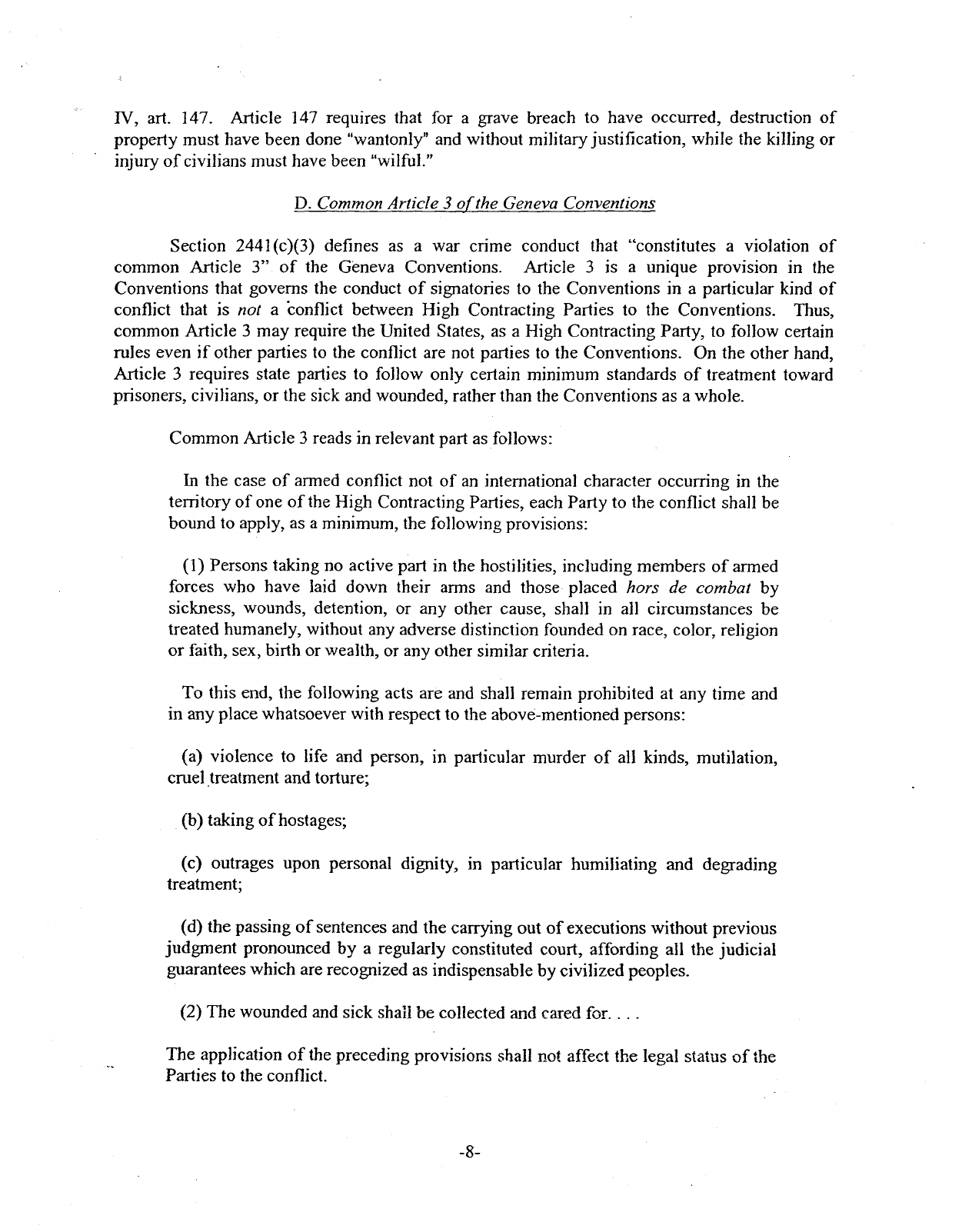
IV,
art. 147.
Article
147 requires that for a grave breach to
have
occurred, destruction of
property
must
have
been
done "wantonly" and
without
military
justification,
while
the
killing
or
injury
of
civilians
must
have
been
"wilful."
D.
Common
Article
3
of
the Geneva Conventions
Section 2441(c)(3) defines as a war crime conduct that "constitutes a
violation
of
common
Article
3" of the Geneva Conventions.
Article
3 is a unique provision in the
Conventions that governs the conduct of signatories to the Conventions in a particular
kind
of
conflict
that is not a
conflict
between
High
Contracting Parties to the Conventions. Thus,
common
Article
3 may require the
United
States,
as a
High
Contracting Party, to
follow
certain
rules even i f other parties to the
conflict
are not parties to the Conventions. On the other hand,
Article
3 requires
state
parties to
follow
only
certain
minimum
standards
of treatment toward
prisoners,
civilians,
or the sick and wounded, rather than the Conventions as a whole.
Common
Article
3
reads
in relevant part as
follows:
In
the
case
of armed
conflict
not of an international character occurring in the
territory
of one of the
High
Contracting Parties,
each
Party to the
conflict
shall be
bound
to apply, as a
minimum,
the
following
provisions:
(1)
Persons
taking no active part in the
hostilities,
including
members of armed
forces who
have
laid
down their arms and
those
placed hors de combat by
sickness, wounds, detention, or any other
cause,
shall in all circumstances be
treated humanely,
without
any
adverse
distinction
founded on race, color,
religion
or
faith,
sex,
birth
or
wealth,
or any other similar criteria.
To
this end, the
following
acts
are and shall remain prohibited at any time and
in
any place whatsoever
with
respect
to the above-mentioned
persons:
(a) violence to
life
and person, in particular murder of all kinds,
mutilation,
cruel
treatment and torture;
(b)
taking
of
hostages;
(c)
outrages
upon personal
dignity,
in particular
humiliating
and degrading
treatment;
(d)
the passing of
sentences
and the carrying out of executions
without
previous
judgment pronounced by a regularly constituted court,
affording
all the
judicial
guarantees
which
are recognized as indispensable by
civilized
peoples.
(2)
The wounded and sick shall be collected and cared
for... .
The application of the preceding provisions shall not affect the legal
status
of the
Parties to the
conflict.
-8-

Article
3 complements common
Article
2.
Article
2 applies to
cases
of declared war or
of
any other armed
conflict
that may arise between two or more of the
High
Contracting Parties,
even
if
the
state
of war is not recognized by one of them.
10
Common
Article
3, however, covers
"armed
conflict
not of an international character"
—
a war that
does
not
involve
cross-border
attacks
—
that occurs
within
the
territory
of one of the
High
Contracting Parties. There is
substantial
reason
to
think
that this language refers specifically to a condition of
civil
war, or a
large-scale armed
conflict
between a
State
and an armed movement
within
its
territory.
To
begin
with,
the text of
Article
3 strongly supports the interpretation that that
Article
was intended to apply to large-scale conflicts between a
State
and an insurgent group. First, the
language at the end
of
Article
3
states
that
"[t]he
application
of
the preceding provisions shall not
affect
the legal
status
of
the Parties to the
conflict."
This
provision
was designed to
ensure
that a
Party that observed
Article
3 during a
civil
war
would
not be understood to
have
granted the
"recognition
of the insurgents as an
adverse
party." Frits Kalshoven, Constraints on the Waging
of War
59 (1987). Second,
Article
3 is in terms
limited
to "armed
conflict
. . . occurring in the
territory
of one of the
High
Contracting
Parties"
(emphasis added). This
limitation
makes
perfect
sense
i f
the
Article
applies to
civil
wars,
which
are fought
primarily
or solely
within
the
territory
of a single
state.
The
limitation
makes
little
sense,
however, as applied to a
conflict
between a
State
and a transnational terrorist group,
which
may
operate
from
different
territorial
bases,
some
of
which
might be located in
States
that are parties to the Conventions and
some
of
which
might not be. In such a
case,
the Conventions
would
apply to a single armed
conflict
in
some
scenes
of
action
but not in others
—
which
seems
inexplicable.
Furthermore, this interpretation is supported by commentators. The Commentary on the
Additional
Protocols
of
8
June
1977 to the Geneva Conventions
of 12
August 1949 (Yves
Sandoz
et al. eds., 1987)
states
at
K
4339 that "a non-international armed
conflict
is distinct
from
an
international
armed
conflict
because
of the legal
status
of the entities opposing
each
other: the
parties to the
conflict
are not sovereign
States,
but the government of a single
State
in
conflict
with
one or more armed factions
within
its
territory."
A legal scholar
writing
in the
same
year in
which
the Conventions were prepared stated that "a
conflict
not of an international character
occurring
in the
territory
of one of the
High
Contracting Parties' .. . must
normally
mean a
civil
war."
Gutteridge, supra n.10, at 300.
Analysis
of the background to the adoption of the Geneva Conventions in 1949 confirms
our understanding of common
Article
3. It
appears
that the drafters of the Conventions had in
mind
only
the two forms of armed
conflict
that were regarded as matters of general international
concern at the time: armed
conflict
between Nation
States
(subject to
Article
2), and large-scale
civil
war within a Nation
State
(subject to
Article
3). To understand the context in
which
the
Geneva Conventions were drafted, it
will
be
helpful
to
identify
three distinct
phases
in the
development
of
the laws
of war.
Article
2's reference to a
state
of
war
"not recognized" by a belligerent was apparently intended to refer
to conflicts such as the 1937
war
between
China
and
Japan.
Both sides denied that a
state
of
war
existed. See Joyce
A. C.
Gutteridge,
The
Geneva Conventions
of
1949, 26
Brit.
Y.B.
Int'l
L.
294,
298-99
(1949).
-9-
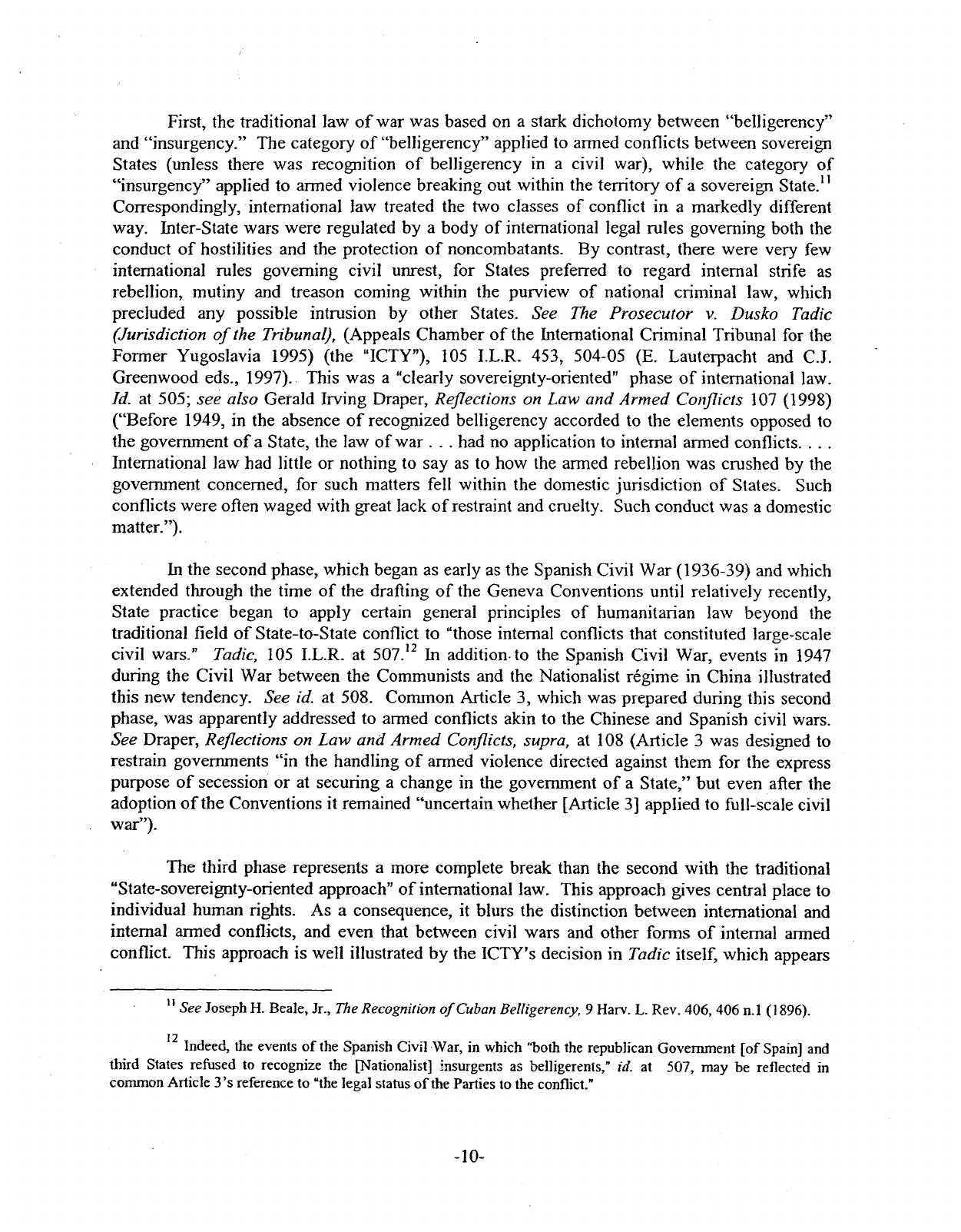
First,
the
traditional
law of war was
based
on a stark dichotomy between "belligerency"
and "insurgency." The category of
"belligerency"
applied to armed conflicts between sovereign
States
(unless there was recognition of belligerency in a
civil
war),
while
the category of
"insurgency" applied to armed violence breaking out
within
the
territory
of a sovereign
State."
Correspondingly,
international law treated the two
classes
of
conflict
in a markedly different
way.
Inter-State wars were regulated by a body of international legal rules governing both the
conduct of
hostilities
and the protection of noncombatants. By contrast, there were very few
international
rules governing
civil
unrest, for
States
preferred to regard internal strife as
rebellion,
mutiny and treason coming
within
the purview of national
criminal
law,
which
precluded any possible intrusion by other
States.
See The
Prosecutor
v. Dusko
Tadic
(Jurisdiction
of
the
Tribunal),
(Appeals Chamber of the International
Criminal
Tribunal for the
Former Yugoslavia 1995) (the
"ICTY"),
105
I.L.R.
453, 504-05 (E. Lauterpacht and C.J.
Greenwood eds., 1997). This was a "clearly sovereignty-oriented"
phase
of international law.
Id.
at 505; see also Gerald
Irving
Draper, Reflections on Law and Armed
Conflicts
107 (1998)
("Before 1949, in the
absence
of recognized belligerency accorded to the elements opposed to
the government of a
State,
the law of war . . . had no application to internal armed conflicts. . . .
International
law had
little
or nothing to say as to how the armed rebellion was crushed by the
government concerned, for such matters
fell
within
the domestic
jurisdiction
of
States.
Such
conflicts
were often waged
with
great lack of restraint and
cruelty.
Such conduct was a domestic
matter.").
In
the second
phase,
which
began as early as the Spanish
Civil
War (1936-39) and
which
extended through the time of the drafting of the Geneva Conventions
until
relatively recently,
State
practice began to apply certain general principles of humanitarian law beyond the
traditional
field
of
State-to-State
conflict
to
"those
internal conflicts that constituted large-scale
civil
wars."
Tadic,
105
I.L.R.
at 507.
12
In addition to the Spanish
Civil
War,
events
in 1947
during
the
Civil
War between the Communists and the Nationalist regime in China illustrated
this
new tendency. See id. at 508. Common
Article
3,
which
was prepared during this second
phase,
was apparently
addressed
to armed conflicts
akin
to the Chinese and Spanish
civil
wars.
See
Draper, Reflections on Law and Armed
Conflicts,
supra, at 108
(Article
3 was designed to
restrain governments "in the handling of armed violence directed against them for the
express
purpose of
secession
or at securing a
change
in the government of a
State,"
but even after the
adoption
of
the Conventions it remained "uncertain whether
[Article
3] applied to full-scale
civil
war").
The
third
phase
represents
a more complete break than the second
with
the traditional
"State-sovereignty-oriented approach" of
international
law. This approach gives central place to
individual
human rights. As a
consequence,
it blurs the distinction between international and
internal
armed conflicts, and even that between
civil
wars and other forms of internal armed
conflict.
This approach is
well
illustrated by the
ICTY's
decision in
Tadic
itself,
which
appears
11
See Joseph
H.
Beale,
Jr.,
The
Recognition
of
Cuban
Belligerency, 9
Harv.
L .
Rev. 406, 406
n.
1
(1896).
12
Indeed,
the
events
of the Spanish
Civil
War,
in which "both the republican Government [of
Spain]
and
third
States refused to recognize the [Nationalist] insurgents as belligerents," id. at 507, may be reflected in
common
Article
3's reference to "the legal status of the Parties to the conflict."
-10-

to
take the
view
that common
Article
3 applies to non-international armed conflicts of any
description,
and is not
limited
to
civil
wars between a
State
and an insurgent group. In this
conception,
common
Article
3 is not just a complement to common
Article
2; rather, it is a catch-
all
that establishes
standards
for any and all armed
conflicts
not included in common
Article
2.
1 3
Nonetheless, despite this recent trend, we
think
that such an interpretation of common
Article
3
fails
to take
into
account, not
only
the language of the
provision,
but also its historical
context.
First, as we have described above, such a reading is inconsistent
with
the text of
Article
3
itself,
which
applies
only
to "armed
conflict
not of an international character occurring in the
territory
of one of the
High
Contacting Parties." In conjunction
with
common
Article
2, the text
of
Article
3
simply
does
not reach international conflicts where both parties are not
Nation
States.
If
we
were to read the Geneva Conventions as
applying
to all forms of armed
conflict,
we
would
expect the
High
Contracting Parties to have used broader language,
which
they easily
could
have done. To interpret common
Article
3 by expanding its
scope
well
beyond the
meaning borne by the text is
effectively
to amend the Geneva Conventions
without
the approval
of
the
State
Parties to the agreements.
Second, as we have discussed,
Article
3 was prepared during a period in
which
the
traditional,
State-centered
view
of international law was
still
dominant and was
only
just
beginning
to give way to a human-rights-based approach.
Giving
due weight to the
State
We
acknowledge that an interpretation of common Article 3 that would apply it to all forms of non-
intemational armed conflict accords better with
some
recent approaches to international humanitarian law. For
example, the Commentary on the Additional Protocols of 8 June 1977 to the Geneva Conventions of 12 August
1949, supra, after first stating in the
text
that Article 3 applies when "the government of
a
single State [is] in conflict
with
one or more armed factions within its
territory,"
thereafter
suggests,
in a
footnote,
that an armed conflict not of
an
international character "may also exist in which armed factions fight against each other without intervention by
the armed forces of the established government." Id. \ 4339 at n.2. A
still
broader interpretation appears to be
supported by the language of the decision of the International
Court
of
Justice
(the
"ICJ")
in Nicaragua v. United
States
—
which, it should be made clear, the United States refused to acknowledge by withdrawing from the
compulsory
jurisdiction
of the
ICJ:
Article
3 which is common to all four Geneva Conventions of 12 August 1949 defines certain
rules
to be applied in the armed conflicts
of
a
non-international
character.
There
is no doubt that,
in
the event of
international
armed conflicts,
these
rules also constitute a minimum yardstick, in
addition to the more elaborate rules which are also to apply to international conflicts; and they are
rules
which, in the Court's opinion, reflect what the
Court
in 1949 called "elementary
considerations of
humanity"
(Corfu
Channel,
Merits,
I.C.J.
Reports 1949, p.22 . . .).
Military and
Paramilitary
Activities In and Against Nicaragua (Nicaragua v. United States), (International
Court
of
Justice
1986), 76
I.L.R.
1, 448, f 218
(E.
Lauterpacht
and
C.J.
Greenwood eds., 1988) (emphasis added). The
ICJ's
language is probably best read to
suggest
that all "armed conflicts" are either international or non-international, and
that if they are non-international, they are governed by common
Article
3.
If
that
is the correct understanding of the
quoted language, however, it should be noted that the result was merely stated as a conclusion, without taking
account either of the precise language of
Article
3 or of the background to its adoption. Moreover, while it was true
that one of
the
conflicts to which the
ICJ
was addressing
itself
-
"[t]he conflict between the contras' forces and
those
of the Government of
Nicaragua"
- was "an armed conflict which is 'not of
an
international
character,"
id. at 448, U
219, that conflict was recognizably a
civil
war between a State and an insurgent group, not a conflict between or
among violent factions in a territory in which the State had collapsed.
Thus
there is room to question the scope of
the
ICJ's
interpretation of common
Article
3.
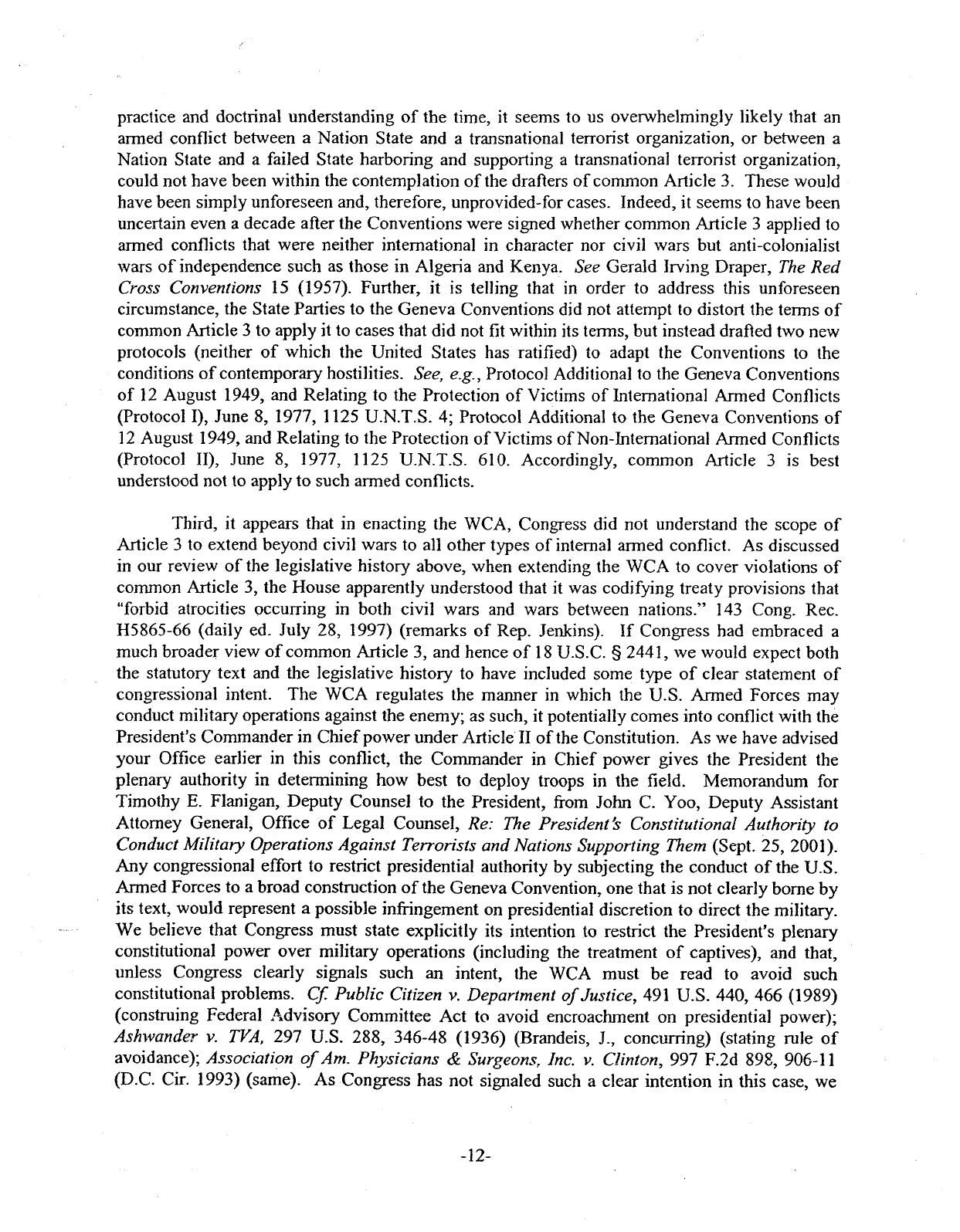
practice and doctrinal understanding of the time, it
seems
to us overwhelmingly
likely
that an
armed
conflict
between a Nation
State
and a transnational terrorist organization, or between a
Nation
State
and a
failed
State
harboring and supporting a transnational terrorist organization,
could
not
have
been
within
the contemplation of the drafters of
common
Article
3.
These
would
have
been
simply
unforeseen and, therefore, unprovided-for
cases.
Indeed, it
seems
to
have
been
uncertain even a
decade
after the Conventions were signed whether common
Article
3 applied to
armed conflicts that were neither international in character nor
civil
wars but anti-colonialist
wars of independence such as
those
in
Algeria
and Kenya. See Gerald
Irving
Draper, The Red
Cross
Conventions 15 (1957). Further, it is
telling
that in order to
address
this unforeseen
circumstance, the
State
Parties to the Geneva Conventions did not attempt to distort the terms of
common
Article
3 to apply it to
cases
that did not fit
within
its terms, but instead drafted two new
protocols (neither of
which
the
United
States
has
ratified)
to
adapt
the Conventions to the
conditions
of contemporary
hostilities.
See, e.g., Protocol
Additional
to the Geneva Conventions
of
12 August 1949, and Relating to the Protection of
Victims
of
International
Armed
Conflicts
(Protocol
I),
June
8, 1977, 1125
U.N.T.S.
4; Protocol
Additional
to the Geneva Conventions of
12 August 1949, and Relating to the Protection of
Victims
of
Non-International
Armed
Conflicts
(Protocol
II),
June
8, 1977, 1125
U.N.T.S.
610.
Accordingly,
common
Article
3 is
best
understood not to apply to such armed conflicts.
Third,
it
appears
that in enacting the WCA,
Congress
did not understand the
scope
of
Article
3 to extend beyond
civil
wars to all other types of
internal
armed
conflict.
As discussed
in
our review of the legislative history above, when extending the WCA to cover violations of
common
Article
3, the House apparently understood that it was
codifying
treaty provisions that
"forbid
atrocities occurring in both
civil
wars and wars between nations." 143 Cong. Rec.
H5865-66
(daily
ed. July 28, 1997) (remarks of Rep. Jenkins). If
Congress
had embraced a
much
broader
view
of common
Article
3, and
hence
of 18 U.S.C. § 2441, we
would
expect both
the statutory text and the legislative history to
have
included
some
type of clear statement of
congressional intent. The WCA regulates the manner in
which
the U.S.
Armed
Forces
may
conduct
military
operations against the enemy; as such, it
potentially
comes
into
conflict
with
the
President's
Commander in
Chief
power under
Article
II
of the
Constitution.
As we
have
advised
your
Office
earlier in this
conflict,
the Commander in
Chief
power gives the President the
plenary authority in determining how
best
to deploy troops in the
field.
Memorandum for
Timothy
E. Flanigan, Deputy Counsel to the President,
from
John C. Yoo, Deputy Assistant
Attorney
General,
Office
of Legal Counsel, Re: The President's Constitutional Authority to
Conduct
Military
Operations Against
Terrorists
and Nations Supporting Them (Sept. 25, 2001).
Any
congressional
effort
to restrict presidential authority by subjecting the conduct of the U.S.
Armed
Forces
to a broad construction of the Geneva
Convention,
one that is not clearly borne by
its
text,
would
represent
a possible infringement on presidential discretion to direct the
military.
We
believe that
Congress
must
state
explicitly
its intention to restrict the
President's
plenary
constitutional
power over
military
operations
(including
the treatment of captives), and that,
unless
Congress
clearly signals such an intent, the WCA must be read to avoid such
constitutional
problems. Cf.
Public
Citizen v. Department
of
Justice,
491 U.S. 440, 466 (1989)
(construing
Federal
Advisory
Committee Act to avoid encroachment on presidential power);
Ashwander
v. TVA, 297 U.S. 288, 346-48 (1936) (Brandeis, J., concurring) (stating rule of
avoidance); Association
of Am.
Physicians
& Surgeons, Inc. v.
Clinton,
997 F.2d 898, 906-11
(D.C.
Cir. 1993) (same). As
Congress
has not signaled such a clear intention in this
case,
we
-12-
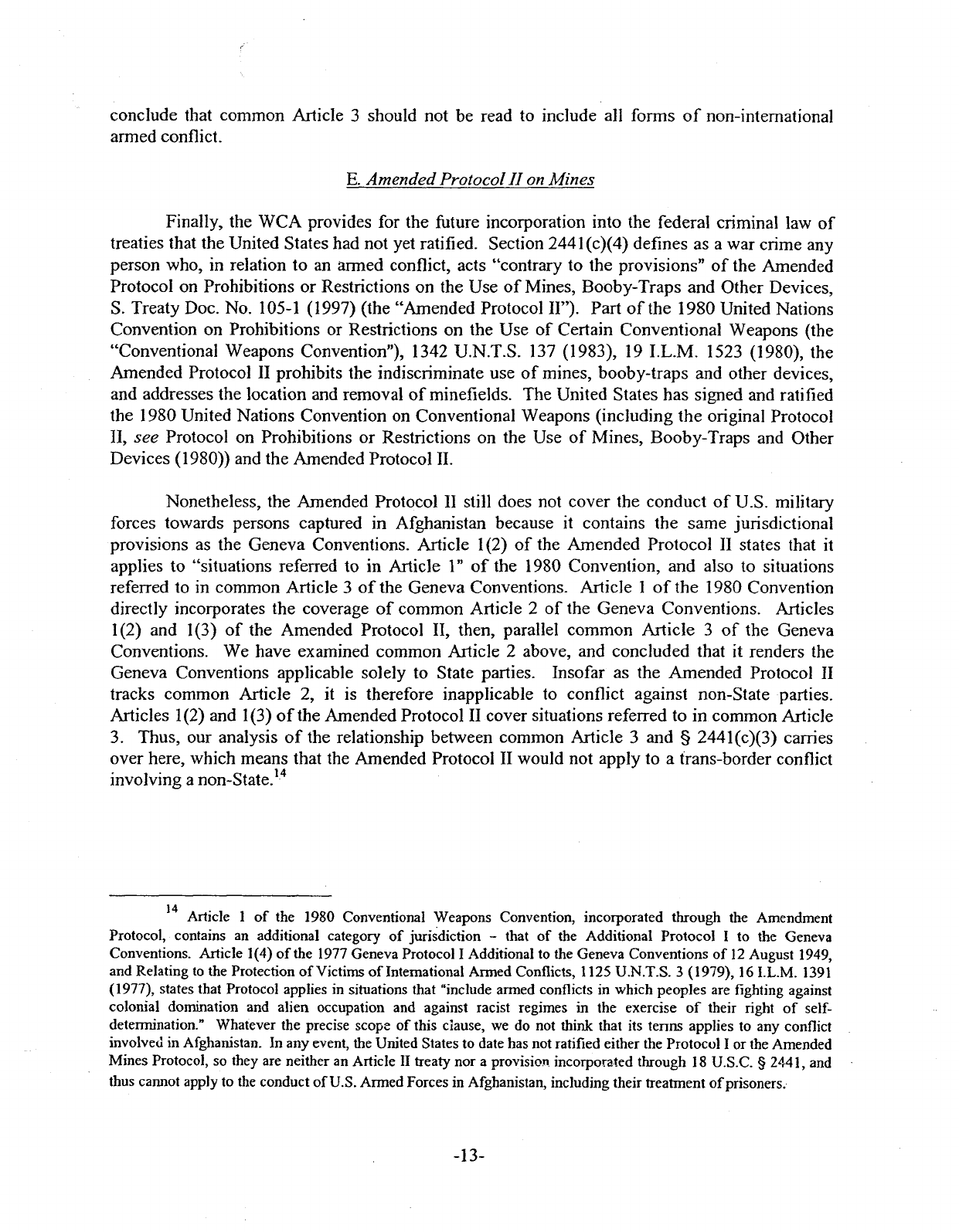
conclude that common
Article
3 should not be read to include all forms of non-international
armed
conflict.
E.
Amended
Protocol
II on
Mines
Finally,
the WCA provides for the future incorporation into the federal
criminal
law of
treaties
that the
United
States
had not yet
ratified.
Section 2441(c)(4) defines as a war crime any
person who, in relation to an armed
conflict,
acts
"contrary to the provisions" of the Amended
Protocol
on Prohibitions or Restrictions on the Use of
Mines,
Booby-Traps and Other Devices,
S. Treaty Doc. No. 105-1 (1997) (the "Amended Protocol
II").
Part of the 1980
United
Nations
Convention
on Prohibitions or Restrictions on the Use of Certain Conventional
Weapons
(the
"Conventional
Weapons
Convention"), 1342
U.N.T.S.
137 (1983), 19
I.L.M.
1523 (1980), the
Amended Protocol II prohibits the indiscriminate use of mines, booby-traps and other devices,
and
addresses
the location and removal of
minefields.
The
United
States
has signed and
ratified
the 1980
United
Nations Convention on Conventional
Weapons
(including
the
original
Protocol
II,
see Protocol on Prohibitions or Restrictions on the Use of Mines, Booby-Traps and Other
Devices (1980)) and the Amended Protocol
II .
Nonetheless, the Amended Protocol II
still
does
not cover the conduct of
U.S.
military
forces towards
persons
captured in Afghanistan
because
it contains the
same
jurisdictional
provisions as the Geneva Conventions.
Article
1(2) of the Amended Protocol II
states
that it
applies to "situations referred to in
Article
1" of the 1980 Convention, and
also
to situations
referred to in common
Article
3 of the Geneva Conventions.
Article
1 of the 1980 Convention
directly
incorporates the
coverage
of common
Article
2 of the Geneva Conventions.
Articles
1(2)
and 1(3) of the Amended Protocol
II,
then, parallel common
Article
3 of the Geneva
Conventions. We
have
examined common
Article
2 above, and concluded that it
renders
the
Geneva Conventions applicable solely to
State
parties. Insofar as the Amended Protocol I I
tracks common
Article
2, it is therefore inapplicable to
conflict
against
non-State
parties.
Articles
1(2) and 1(3)
of
the Amended Protocol
II
cover situations referred to in common
Article
3. Thus, our analysis of the relationship between common
Article
3 and § 2441(c)(3) carries
over
here,
which
means
that the Amended Protocol
I I
would
not apply to a trans-border
conflict
involving
a non-State.
14
Article
1 of the 1980 Conventional Weapons Convention, incorporated through the Amendment
Protocol, contains an additional category of jurisdiction - that of the Additional Protocol I to the Geneva
Conventions. Article 1(4) of the 1977 Geneva Protocol I Additional to the Geneva Conventions of 12 August 1949,
and
Relating to the Protection of
Victims
of
International
Armed Conflicts, 1125
U.N.T.S.
3 (1979), 16
I.L.M.
1391
(1977),
states
that Protocol applies in situations that "include armed conflicts in which
peoples
are fighting against
colonial domination and alien occupation and against racist regimes in the exercise of their right of
self-
determination." Whatever the precise
scope
of this clause, we do not think that its terms applies to any conflict
involved in Afghanistan. In any
event,
the United States to
date
has not ratified either the Protocol I or the Amended
Mines Protocol, so
they
are neither an Article II treaty nor a provision incorporated through 18
U.S.C.
§ 2441, and
thus cannot apply to the conduct of
U.S.
Armed Forces in Afghanistan, including their treatment of prisoners.
-13-

II.
Application of
WCA
and Associated
Treaties
to al Qaeda
It
is clear
from
the foregoing that members of the al
Qaeda
terrorist organization do not
receive the protections
of
the laws
of
war,
and
hence
that actions taken by the U.S.
Armed
Forces
with
respect
to captured members of al
Qaeda
are not covered by the WCA. There are four
reasons,
examined in detail below, that support this conclusion. First, al
Qaeda's
status
as a non-
State
actor
renders
it
ineligible
to
claim
the protections of the treaties specified in the WCA.
Second, the nature of the
conflict
precludes application of common
Article
3 of the Geneva
Conventions.
Third,
al
Qaeda
members
fail
to satisfy the
eligibility
requirements for treatment
as POWs under Geneva Convention
III.
Fourth, even if al
Qaeda
were covered, its conduct on
September
11,
i f
not
before, removes any Hague Convention protections its members might
have
had.
First,
al Qaeda's status as a non-State actor renders it ineligible to claim
the
protections
of
the treaties
specified
by the WCA. A l
Qaeda
is not a
State.
It is a non-governmental terrorist
organization
composed of members
from
many nations,
with
ongoing operations in
dozens
of
nations, who
seem
united in
following
a radical brand of Islam that
seeks
to attack Americans
throughout the
world.
No non-governmental organizations are, or could be, parties to any of the
international
agreements
here
governing the laws of
war.
Thus, al
Qaeda
is not
eligible
to sign
the Hague Convention IV or the Geneva Conventions
—
and even i f it were
eligible,
it has not
done so. As a result, the U.S.
military's
treatment of
al
Qaeda
members is not governed by the
Hague Convention
IV,
which
by its terms
explicitly
applies
only
to the
High
Contracting Parties
to
the
agreement.
Further, al
Qaeda
cannot
claim
the protections of the
bulk
of the Geneva
Conventions, whose
scope
in common
Article
2 is
limited
only
to
cases
of declared war or armed
conflict
"between two or more of the
High
Contracting Parties." Conduct towards captured
members of al
Qaeda,
therefore, cannot constitute a
violation
of 18 U.S.C. § 2441(c)(1) or §
2441(c)(2).
It
might be argued, however,
with
respect
to the Hague Convention IV, that the WCA
does
not simply incorporate the terms of the treaty itself,
with
all of their limitations on
application,
but instead criminalizes the conduct described by that Convention. The argument
starts
from
the fact that there is a textual difference in the way that the WCA
references
treaty
provisions.
Section 2441(c)(2) defines as a war crime conduct "prohibited" by the relevant
sections
of
the Hague Convention
IV.
By contrast, § 2441
(c)(1)
makes
a war crime any conduct
that is a "grave breach" of the Geneva Conventions, and § 2441(c)(3) prohibits conduct
"which
constitutes a
violation"
of common
Article
3 of the Geneva Convention. It might be argued that
this
difference indicates that § 2441(c)(2)
does
not incorporate the treaty into federal law; rather,
it
prohibits the conduct
described
by the treaty. Section 2441(c)(3) prohibits conduct
"which
constitutes a violation of common
Article
3" (emphasis added), and that can
only
be conduct
which
is a treaty
violation.
Likewise, § 2441(c)(1)
only
criminalizes conduct that is a "grave
breach" of the Geneva Conventions -
which,
again, must be treaty
violations.
In other words, §
2441(c)(2)
might be read to apply even when the Hague Convention
IV,
by its own terms,
would
not.
On this interpretation, an act could violate § 2441(c)(2), whether or not the Hague
Convention
IV
applied to the specific situation at
issue.
-14-

We
do not
think
that this interpretation is tenable. To begin
with,
§ 2441(c)(2)
makes
clear that to be a war crime, conduct must be "prohibited" by the Hague Convention IV
(emphasis added). Use of the
word
"prohibited," rather than
phrases
such as "referred to" or
"described," indicates that the treaty must, by its own operation, proscribe the conduct at
issue.
I f
the Hague Convention IV
does
not
itself
apply to a certain
conflict,
then it cannot
itself
proscribe
any conduct undertaken as part of that
conflict.
Thus, the most natural reading of the statutory
language is that an
individual
must violate the Hague Convention IV in order to violate Section
2441(c)(2).
Had
Congress
intended broadly to
criminalize
the types
of
conduct proscribed by the
relevant Hague Convention IV provisions as such, rather than as treaty
violations,
it could
have
done so more clearly. Furthermore, the
basic
purpose of § 2441 was to implement, by
appropriate legislation, the
United
States'
treaty obligations. That purpose
would
be
accomplished by
criminalizing
acts
that were also violations of certain key provisions of the
Annex
to Hague Convention IV. It
would
not be served by
criminalizing
acts
of the kind
condemned by
those
provisions, whether or not they were treaty
violations.
1 5
Second,
the nature
of
the conflict precludes application of the common
Article
3 of the
Geneva
Conventions. Al
Qaeda
is not covered by common
Article
3,
which
does
not apply to
the current
conflict.
As discussed in Part I, the text of
Article
3, when read in harmony
with
common
Article
2, shows that the Geneva Conventions were intended to cover either: a)
traditional
wars between Nation
States
(Article
2), or non-international
civil
wars
(Article
3).
Our
conflict
with
al
Qaeda
does
not fit into either category. That
conflict
is not an international
war
between Nation
States,
but rather a
conflict
between a
Nation
State
and a non-governmental
organization.
At the
same
time, the
conflict
is not a
civil
war under
Article
3,
because
it is a
conflict
of "an international character," rather than an internal armed
conflict
between parties
contending for control over a government or
territory.
Therefore, the
military's
treatment of al
Qaeda
members captured in that
conflict
is not
limited
either by common
Article
3
of
the Geneva
Conventions or 18 U.S.C. § 2441(c)(3), the
provision
of
the
WCA
incorporating that article.
This
understanding is supported by the WCA's legislative history. When extending the
WCA
to cover violations of common
Article
3, the House apparently understood that it was
codifying
treaty provisions that
"forbid
atrocities occurring in both
civil
wars and wars between
nations." 143 Cong. Rec. H5865-66 (remarks of
Rep.
Jenkins). The
Senate
also understood that
"[t]he
inclusion of
common
article 3 of the Geneva Conventions ... expressly allows the
United
States
to prosecute war crimes perpetrated in nonintemational conflicts, such as Bosnia and
Rwanda." 143 Cong. Rec. S7544, S7589
(daily
ed. July 16, 1997) (remarks of Sen. Leahy). In
referring
to Bosnia and Rwanda, both
civil
wars of a non-international character,
Senator
Leahy
appears
to
have
understood common
Article
3 as covering
only
civil
wars as
well.
Thus,
Congress
apparently believed that the WCA
would
apply
only
to traditional international wars
between
States,
or purely internal
civil
wars.
Nothing in the legislative history supports the
opposite
result. To the contrary, the legislative history
suggests
an entirely different explanation for the minor variations in language
between
§§ 2441(c)(1) and
2441(c)(2). As originally enacted, the
WCA
criminalized violations of the Geneva Conventions. See Pub.
L.
No.
104-192, § 2(a), 110 Stat. 2104, § 2401 (1996). In signing the original legislation, President
Clinton
urged that it be
expanded to include other serious war crimes involving violation of the Hague Conventions I V and the Amended
Protocol II. See 2 Pub. Papers of
William
J. Clinton 1323 (1996). The Expanded War
Crimes
Act of 1997,
introduced as
H.R.
1348 in the 105
th
Congress, was designed to
meet
these
requests.
Thus,
§ 2441(c)(2) was added
as an amendment at a later time, and was not drafted at the same time and in the same process as § 2441(c)(1).
-15-
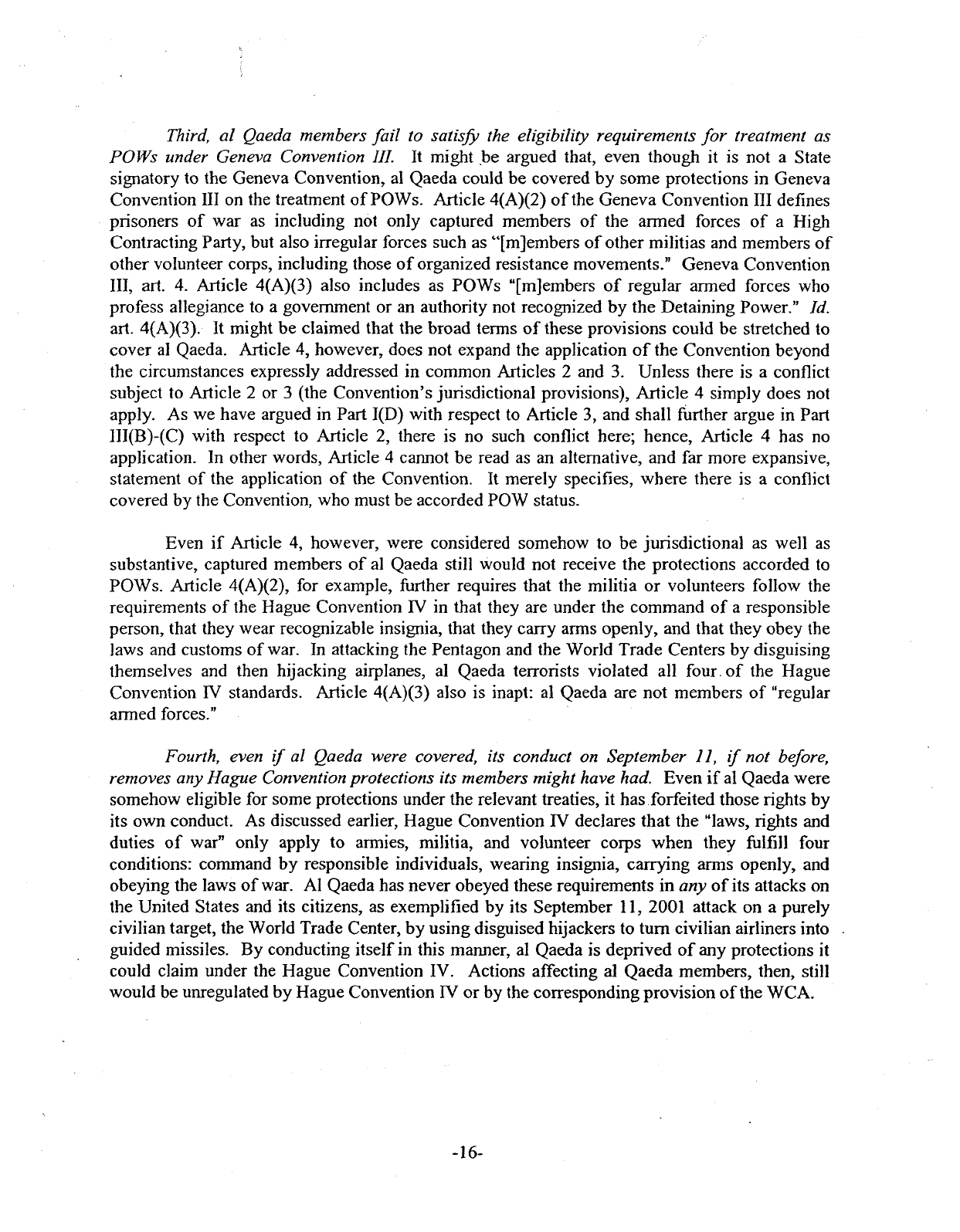
Third,
al Qaeda members
fail
to satisfy the
eligibility
requirements for treatment as
POWs
under Geneva Convention III. It
might
be argued that, even though it is not a
State
signatory
to the Geneva Convention, al
Qaeda
could
be covered by
some
protections in Geneva
Convention
III
on the treatment of
POWs.
Article
4(A)(2)
of
the
Geneva Convention
III
defines
prisoners of war as
including
not
only
captured members of the armed forces of a
High
Contracting
Party, but also irregular forces such as "[m]embers of other
militias
and members of
other volunteer corps,
including
those
of organized resistance movements." Geneva Convention
III,
art. 4.
Article
4(A)(3)
also includes as POWs "[m]embers of regular armed forces who
profess allegiance to a government or an authority not recognized by the Detaining Power." Id.
art.
4(A)(3).
It
might
be claimed that the broad terms of
these
provisions
could
be stretched to
cover al
Qaeda.
Article
4, however,
does
not expand the application of the Convention beyond
the circumstances expressly
addressed
in common
Articles
2 and 3. Unless there is a
conflict
subject to
Article
2 or 3 (the Convention's
jurisdictional
provisions),
Article
4
simply
does
not
apply.
As we have argued in Part
1(D)
with
respect to
Article
3, and shall further argue in Part
III(B)-(C)
with
respect to
Article
2, there is no such
conflict
here; hence,
Article
4 has no
application.
In other words,
Article
4 cannot be read as an alternative, and far more expansive,
statement of the application of the Convention. It merely specifies, where there is a
conflict
covered by the
Convention,
who must be accorded POW status.
Even
i f
Article
4, however, were considered somehow to be
jurisdictional
as
well
as
substantive, captured members of al
Qaeda
still
would
not receive the protections accorded to
POWs.
Article
4(A)(2),
for example, further requires that the
militia
or volunteers
follow
the
requirements of the Hague Convention IV in that they are under the command of a responsible
person, that they wear recognizable insignia, that they carry arms openly, and that they obey the
laws
and customs of
war.
In attacking the Pentagon and the
World
Trade Centers by disguising
themselves and then
hijacking
airplanes, al
Qaeda
terrorists violated all
four,
of the Hague
Convention
IV standards.
Article
4(A)(3)
also is inapt: al
Qaeda
are not members of "regular
armed forces."
Fourth,
even if al Qaeda were covered, its conduct on September II, if not before,
removes
any Hague
Convention
protections its members might have had. Even
i f
al
Qaeda
were
somehow
eligible
for
some
protections under the relevant treaties, it has
forfeited
those
rights by
its
own conduct. As discussed earlier, Hague Convention IV declares that the "laws, rights and
duties of war"
only
apply to armies,
militia,
and volunteer corps when they
fulfill
four
conditions:
command by responsible
individuals,
wearing insignia, carrying arms openly, and
obeying
the laws of
war.
Al
Qaeda
has never obeyed
these
requirements in any of
its
attacks on
the
United
States
and its citizens, as
exemplified
by its September 11, 2001 attack on a purely
civilian
target, the
World
Trade Center, by using disguised hijackers to
turn
civilian
airliners
into
guided
missiles. By conducting
itself
in
this manner, al
Qaeda
is deprived of any protections it
could
claim
under the Hague Convention IV. Actions affecting al
Qaeda
members, then,
still
would
be unregulated by Hague Convention IV or by the corresponding
provision
of
the
WCA.
-16-
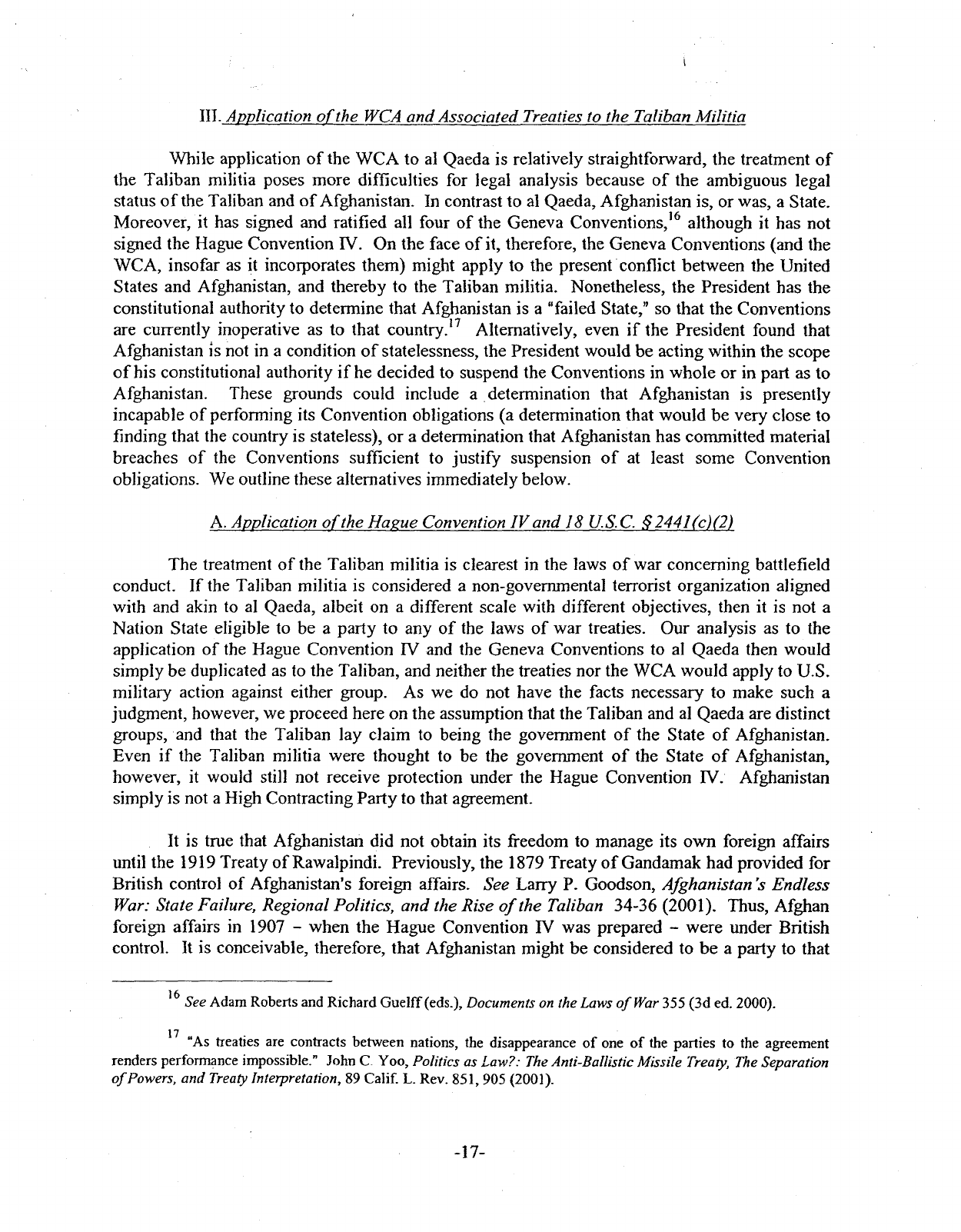
III.
Application
of
the WCA and Associated Treaties to the Taliban
Militia
While
application of the WCA to al
Qaeda
is relatively straightforward, the treatment of
the Taliban
militia
poses
more
difficulties
for legal analysis
because
of the ambiguous legal
status
of the Taliban and of Afghanistan. In contrast to al
Qaeda,
Afghanistan is, or was, a
State.
Moreover, it has signed and
ratified
all four of the
Geneva
Conventions,
16
although it has not
signed the
Hague
Convention
IV.
On the
face
of
it,
therefore, the
Geneva
Conventions (and the
WCA,
insofar as it incorporates them) might apply to the
present
conflict between the United
States
and Afghanistan, and thereby to the Taliban
militia.
Nonetheless,
the
President
has the
constitutional
authority to determine that Afghanistan is a "failed
State,"
so that the Conventions
are currently inoperative as to that country.
17
Alternatively, even if the
President
found that
Afghanistan is not in a condition of
statelessness,
the
President
would be acting
within
the
scope
of
his constitutional authority
i f
he decided to
suspend
the Conventions in whole or in part as to
Afghanistan.
These
grounds could include a determination that Afghanistan is presently
incapable of performing its Convention obligations (a determination that would be very
close
to
finding
that the country is
stateless),
or a determination that Afghanistan has committed material
breaches
of the Conventions sufficient to
justify
suspension
of at
least
some
Convention
obligations. We outline
these
alternatives immediately below.
A.
Application
of
the Hague Convention IV and 18 U.S.C. § 2441(c)(2)
The treatment of the Taliban
militia
is
clearest
in the laws of war concerning battlefield
conduct. I f the Taliban
militia
is considered a non-governmental terrorist organization aligned
with
and akin to al
Qaeda,
albeit on a different
scale
with
different objectives, then it is not a
Nation
State
eligible to be a party to any of the laws of war treaties. Our analysis as to the
application
of the
Hague
Convention IV and the
Geneva
Conventions to al
Qaeda
then would
simply
be duplicated as to the Taliban, and neither the
treaties
nor the WCA would apply to U.S.
military
action
against
either group. As we do not
have
the facts
necessary
to
make
such a
judgment, however, we proceed
here
on the assumption that the Taliban and al
Qaeda
are distinct
groups, and that the Taliban lay claim to being the government of the
State
of Afghanistan.
Even if the Taliban
militia
were thought to be the government of the
State
of Afghanistan,
however, it would
still
not receive protection
under
the
Hague
Convention IV. Afghanistan
simply
is not a
High
Contracting Party to that
agreement.
It
is true that Afghanistan did not obtain its freedom to
manage
its own foreign affairs
until
the 1919 Treaty of
Rawalpindi.
Previously, the 1879 Treaty of
Gandamak
had provided for
British
control of Afghanistan's foreign affairs. See Larry P. Goodson, Afghanistan's
Endless
War: State
Failure,
Regional
Politics,
and the
Rise
of
the Taliban 34-36 (2001). Thus, Afghan
foreign
affairs in 1907 - when the
Hague
Convention IV was prepared - were
under
British
control.
It is conceivable, therefore, that Afghanistan might be considered to be a party to that
1 6
See Adam Roberts and
Richard
Guelff
(eds.), Documents on the Laws of
War
355 (3d ed. 2000).
1 7
"As treaties are contracts
between
nations, the disappearance of one of the parties to the
agreement
renders performance impossible." John C Yoo, Politics as Law?:
The
Anti-Ballistic Missile
Treaty,
The
Separation
of
Powers, and
Treaty
Interpretation,
89
Calif.
L .
Rev. 851, 905 (2001).
-17-
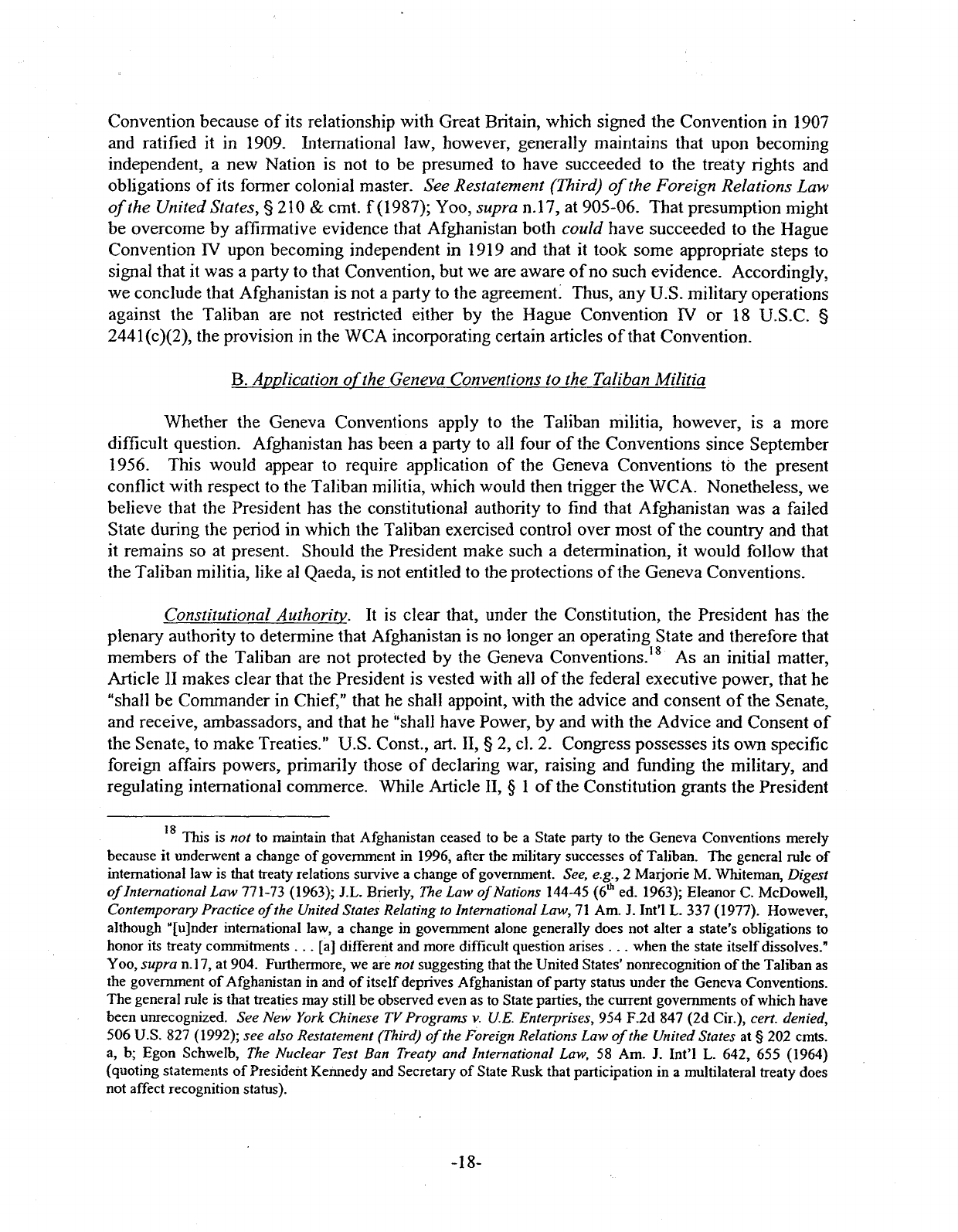
Convention
because
of its relationship
with
Great
Britain,
which
signed the Convention in 1907
and
ratified
it in 1909. International law, however, generally maintains that upon becoming
independent, a new Nation is not to be presumed to
have
succeeded
to the treaty rights and
obligations
of its former colonial
master.
See Restatement
(Third)
of
the
Foreign
Relations Law
of
the
United
States, § 210 & cmt. f
(1987);
Yoo,
supra n.17, at 905-06. That presumption might
be overcome by affirmative evidence that Afghanistan both
could
have
succeeded
to the Hague
Convention
TV
upon becoming independent in 1919 and that it took
some
appropriate
steps
to
signal
that it was a party to that Convention, but we are aware
of
no such evidence.
Accordingly,
we conclude that Afghanistan is not a party to the
agreement.
Thus, any U.S.
military
operations
against the Taliban are not restricted either by the Hague Convention TV or 18 U.S.C. §
2441(c)(2),
the
provision
in the WCA incorporating certain articles
of
that Convention.
B.
Application
of
the Geneva Conventions to the
Taliban
Militia
Whether the Geneva Conventions apply to the Taliban
militia,
however, is a more
difficult
question. Afghanistan has
been
a party to all four of the Conventions since September
1956. This
would
appear
to require application of the Geneva Conventions to the
present
conflict
with
respect
to the Taliban
militia,
which
would
then trigger the
WCA.
Nonetheless, we
believe that the President has the constitutional authority to
find
that Afghanistan was a
failed
State
during the period in
which
the Taliban exercised control over most of the country and that
it
remains so at
present.
Should the President make such a determination, it
would
follow
that
the Taliban
militia,
like
al
Qaeda,
is not entitled to the protections
of
the Geneva Conventions.
Constitutional
Authority. It is clear that, under the Constitution, the President has the
plenary authority to determine that Afghanistan is no longer an operating
State
and therefore that
members of the Taliban are not protected by the Geneva Conventions. As an
initial
matter,
Article
II
makes
clear that the President is vested
with
all of the federal executive power, that he
"shall
be Commander in Chief," that he shall appoint,
with
the advice and consent of the
Senate,
and receive,
ambassadors,
and that he "shall
have
Power, by and
with
the Advice and Consent of
the
Senate,
to make Treaties." U.S. Const., art.
II ,
§ 2,
cl.
2.
Congress
possesses
its own specific
foreign
affairs powers,
primarily
those
of declaring war, raising and funding the
military,
and
regulating
international commerce.
While
Article
II,
§ 1 of the Constitution grants the President
This
is not to maintain that Afghanistan ceased to be a State party to the Geneva Conventions merely
because it underwent a change of government in 1996, after the military successes of
Taliban.
The general rule of
international
law is that treaty relations survive a change of government. See, e.g., 2
Marjorie
M. Whiteman,
Digest
of
International Law
771-73
(1963);
J.L.
Brierly,
The
Law
of
Nations
144-45
(6
th
ed. 1963);
Eleanor
C.
McDowell,
Contemporary Practice
of
the United
States
Relating to
International
Law, 71 Am.
J.
Int'l
L.
337 (1977). However,
although "[u]nder international law, a change in government alone generally
does
not alter a
state's
obligations to
honor its treaty commitments .. . [a] different and more difficult question arises .. . when the
state
itself dissolves."
Yoo,
supra n.17, at 904.
Furthermore,
we are not
suggesting
that the United States' nonrecognition of the
Taliban
as
the government of Afghanistan in and of itself deprives Afghanistan of
party
status under the Geneva Conventions.
The
general rule is that treaties may still be observed even as to State parties, the current governments of
which
have
been unrecognized. See New
York
Chinese
TV
Programs v. U.E. Enterprises, 954 F.2d 847 (2d
Cir.),
cert,
denied,
506 U.S. 827 (1992); see
also
Restatement
(Third)
of
the Foreign Relations Law
of
the United
States
at § 202 cmts.
a,
b; Egon Schwelb, The Nuclear Test Ban
Treaty
and International Law, 58 Am. J.
Int'l
L. 642, 655 (1964)
(quoting statements of
President
Kennedy and Secretary of State
Rusk
that participation in a multilateral treaty
does
not affect recognition status).
-18-

an undefined executive power,
Article
I ,
§ 1
limits
Congress
to
"[a]ll
legislative Powers herein
granted" in the
rest
of
Article
I.
From
the very beginnings of the Republic, this constitutional arrangement has
been
understood to grant the President plenary control over the conduct of foreign relations. As
Secretary of
State
Thomas Jefferson observed during the
first
Washington
Administration:
"The
constitution
has
divided
the powers
of
government into three
branches
[and]...
has declared that
'the executive powers shall be vested in the President,'
submitting
only
special articles of
it
to a
negative by the
senate."
Thomas Jefferson, Opinion on the
Powers
of the Senate Respecting
Diplomatic
Appointments (1790), reprinted in 16 The
Papers
of
Thomas
Jefferson
378 (Julian P.
Boyd
ed., 1961). Due to this structure, Jefferson continued,
"[t]he
transaction of
business
with
foreign
nations is Executive altogether. It belongs then to the head of that department, except as
to
such portions of it as are specially submitted to the
Senate.
Exceptions
are to be construed
strictly."
Id. at 379. In defending President Washington's authority to
issue
the Neutrality
Proclamation,
Alexander
Hamilton
came
to the
same
interpretation of the
President's
foreign
affairs
powers.
According
to
Hamilton,
Article
II
"ought... to be considered as intended ... to
specify
and regulate the
principal
articles
implied
in the
definition
of Executive Power, leaving
the
rest
to
flow
from
the general grant of that power." Alexander
Hamilton,
Pacificus No. 1
(1793),
reprinted in 15 The
Papers
of
Alexander
Hamilton 33, 39
(Harold
C. Syrett et al. eds.,
1969).
As future
Chief
Justice John Marshall famously declared a few
years
later, "The
President is the sole organ of the nation in its external relations, and its sole representative
with
foreign
nations. .
*.
. The [executive] department .. . is entrusted
with
the whole foreign
intercourse of the nation...." 10 Annals of Cong. 613-14 (1800). Given the agreement of
Jefferson,
Hamilton,
and
Marshall,
it has not
been
difficult
for the executive branch consistently
to
assert
the
President's
plenary authority in foreign affairs ever since.
On
the few occasions where it has
addressed
the question, the Supreme Court has lent its
approval
to the executive branch's broad powers in the
field
of
foreign
affairs. Responsibility for
the conduct of foreign affairs and for protecting the national security are, as the Supreme Court
has observed, "'central' Presidential domains."
Harlow
v.
Fitzgerald,
457 U.S. 800, 812 n.19
(1982).
The
President's
constitutional primacy
flows
from
both his unique position in the
constitutional
structure, and
from
the specific grants of authority in
Article
II that make the
President both the
Chief
Executive of the nation and the Commander in Chief. Nixon v.
Fitzgerald,
457 U.S. 731, 749-50 (1982). Due to the
President's
constitutionally superior
position,
the Supreme Court has consistently "recognized 'the generally accepted
view
that
foreign
policy
[is]
the province and responsibility of the Executive.'" Department
of
the Navy v.
Egan,
484 U.S. 518, 529 (1988) (quoting
Haig
v. Agee, 453 U.S. 280, 293-94 (1981)). This
foreign
affairs power is independent of Congress: it is "the very delicate, plenary and exclusive
power of the President as sole organ of the federal government in the
field
of international
relations - a power
which
does
not require as a
basis
for its exercise an act of Congress."
United
States
v.
Curtiss-
Wright
Export
Corp.,
299 U.S. 304, 320 (1936).
Part of the
President's
plenary power over the conduct of the Nation's foreign relations is
the interpretation of treaties and of
international
law. Interpretation of
international
law includes
the determination whether a
territory
has the
necessary
political
structure to
qualify
as a Nation
State
for
purposes
of treaty implementation. In
Clark
v.
Allen,
331 U.S. 503 (1947), for
-19-
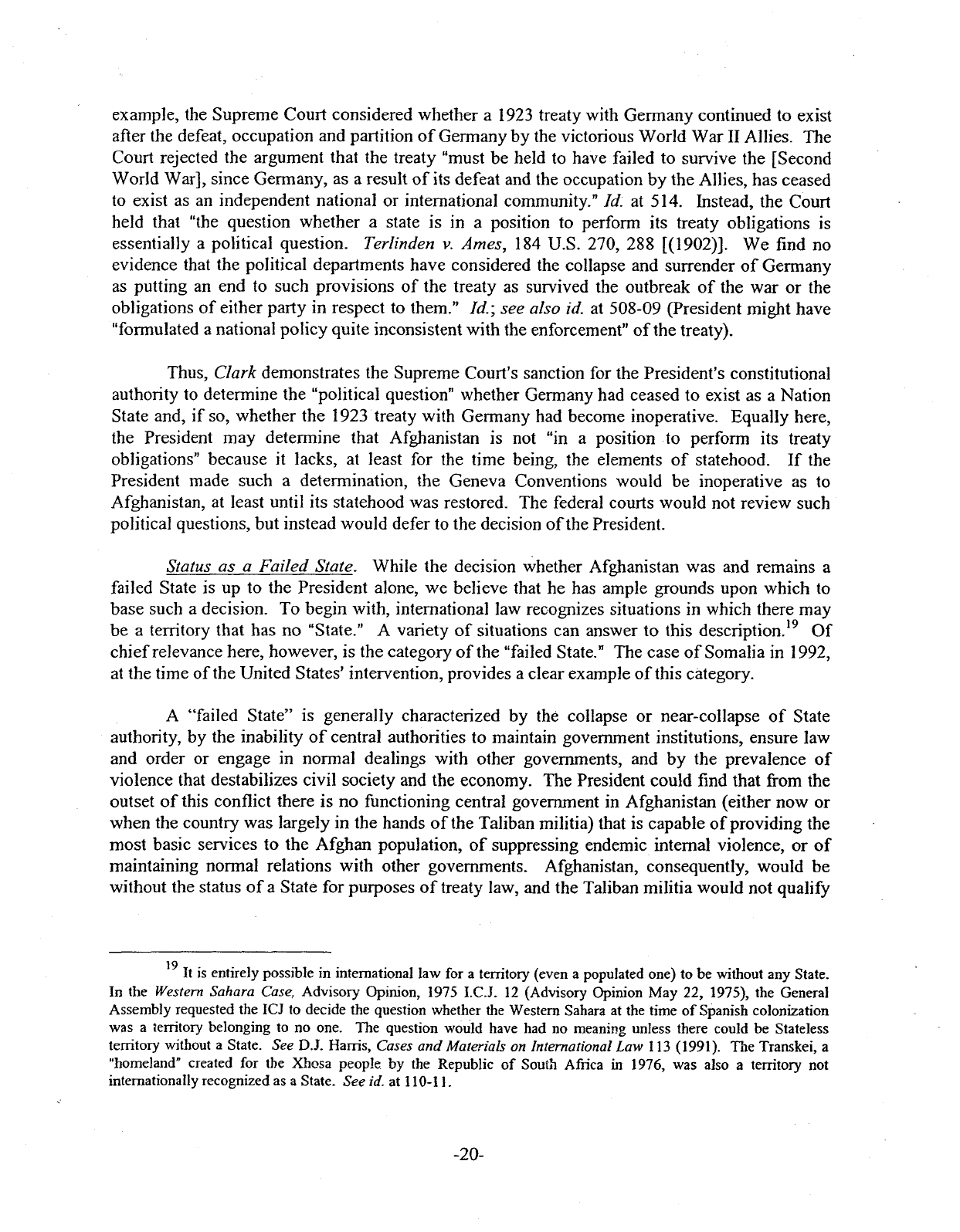
example, the Supreme Court considered whether a 1923 treaty
with
Germany continued to exist
after the defeat, occupation and
partition
of Germany by the
victorious
World
War
II
Allies.
The
Court
rejected the argument that the treaty "must be held to have
failed
to survive the [Second
World
War],
since Germany, as a result of
its
defeat and the occupation by the
Allies,
has
ceased
to
exist as an independent national or international
community."
Id. at 514. Instead, the Court
held
that "the question whether a
state
is in a position to perform its treaty obligations is
essentially a
political
question.
Terlinden
v. Ames, 184 U.S. 270, 288
[(1902)].
We
find
no
evidence that the
political
departments have considered the collapse and surrender of Germany
as
putting
an end to such provisions of the treaty as survived the outbreak of the war or the
obligations
of either party in respect to them." Id.; see
also
id. at 508-09 (President
might
have
"formulated
a national
policy
quite inconsistent
with
the enforcement"
of
the treaty).
Thus,
Clark
demonstrates the Supreme Court's sanction for the President's constitutional
authority
to determine the
"political
question" whether Germany had
ceased
to exist as a
Nation
State
and, i f so, whether the 1923 treaty
with
Germany had become inoperative. Equally here,
the President may determine that Afghanistan is not "in a position to perform its treaty
obligations"
because
it lacks, at least for the time being, the elements of statehood. If the
President made such a determination, the Geneva Conventions
would
be inoperative as to
Afghanistan,
at least
until
its statehood was restored. The federal courts
would
not review such
political
questions, but instead
would
defer to the decision
of
the President.
Status
as a
Failed
State.
While
the decision whether Afghanistan was and remains a
failed
State
is up to the President alone, we believe that he has ample grounds upon
which
to
base
such a decision. To begin
with,
international law recognizes situations in
which
there may
be a
territory
that has no "State." A variety of situations can answer to this description.
19
Of
chief
relevance here, however, is the category of the
"failed
State." The
case
of Somalia in 1992,
at the time
of
the
United
States'
intervention,
provides a clear example of
this
category.
A
"failed
State" is generally characterized by the collapse or near-collapse of
State
authority,
by the
inability
of central authorities to maintain government institutions,
ensure
law
and order or
engage
in normal dealings
with
other governments, and by the prevalence of
violence
that destabilizes
civil
society and the economy. The President
could
find
that
from
the
outset of
this
conflict
there is no
functioning
central government in Afghanistan (either now or
when
the country was largely in the
hands
of the Taliban
militia)
that is capable
of
providing
the
most basic services to the
Afghan
population, of suppressing endemic internal violence, or of
maintaining
normal relations
with
other governments. Afghanistan, consequently,
would
be
without
the
status
of
a
State
for
purposes
of treaty law, and the Taliban
militia
would
not
qualify
It
is entirely possible in international law for a territory (even a populated one) to be without any State.
In
the Western Sahara Case, Advisory Opinion, 1975
I.C.J.
12 (Advisory Opinion May 22, 1975), the
General
Assembly
requested the
ICJ
to decide the question whether the Western
Sahara
at the time of
Spanish
colonization
was a territory belonging to no one. The question would have had no meaning unless there could be Stateless
territory
without a State. See
D.J.
Harris,
Cases and Materials on
International
Law 113 (1991). The
Transkei,
a
"homeland" created for the Xhosa
people
by the Republic of South
Africa
in 1976, was also a territory not
internationally
recognized as a State. See id. at 110-11.
-20-
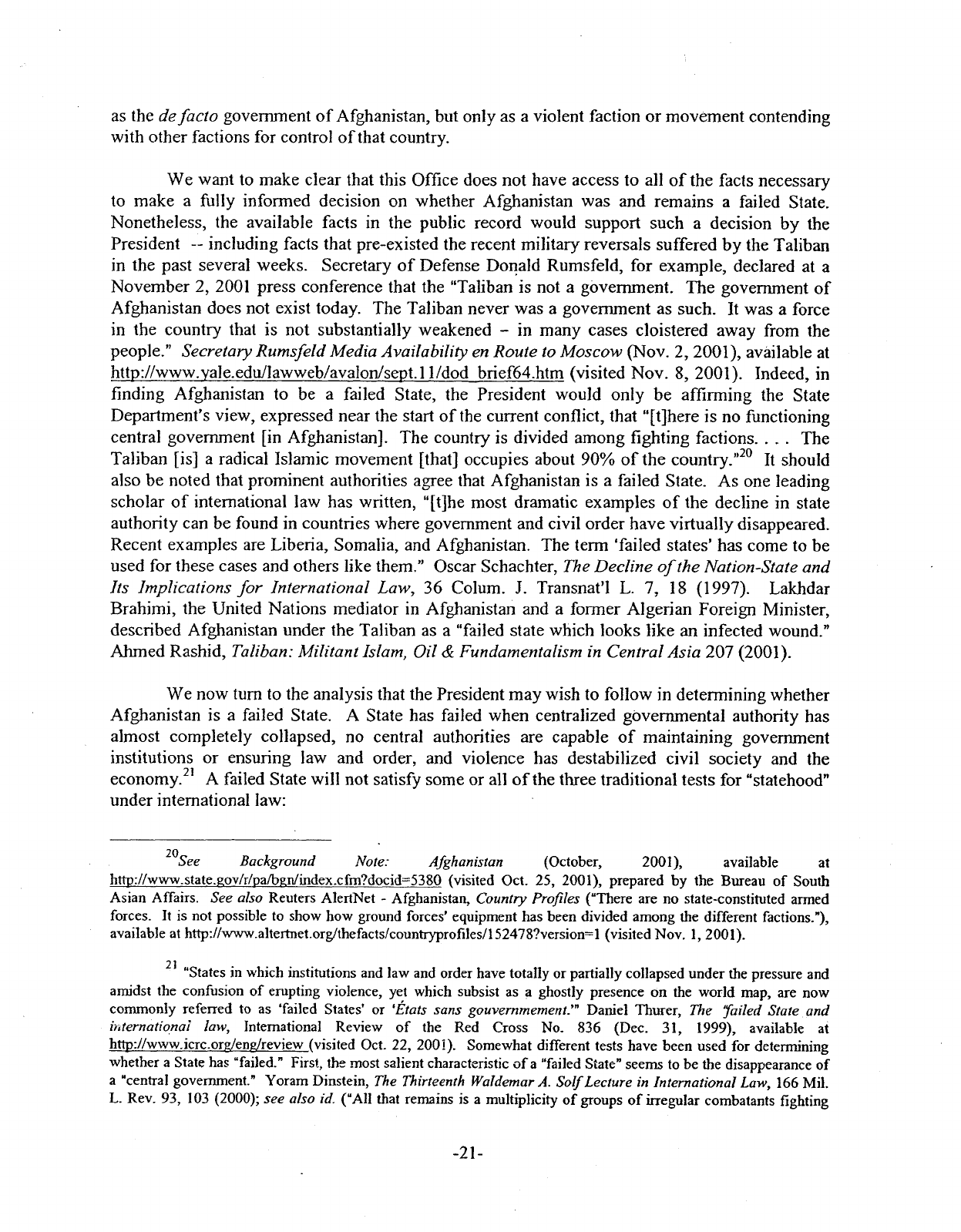
as the de
facto
government of
Afghanistan,
but
only
as a violent faction or movement contending
with
other factions for control
of
that country.
We
want to make clear that this
Office
does
not
have
access
to all of the facts
necessary
to
make a
fully
informed decision on whether Afghanistan was and remains a
failed
State.
Nonetheless, the available facts in the public record
would
support such a decision by the
President
—
including
facts that pre-existed the recent
military
reversals suffered by the Taliban
in
the
past
several weeks. Secretary of Defense Donald Rumsfeld, for example, declared at a
November 2, 2001
press
conference that the "Taliban is not a government. The government of
Afghanistan
does
not exist today. The Taliban never was a government as such. It was a force
in
the country that is not substantially weakened - in many
cases
cloistered away
from
the
people." Secretary Rumsfeld
Media
Availability en Route to Moscow
(Nov.
2, 2001), available at
http://www.yale.edU/lawweb/avalon/sept.l1/dod_brief64.htm
(visited
Nov. 8, 2001).
Indeed,
in
finding
Afghanistan to be a
failed
State,
the President
would
only
be
affirming
the
State
Department's
view,
expressed
near
the start of the current
conflict,
that "[t]here is no functioning
central government [in Afghanistan]. The country is
divided
among
fighting
factions. . . . The
Taliban
[is] a radical Islamic movement
[that]
occupies about 90% of the country."
20
It should
also be noted that prominent authorities
agree
that Afghanistan is a
failed
State.
As one leading
scholar of international law has
written,
"[t]he
most dramatic examples of the decline in
state
authority
can be found in countries where government and
civil
order
have
virtually
disappeared.
Recent examples are
Liberia,
Somalia, and Afghanistan. The term
'failed
states'
has come to be
used for
these
cases
and others
like
them."
Oscar
Schachter,
The
Decline
of
the Nation-State and
Its
Implications for International Law, 36 Colum. J. Transnat'l L. 7, 18 (1997). Lakhdar
Brahimi,
the
United
Nations mediator in Afghanistan and a former
Algerian
Foreign Minister,
described Afghanistan under the Taliban as a
"failed
state
which
looks
like
an infected wound."
Ahmed
Rashid,
Taliban:
Militant
Islam,
Oil
&
Fundamentalism in
Central
Asia
207 (2001).
We
now
turn
to the analysis that the President may
wish
to
follow
in determining whether
Afghanistan
is a
failed
State.
A
State
has
failed
when centralized governmental authority has
almost completely collapsed, no central authorities are
capable
of maintaining government
institutions
or ensuring law and order, and violence has destabilized
civil
society and the
economy. A
failed
State
will
not satisfy
some
or all
of
the three
traditional
tests
for "statehood"
under
international
law:
See Background
Note:
Afghanistan
(October, 2001), available at
http://www.state.gov/r/pa/bgn/index.cfm?docid=5380 (visited Oct. 25, 2001), prepared by the Bureau of South
Asian
Affairs. See
also
Reuters AlertNet - Afghanistan, Country Profiles ("There are no
state-constituted
armed
forces. It is not
possible
to
show
how ground forces' equipment has
been
divided among the different factions."),
available at
http://www.altertnet.org/thefacts/countryprof1les/l52478?version=l
(visited Nov.
1,2001).
21
"States in which institutions and law and order have totally or partially collapsed under the pressure and
amidst the confusion of erupting violence, yet which subsist as a
ghostly
presence on the world map, are now
commonly referred to as 'failed States' or 'Etats
sans
gouvernmement."
Daniel
Thurer,
The
'failed
State
and
international
law, International Review of the Red Cross No. 836 (Dec. 31, 1999), available at
http://www.icrc.org/eng/review (visited Oct. 22, 2001). Somewhat different
tests
have
been
used for determining
whether a State has "failed."
First,
the
most
salient characteristic of
a
"failed State"
seems
to be the disappearance of
a
"central government."
Yoram
Dinstein, The Thirteenth
Waldemar
A.
Solf
Lecture
in International Law, 166 Mil.
L .
Rev. 93, 103 (2000); see
also
id. ("All that remains is a multiplicity of groups of
irregular
combatants fighting
-21-
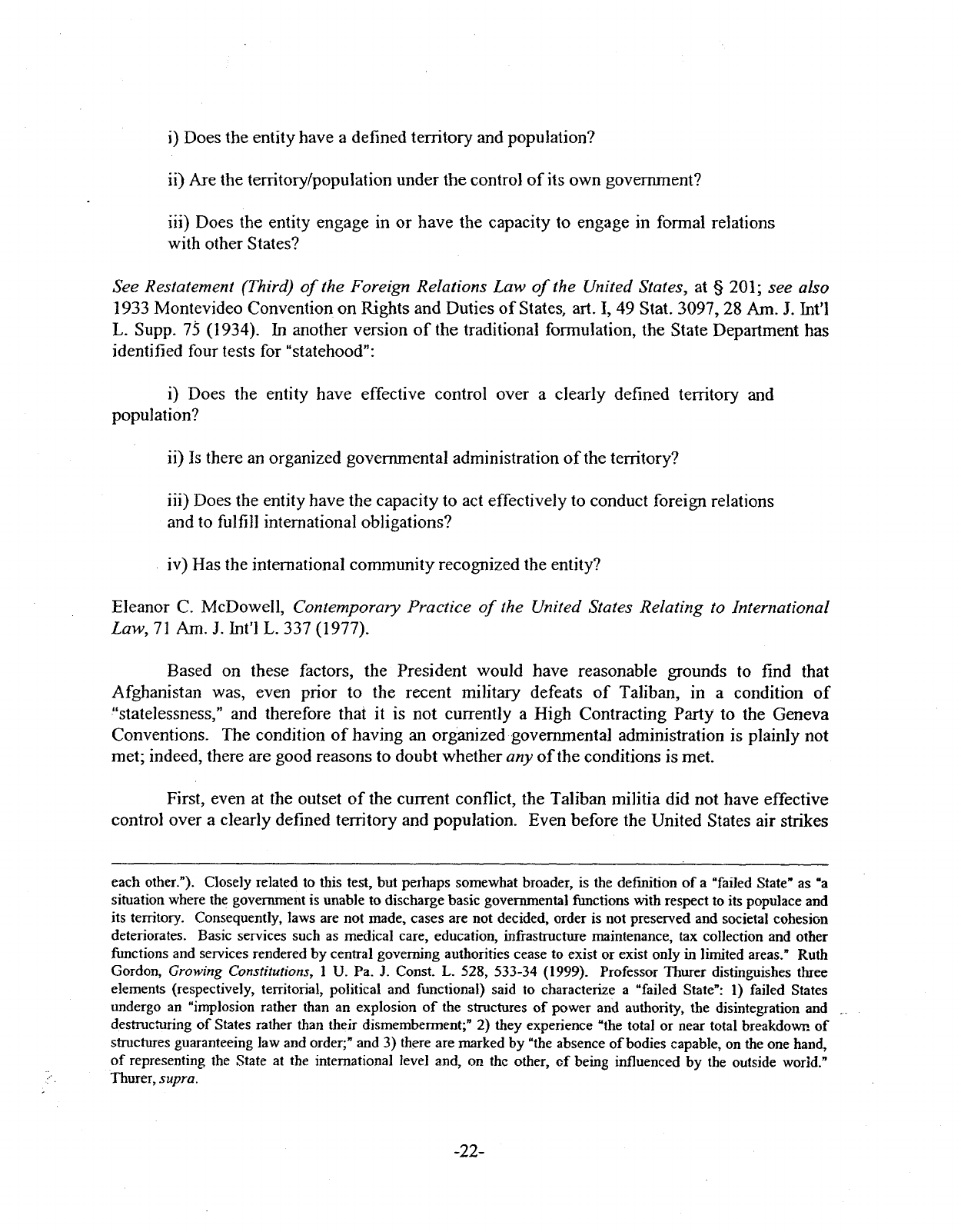
i)
Does the
entity
have
a defined
territory
and population?
ii)
Are the
territory/population
under the
control
of
its
own government?
iii)
Does the entity
engage
in or
have
the capacity to
engage
in
formal
relations
with
other
States?
See
Restatement
(Third)
of
the
Foreign
Relations
Law of
the
United
States, at § 201; see
also
1933 Montevideo Convention on Rights and Duties of
States,
art.
I,
49 Stat. 3097, 28
Am.
J.
Int'l
L.
Supp. 75 (1934). In another version of the
traditional
formulation,
the
State
Department has
identified
four
tests
for "statehood":
i)
Does the entity
have
effective
control
over a clearly defined
territory
and
population?
ii)
Is there an organized governmental
administration
of
the territory?
iii)
Does the entity
have
the capacity to act
effectively
to conduct
foreign
relations
and to
fulfill
international obligations?
iv)
Has the
international
community
recognized the entity?
Eleanor C.
McDowell,
Contemporary
Practice
of the
United
States
Relating
to International
Law,
71
Am.
J.
Int'l
L.
337 (1977).
Based on
these
factors, the President
would
have
reasonable
grounds to
find
that
Afghanistan
was, even
prior
to the recent
military
defeats
of Taliban, in a
condition
of
"statelessness,"
and therefore that it is not currently a
High
Contracting Party to the Geneva
Conventions.
The
condition
of
having
an organized governmental administration is
plainly
not
met; indeed, there are good
reasons
to doubt whether any
of
the conditions is met.
First,
even at the outset of the current
conflict,
the Taliban
militia
did not
have
effective
control
over a clearly defined
territory
and
population.
Even before the
United
States
air strikes
each other."). Closely related to this
test,
but perhaps somewhat broader, is the definition of
a
"failed State" as "a
situation where the government is unable to discharge basic governmental functions with respect to its populace and
its territory. Consequently, laws are not made, cases are not decided, order is not preserved and societal cohesion
deteriorates.
Basic
services such as medical care, education, infrastructure maintenance, tax collection and other
functions and services rendered by
central
governing authorities cease to exist or exist only in limited
areas."
Ruth
Gordon,
Growing Constitutions, 1 U. Pa. J. Const. L. 528,
533-34
(1999). Professor
Thurer
distinguishes three
elements
(respectively,
territorial,
political and functional) said to characterize a "failed State": 1) failed States
undergo an "implosion rather than an explosion of the structures of power and authority, the disintegration and
destructuring
of States rather than their dismemberment;" 2) they experience "the total or near total breakdown of
structures
guaranteeing law and
order;"
and 3) there are
marked
by "the absence of
bodies
capable, on the one hand,
of representing the State at the international level and, on the other, of being influenced by the outside world."
Thurer,
supra.
-22-
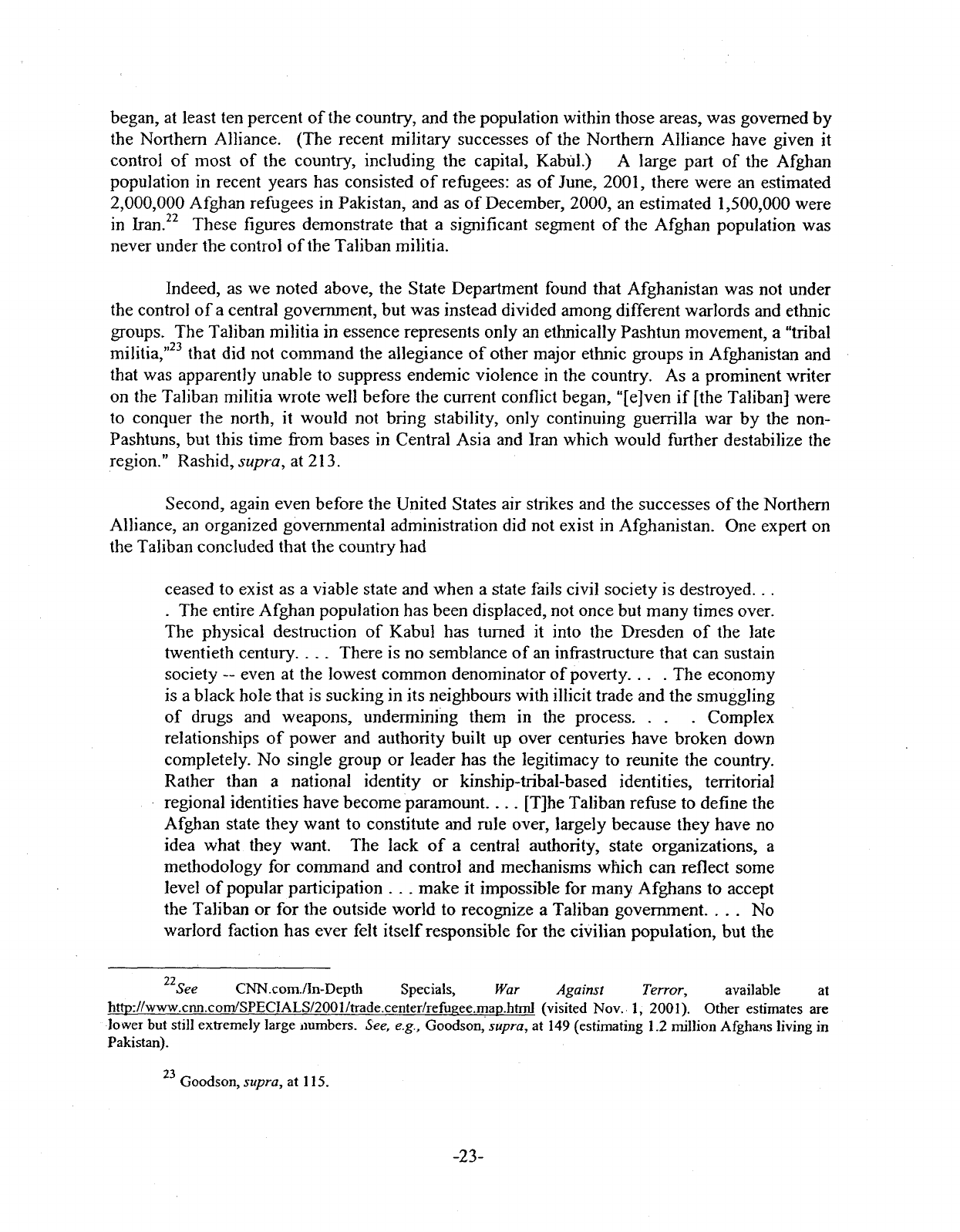
began, at
least
ten percent
of
the country, and the population
within
those
areas,
was governed by
the Northern
Alliance.
(The recent
military
successes
of the Northern
Alliance
have
given it
control
of most of the country,
including
the capital,
Kabul.)
A large part of the Afghan
population
in recent
years
has consisted of refugees: as of
June,
2001, there were an estimated
2,000,000 Afghan
refugees
in Pakistan, and as of December, 2000, an estimated
1,500,000
were
*
22
in
Iran.
These
figures demonstrate that a significant
segment
of the Afghan population was
never under the control of the Taliban
militia.
Indeed, as we noted above, the
State
Department found that Afghanistan was not under
the control of
a
central government, but was instead
divided
among different warlords and ethnic
groups. The Taliban
militia
in
essence
represents
only
an
ethnically
Pashtun movement, a
"tribal
militia,"
that did not command the allegiance of other major ethnic groups in Afghanistan and
that was apparently unable to
suppress
endemic violence in the country. As a prominent
writer
on
the Taliban
militia
wrote
well
before the current
conflict
began, "[e]ven i f [the Taliban] were
to
conquer the north, it
would
not
bring
stability,
only
continuing guerrilla war by the non-
Pashtuns,
but this time
from
bases
in Central Asia and
Iran
which
would
further destabilize the
region."
Rashid, supra, at 213.
Second, again even before the
United
States
air strikes and the
successes
of the Northern
Alliance,
an organized governmental administration did not exist in Afghanistan. One expert on
the Taliban concluded that the country had
ceased
to exist as a viable
state
and when a
state
fails
civil
society is destroyed...
.
The entire Afghan population has
been
displaced, not
once
but many times over.
The physical destruction of
Kabul
has turned it into the Dresden of the late
twentieth
century. . . . There is no semblance of an infrastructure that can sustain
society
—
even at the lowest common denominator of
poverty.
. . . The economy
is
a black hole that is sucking in its neighbours
with
illicit
trade and the smuggling
of
drugs and weapons, undermining them in the
process.
. . . Complex
relationships of power and authority
built
up over centuries
have
broken down
completely.
No single group or leader has the legitimacy to reunite the country.
Rather than a national identity or kinship-tribal-based identities,
territorial
regional
identities
have
become paramount....
[T]he
Taliban refuse to define the
Afghan
state
they want to constitute and rule over, largely
because
they
have
no
idea what they want. The lack of a central authority,
state
organizations, a
methodology
for command and control and mechanisms
which
can reflect
some
level
of popular
participation
. . . make it impossible for many Afghans to
accept
the Taliban or for the outside
world
to recognize a Taliban government.... No
warlord
faction has ever
felt
itself
responsible for the
civilian
population, but the
See CNN.com./In-Depth Specials, War Against Terror, available at
http://www.crmxom/SPECIALS/2001/rradexenter/refugee.map.hrrnl
(visited Nov. 1, 2001). Other estimates are
lower but still extremely large numbers. See, e.g., Goodson, supra, at 149 (estimating 1.2 million Afghans living in
Pakistan).
23
Goodson, supra, at 115.
-23-
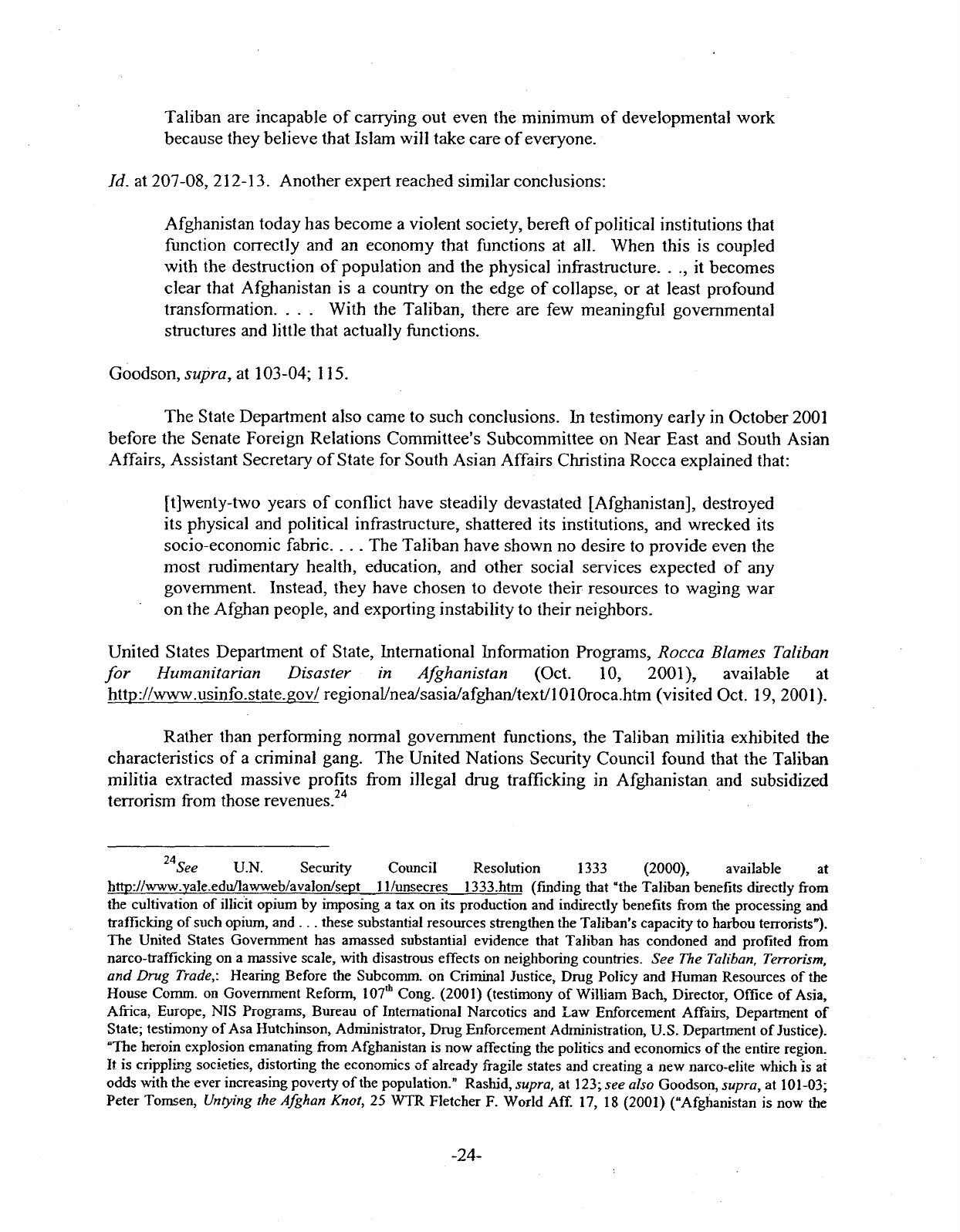
Taliban
are incapable of
carrying
out even the
minimum
of developmental
work
because
they believe that Islam
will
take
care
of
everyone.
Id.
at 207-08, 212-13. Another expert reached
similar
conclusions:
Afghanistan
today has become a violent society, bereft
of
political
institutions
that
function
correctly and an economy that functions at all. When this is coupled
with
the destruction of
population
and the physical infrastructure..., it
becomes
clear that Afghanistan is a country on the
edge
of collapse, or at
least
profound
transformation....
With
the Taliban, there are few meaningful governmental
structures and
little
that actually functions.
Goodson, supra, at 103-04; 115.
The
State
Department also
came
to such conclusions. In testimony early in October 2001
before the
Senate
Foreign Relations Committee's Subcommittee on Near
East
and South Asian
Affairs,
Assistant Secretary of
State
for South Asian
Affairs
Christina Rocca explained that:
[t]wenty-two
years
of
conflict
have
steadily devastated [Afghanistan], destroyed
its
physical and
political
infrastructure, shattered its institutions, and wrecked its
socio-economic fabric. . . . The Taliban
have
shown no desire to provide even the
most rudimentary health, education, and other social services expected of any
government. Instead, they
have
chosen to devote their
resources
to waging war
on
the Afghan people, and exporting
instability
to their neighbors.
United
States
Department of
State,
International
Information
Programs,
Rocca
Blames
Taliban
for
Humanitarian
Disaster
in Afghanistan (Oct. 10, 2001), available at
http://www.usinfo.state.gov/
regional/nea/sasia/afghan/text/lOlOroca.htm
(visited
Oct. 19, 2001).
Rather than performing normal government functions, the Taliban
militia
exhibited the
characteristics of a
criminal
gang. The
United
Nations Security Council found that the Taliban
militia
extracted massive profits
from
illegal
drug
trafficking
in Afghanistan and subsidized
terrorism
from
those
revenues.
24
See U.N. Security
Council
Resolution 1333 (2000), available at
http://www.yale.edu/lawweb/avalon/sept 11/unsecres 1333.htm (finding that "the
Taliban
benefits
directly from
the cultivation of illicit opium by imposing a tax on its production and indirectly
benefits
from the processing and
trafficking
of
such
opium, and .. .
these
substantial resources strengthen the
Taliban's
capacity to harbou
terrorists").
The
United States Government has amassed substantial evidence that
Taliban
has condoned and profited from
narco-trafficking
on a massive scale, with disastrous
effects
on neighboring countries. See The
Taliban,
Terrorism,
and Drug Trade,: Hearing Before the Subcomm. on
Criminal
Justice, Drug Policy and Human Resources of the
House Comm. on Government Reform, 107th Cong. (2001) (testimony of
William
Bach,
Director, Office of
Asia,
Africa,
Europe, NIS Programs, Bureau of International Narcotics and Law Enforcement Affairs, Department of
State; testimony of
Asa
Hutchinson,
Administrator,
Drug Enforcement
Administration,
U.S. Department of
Justice).
"The
heroin explosion emanating from Afghanistan is now affecting the politics and economics of the entire region.
It
is crippling societies, distorting the economics of already fragile
states
and creating a new narco-elite which is at
odds
with the ever increasing poverty of the population."
Rashid,
supra, at 123; see
also
Goodson, supra, at 101-03;
Peter Tomsen, Untying the
Afghan
Knot, 25
WTR
Fletcher
F.
World Aff. 17, 18 (2001) ("Afghanistan is now the
-24-

Third,
the Taliban
militia
was arguably unable to conduct normal foreign relations or to
fulfill
its international legal obligations. Indeed,
information
available to the President might
justify
him in
finding
that the Taliban had become so subject to the domination and control of
al
Qaeda
that it could not pursue independent policies
with
respect
to the outside
world.
2 5
Certainly,
publicly
known facts demonstrate that the Taliban was
unwilling
and
perhaps
unable
to
obey its international obligations and to conduct normal diplomatic relations. Thus, the
Taliban
has consistently refused to comply
with
United
Nations Security Council Resolutions
1333 (2000) and 1267 (1999),
which
called on it to surrender
Osama
bin Laden to justice and to
take other actions to
abate
terrorism
based
in Afghanistan.
26
Those resolutions also called on all
States
to deny permission for aircraft to take off or to land
i f
they were owned or operated by or
for
the Taliban, and to freeze funds and other
resources
owned or
controlled
by the
Taliban.
The
Taliban
also reportedly refused or was unable to extradite bin Laden at the
request
of Saudi
Arabia
in
September,
1998, despite close relations between the Saudi government and itself. As
a result, the Saudi government expelled the Afghan charge
d'affaires?
27
The Taliban's
continuing
role in sheltering and supporting
those
believed to be responsible for the terrorist
attacks of September 11, 2001
places
it in clear breach of
international
law,
which
requires it to
prevent the use of
its
territory
as a launching pad for attacks against another
Nation.
28
world's largest producer of
opium.").
Iran
is estimated to have as many as three million drug addicts, largely as a
result
of
Taliban's
involvement in the drug trade.
Rashid,
supra, at 122, 203.
25
See, e.g-, "2 U.S. Targets Bound by
Fate,"
The
Washington
Post at A22 (Nov. 14, 2001) ("According to
Thomas
Gouttierre, an Afghan expert at the University of
Nebraska
and a former UN adviser, the so-called Afghan
Arabs
surrounding bin
Laden
were much more educated and articulate than the
often
illiterate
Taliban
and
succeeded in convincing them that they were at the head of
a
world-wide Islamic renaissance. 'Al Qaeda ended up
hijacking
a large part of the
Taliban
movement,' he said, noting that
[Taliban
supreme religious leader Mohammed]
Omar
and bin
Laden
were 'very, very tight' by 1998."); "Bin
Laden
Paid
Cash
For
Taliban,"
The
Washington
Post
at A l (Nov. 30, 2001) (reporting claims by former
Taliban
official of
al
Qaeda's corruption of
Taliban
officials).
2 6
U.N. Security
Council
Resolution 1333 "strongly condemned]" the
Taliban
for the "sheltering and
training
of terrorists and [the] planning of terrorist acts," and "deplor[ed] the fact that the
Taliban
continues to
provide a safe haven to Usama bin
Laden
and to allow him and others associated with him to operate a network of
terrorist
training camps from Taliban-controlled territory and to use Afghanistan as a base from which to sponsor
international
terrorist operations." U.N. Security
Council
Resolution 1214,
U
13 (1998) enjoined the
Taliban
to
stop
providing a sanctuary and training for terrorists. U.N. Security
Council
Resolution 1267,
%
2 (1999), stated that the
Taliban's
failure to comply with the Council's 1998 demand constituted a threat to the peace. See Sean D. Murphy,
Efforts
to Obtain Custody
of
Osama Bin Laden, 94
Am.
J.
Int'l
L.
366 (2000).
27
See
Yossef
Bodansky,
Bin Laden:
The
Man
Who
Declared
War
on
America
301-02
(2001).
28
See Robert
F.
Turner,
International Law and the Use
of
Force
in Response to the World Trade Center
and Pentagon Attacks, available at http://iurist.law.pitt.edu/forumnew/34.htm (visited Oct. 25, 2001) ("If (as has
been claimed by the US and UK governments) bin
Laden
masterminded the attacks on New
York
and Washington,
Afghanistan is in breach of its
state
responsibility to take reasonable measures to prevent its territory from being
used to launch attacks against other states. The United States and its allies thus have a legal right to violate
Afghanistan's territorial integrity to destroy bin
Laden
and related terrorist targets. If the
Taliban
elects
to join
forces with bin
Laden,
it, too,
becomes
a lawful target."); see
also
W. Michael Reisman, International Legal
Responses to Terrorism, 22 Hous.
J.
Int'l
L.3,
40-42, 51-54 (1999).
-25-
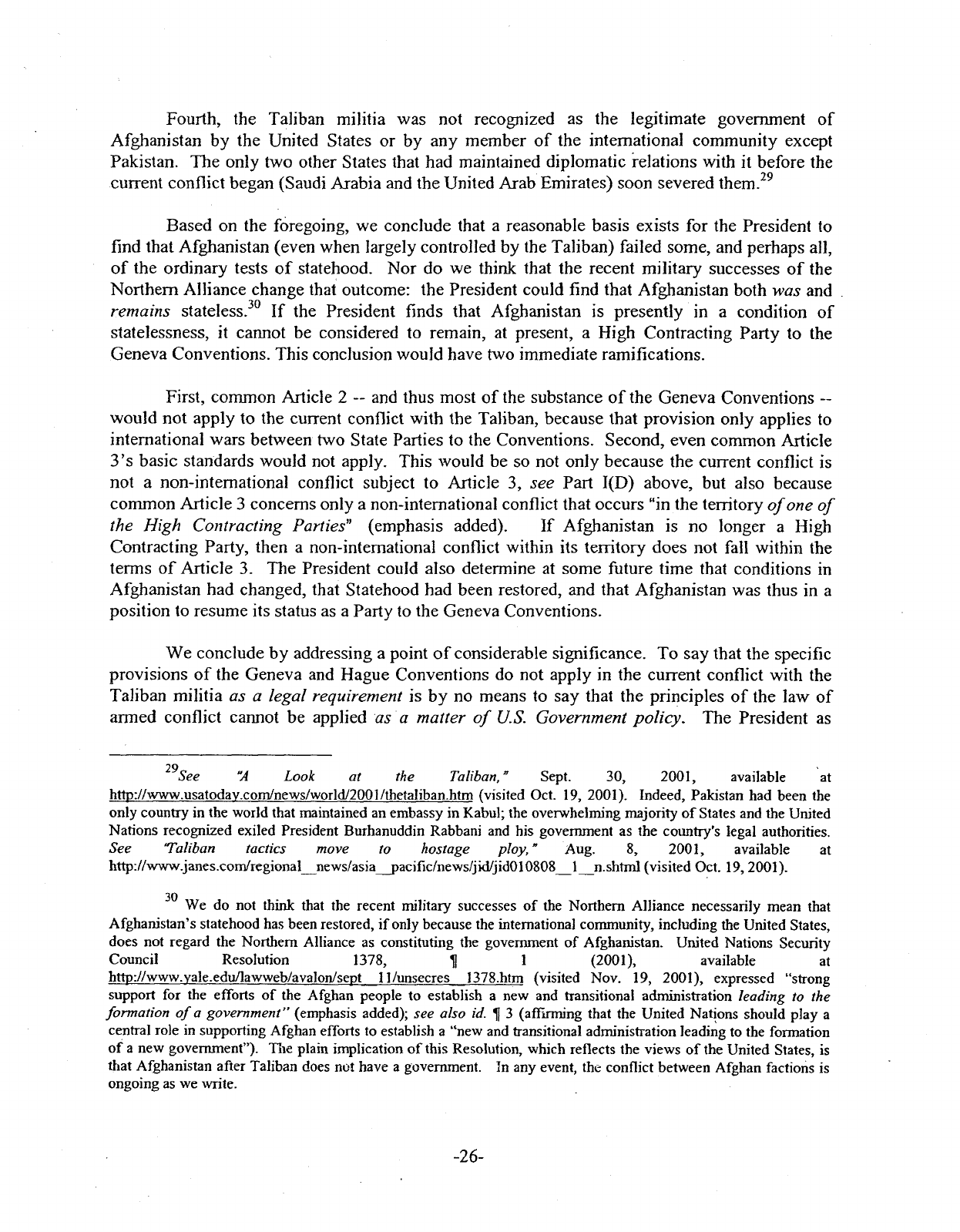
Fourth,
the Taliban
militia
was not recognized as the legitimate government of
Afghanistan
by the
United
States
or by any member of the international community except
Pakistan. The
only
two other
States
that had maintained diplomatic relations
with
it before the
current
conflict
began (Saudi Arabia and the
United
Arab Emirates) soon severed them.
2 9
Based on the foregoing, we conclude that a
reasonable
basis
exists for the President to
find
that Afghanistan (even when largely
controlled
by the Taliban)
failed
some, and
perhaps
all,
of
the ordinary
tests
of statehood. Nor do we
think
that the recent
military
successes
of the
Northern
Alliance
change
that outcome: the President could
find
that Afghanistan both was and
remains
stateless.
I f the President finds that Afghanistan is presently in a condition of
statelessness,
it cannot be considered to remain, at
present,
a
High
Contracting Party to the
Geneva Conventions. This conclusion
would
have
two immediate ramifications.
First,
common
Article
2
—
and thus most of the
substance
of the Geneva Conventions
—
would
not apply to the current
conflict
with
the Taliban,
because
that provision
only
applies to
international
wars between two
State
Parties to the Conventions. Second, even common
Article
3's
basic
standards
would
not apply. This
would
be so not
only
because
the current
conflict
is
not
a non-international
conflict
subject to
Article
3, see Part 1(D) above, but also
because
common
Article
3 concerns
only
a non-international
conflict
that occurs
"in
the
territory
of
one of
the
High
Contracting
Parties"
(emphasis added). I f Afghanistan is no longer a
High
Contracting
Party, then a non-international
conflict
within
its
territory
does
not
fall
within
the
terms of
Article
3. The President could also determine at
some
future time that conditions in
Afghanistan
had changed, that Statehood had
been
restored, and that Afghanistan was thus in a
position
to
resume
its
status
as a Party to the Geneva Conventions.
We
conclude by addressing a point of considerable significance. To say that the specific
provisions
of the Geneva and Hague Conventions do not apply in the current
conflict
with
the
Taliban
militia
as a
legal
requirement is by no
means
to say that the principles of the law of
armed
conflict
cannot be applied as a matter of
U.S.
Government policy. The President as
See "A Look at the Taliban," Sept. 30, 2001, available at
http://www.usatoday.com/news/world/2001/thetaliban.htrn (visited Oct. 19, 2001). Indeed, Pakistan had been the
only country in the world that maintained an embassy in
Kabul;
the overwhelming majority of States and the United
Nations recognized exiled President Burhanuddin Rabbani and his government as the country's legal authorities.
See Taliban
tactics
move
to
hostage
ploy,"
Aug. 8, 2001, available at
http://www.janes.com/regional_news/asia pacific/news/jid/jid010808_1_n.shtml (visited Oct. 19, 2001).
30
We
do not think that the recent military successes of the Northern Alliance necessarily mean that
Afghanistan's statehood has been restored, if only because the international community, including the United States,
does
not regard the Northern Alliance as constituting the government of Afghanistan. United Nations Security
Council
Resolution 1378, U 1 (2001), available at
http://www.yale.edu/lawweb/avalon/sept_11/unsecres 1378.htm (visited Nov. 19, 2001), expressed "strong
support for the efforts of the Afghan
people
to establish a new and transitional administration leading to the
formation
of a
government"
(emphasis added); see
also
id.
K
3 (affirming that the United Nations should play a
central
role in supporting Afghan efforts to establish a "new and transitional administration leading to the formation
of
a
new government"). The plain implication of this Resolution, which reflects the views of the United States, is
that Afghanistan after
Taliban
does
not have a government. In any event, the conflict
between
Afghan factions is
ongoing
as we write.
-26-

Commander in
Chief
can determine as a matter of his judgment for the
efficient
prosecution of
the
military
campaign that the
policy
of the
United
States
will
be to enforce customary
standards
of
the law of war against the Taliban and to punish any transgressions against
those
standards.
Thus,
for example, even though the Geneva Convention
III ,
relating to POWs, may not apply,
the
United
States
may deem it a
violation
of the laws and
usages
of war for Taliban troops to
torture
any American prisoners
whom
they may happen to seize. The U.S.
military
thus
could
prosecute Taliban
militiamen
for war crimes for engaging in such conduct.
31
Similarly,
any
acts
by
al
Qaeda
terrorists either in the
United
States
or abroad that violate the customary laws
of
war
may be prosecuted before a
military
commission. See generally Memorandum for
Alberto
R.
Gonzales, Counsel to the President,
from
Patrick F.
Philbin,
Deputy Assistant Attorney General,
Office
of Legal Counsel, Re:
Legality
of the Use of
Military
Commissions to Try
Terrorists
(Nov.
6, 2001) (the
"Military
Commissions
Memo").
A decision to apply the principles of the
Geneva Conventions or of others laws
of
war
as a matter
of
policy
would
be
fully
consistent
with
the
past
practice
of
the
United
States.
United
States
practice in post-1949 conflicts reveals several instances in
which
our
military
forces have applied the Geneva Conventions as a matter of
policy,
without
acknowledging
any legal
obligation
to do so.
These
cases
include the Wars in Korea and
Vietnam
and the interventions in
Panama
and Somalia.
Korea.
The Korean War broke put on
June
25, 1950, before any of the major
State
parties to the
conflict
(including
the
United
States)
had
ratified
the Geneva Conventions.
Nonetheless, General Douglas
MacArthur,
the
United
Nations Commander in Korea, said that
his
forces
would
comply
with
the principles of the Geneva Conventions,
including
those
relating
to
POWs.
MacArthur
stated: "My present instructions are to abide by the humanitarian
principles
of the 1949 Geneva Conventions,
particularly
common
Article
three. In addition, I
have directed the forces under my command to abide by the detailed provisions of the prisoner-
of-war
convention, since I have the
means
at my disposal to
assure
compliance
with
this
convention
by all concerned and have
fully
accredited the ICRC
delegates
accordingly." Quoted
in
Joseph
P.
Bialke,
United
Nations
Peace
Operations:
Applicable
Norms and
the
Application
of
the Law
of
Armed
Conflict,
50
A.F.L.
Rev. 1, 63 n.235 (2001).
Viet
Nam. The
United
States
through the
State
Department took the position that the
Geneva Convention
III
"indisputably applies to the armed
conflict
in
Viet
Nam," and therefore
that "American
military
personnel captured in the course of that armed
conflict
are entitled to be
treated as prisoners of war." Entitlement
of
American
Military
Personnel
Held
by North Viet-
Nam to Treatment as
Prisoners
of War
Under
the Geneva Convention of 1949
Relative
to the
Treatment
of
Prisoners
of
War,
July 13, 1966,
reprinted
in John
Norton
Moore, Law and the
Indo-China
War 635, 639 (1972). We understand
from
the Defense Department that our
military
forces, as a matter of
policy,
decided at
some
point in the
conflict
to accord POW
treatment (but not necessarily POW status) to
Viet
Cong members, despite the fact that they
The
President could, of
course,
also determine that it
will
be the policy of
the
United States to require its
own troops to adhere to standards of conduct recognized under customary international law, and could prosecute
offenders for violations. As explained above, the President is not bound to follow
these
standards by law, but may
direct
the
armed
forces to adhere to them
as
a matter of policy.
-27-
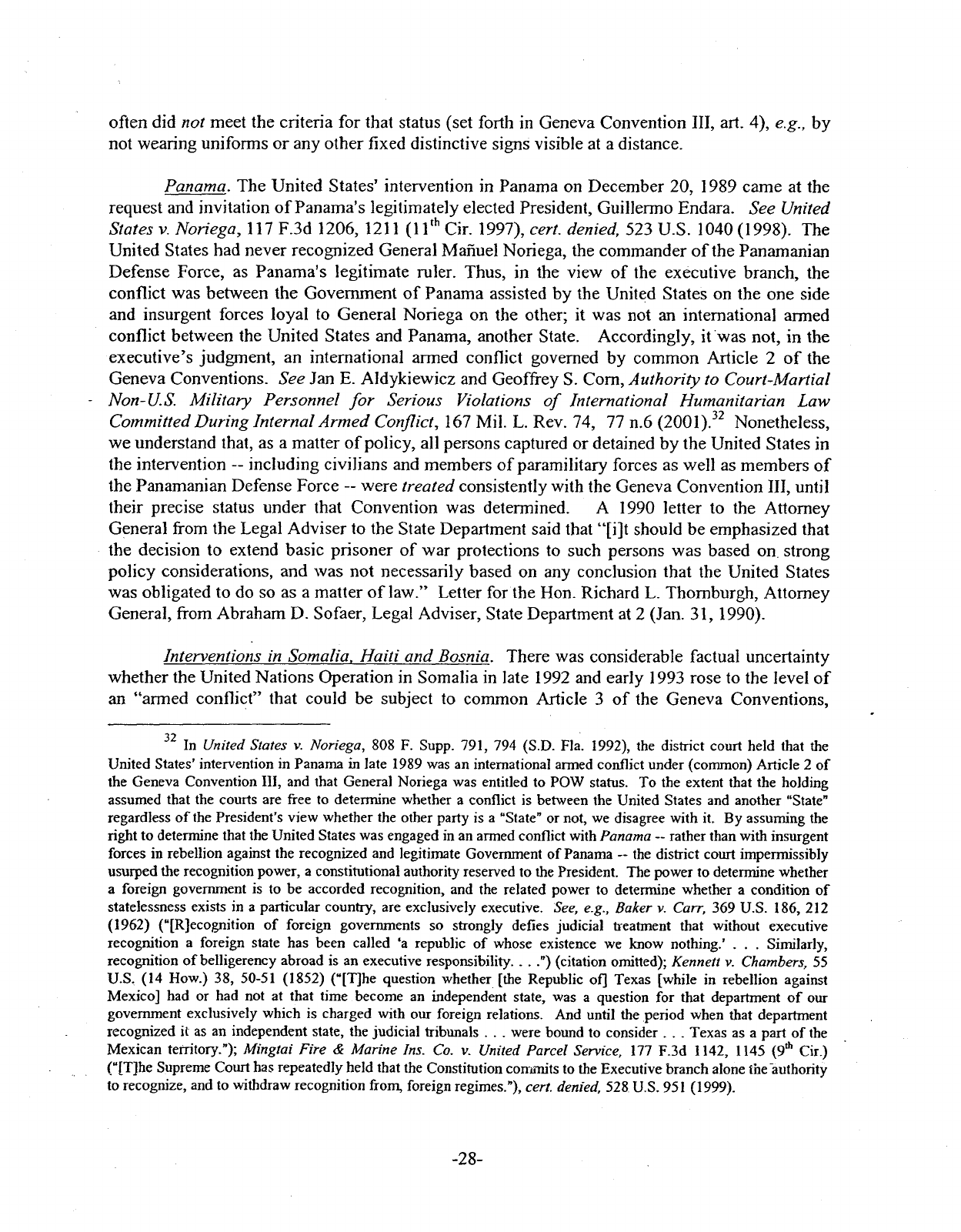
often
did not meet the criteria for that
status
(set
forth
in Geneva Convention
III ,
art. 4), e.g., by
not
wearing uniforms or any other
fixed
distinctive
signs
visible
at a distance.
Panama.
The
United
States'
intervention in
Panama
on December 20, 1989
came
at the
request
and
invitation
of
Panama's
legitimately
elected President,
Guillermo
Endara. See
United
States
v. Noriega, 117 F.3d 1206, 1211
(11
t h
Cir.
1997), cert, denied, 523 U.S. 1040
(1998).
The
United
States
had never recognized General Manuel Noriega, the commander of the Panamanian
Defense Force, as
Panama's
legitimate ruler. Thus, in the
view
of the executive branch, the
conflict
was between the Government of
Panama
assisted
by the
United
States
on the one side
and insurgent forces
loyal
to General Noriega on the other; it was not an international armed
conflict
between the
United
States
and
Panama,
another
State.
Accordingly,
it was not, in the
executive's judgment, an international armed
conflict
governed by common
Article
2 of the
Geneva Conventions. See Jan E.
Aldykiewicz
and Geoffrey S.
Corn,
Authority to
Court-Martial
-
Non-U.S.
Military
Personnel
for
Serious
Violations of International Humanitarian Law
Committed
During
Internal
Armed
Conflict,
167
Mil.
L. Rev. 74, 77 n.6 (2001).
32
Nonetheless,
we
understand that, as a matter of
policy,
all
persons
captured or detained by the
United
States
in
the
intervention
—
including
civilians
and members of
paramilitary
forces as
well
as members of
the Panamanian Defense Force
—
were treated consistently
with
the Geneva Convention
III ,
until
their
precise
status
under that Convention was determined. A 1990 letter to the Attorney
General
from
the Legal Adviser to the
State
Department said that
"[i]t
should be emphasized that
the decision to extend
basic
prisoner of war protections to such
persons
was
based
on strong
policy
considerations, and was not necessarily
based
on any conclusion that the
United
States
was obligated to do so as a matter of
law."
Letter for the
Hon.
Richard L. Thomburgh, Attorney
General,
from
Abraham D. Sofaer, Legal Adviser,
State
Department at 2 (Jan. 31, 1990).
Interventions
in Somalia,
Haiti
and
Bosnia.
There was considerable factual uncertainty
whether the
United
Nations Operation in Somalia in late 1992 and early 1993
rose
to the
level
of
an "armed
conflict"
that
could
be subject to common
Article
3 of the Geneva Conventions,
In
United
States
v. Noriega, 808 F. Supp. 791, 794 (S.D. Fla. 1992), the district court held that the
United
States' intervention in Panama in late 1989 was an international armed conflict under (common) Article 2 of
the Geneva Convention
III,
and that
General
Noriega was entitled to
POW
status. To the
extent
that the holding
assumed that the courts are free to determine whether a conflict is
between
the United States and another "State"
regardless of
the
President's view whether the other party is a "State" or not, we disagree with it. By assuming the
right
to determine that the United States was
engaged
in an armed conflict with Panama
—
rather
than with insurgent
forces in rebellion against the recognized and legitimate Government of
Panama
-- the district court impermissibly
usurped
the recognition power, a constitutional authority reserved to the President. The power to determine whether
a
foreign government is to be accorded recognition, and the related power to determine whether a condition of
statelessness
exists in a
particular
country, are exclusively executive. See, e.g., Baker v. Carr, 369 U.S. 186, 212
(1962) ("[Recognition of foreign governments so strongly
defies
judicial
treatment that without executive
recognition a foreign
state
has been called 'a republic of
whose
existence we know nothing.' . . .
Similarly,
recognition of belligerency abroad is an executive responsibility. . . .") (citation omitted); Kennett v. Chambers, 55
U.S.
(14 How.) 38, 50-51 (1852) ("[T]he question whether [the Republic of] Texas [while in rebellion against
Mexico] had or had not at that time
become
an independent state, was a question for that department of our
government exclusively which is charged with our foreign relations. And until the period when that department
recognized it as an independent state, the
judicial
tribunals .. . were bound to consider .. . Texas as a part of the
Mexican
territory.");
Mingtai
Fire
& Marine Ins. Co. v. United Parcel Service, 177 F.3d 1142, 1145
(9th
Cir.)
("[T]he
Supreme
Court
has repeatedly held that the Constitution commits to the
Executive
branch
alone the authority
to recognize, and to withdraw recognition from, foreign regimes."),
cert,
denied,
528
U.S.
951 (1999).
-28-
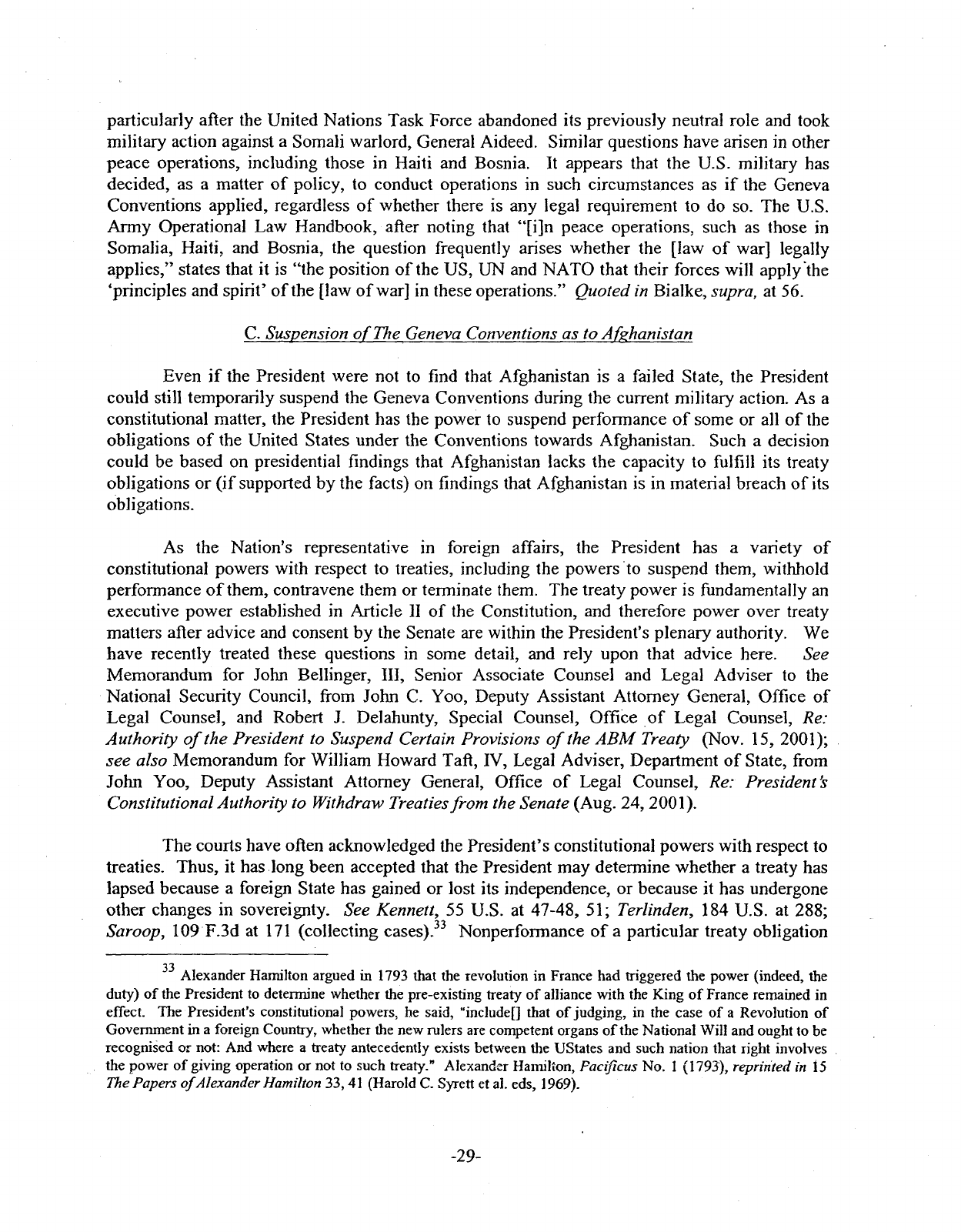
particularly
after the
United
Nations Task Force abandoned its previously neutral role and took
military
action against a Somali
warlord,
General Aideed.
Similar
questions have arisen in other
peace
operations,
including
those
in
Haiti
and Bosnia. It
appears
that the U.S.
military
has
decided, as a matter of
policy,
to conduct operations in such circumstances as if the Geneva
Conventions applied, regardless of whether there is any legal requirement to do so. The U.S.
Army
Operational Law Handbook, after noting that
"[i]n
peace
operations, such as
those
in
Somalia,
Haiti,
and Bosnia, the question frequently
arises
whether the [law of war]
legally
applies,"
states
that it is "the position of the US, UN and
NATO
that their forces
will
apply
"the
'principles
and
spirit'
of
the [law
of war]
in
these
operations." Quoted in
Bialke,
supra,
at 56.
C.
Suspension
of The
Geneva Conventions as to Afghanistan
Even
i f the President were not to
find
that Afghanistan is a
failed
State, the President
could
still
temporarily
suspend the Geneva Conventions during the current
military
action. As a
constitutional
matter, the President has the power to suspend performance of
some
or all of the
obligations
of the
United
States
under the Conventions towards Afghanistan. Such a decision
could
be
based
on presidential findings that Afghanistan lacks the capacity to
fulfill
its treaty
obligations
or
(if
supported by the facts) on findings that Afghanistan is in material breach of its
obligations.
As
the Nation's representative in
foreign
affairs, the President has a variety of
constitutional
powers
with
respect to treaties,
including
the powers to suspend them,
withhold
performance of
them,
contravene them or terminate them. The treaty power is fundamentally an
executive power established in
Article
II of the Constitution, and therefore power over treaty
matters after advice and consent by the
Senate
are
within
the President's plenary
authority.
We
have recently treated
these
questions in
some
detail, and
rely
upon that advice here. See
Memorandum
for John Bellinger,
III ,
Senior Associate Counsel and Legal Adviser to the
National
Security
Council,
from
John C. Yoo, Deputy Assistant Attorney General,
Office
of
Legal
Counsel, and Robert J. Delahunty, Special Counsel,
Office
of Legal Counsel, Re:
Authority
of
the
President
to Suspend
Certain
Provisions
of the ABM Treaty (Nov. 15, 2001);
see
also
Memorandum for
William
Howard
Taft,
IV,
Legal Adviser, Department of State,
from
John Yoo, Deputy Assistant Attorney General,
Office
of Legal Counsel, Re:
President's
Constitutional
Authority to Withdraw
Treaties
from
the Senate
(Aug.
24, 2001).
The courts have often acknowledged the President's
constitutional
powers
with
respect to
treaties. Thus, it has
long
been accepted that the President may determine whether a treaty has
lapsed
because
a
foreign
State
has gained or lost its independence, or
because
it has undergone
other
changes
in sovereignty. See Kennett, 55 U.S. at 47-48, 51;
Terlinden,
184 U.S. at 288;
Saroop,
109 F.3d at 171
(collecting
cases).
33
Nonperformance of a particular treaty
obligation
Alexander
Hamilton argued in 1793 that the revolution in
France
had triggered the power (indeed, the
duty)
of the President to determine whether the pre-existing treaty of alliance with the
King
of
France
remained in
effect.
The President's constitutional powers, he said, "include[] that of
judging,
in the case of a Revolution of
Government
in a foreign
Country,
whether the new
rulers
are competent organs of the National
Will
and ought to be
recognised or not: And where a treaty antecedently exists between the UStates and such nation that right involves
the power of giving operation or not to such treaty." Alexander Hamilton, Pacificus No. 1 (1793), reprinted in 15
The
Papers
of
Alexander
Hamilton
33, 41
(Harold
C.
Syrett et
al.
eds, 1969).
-29-
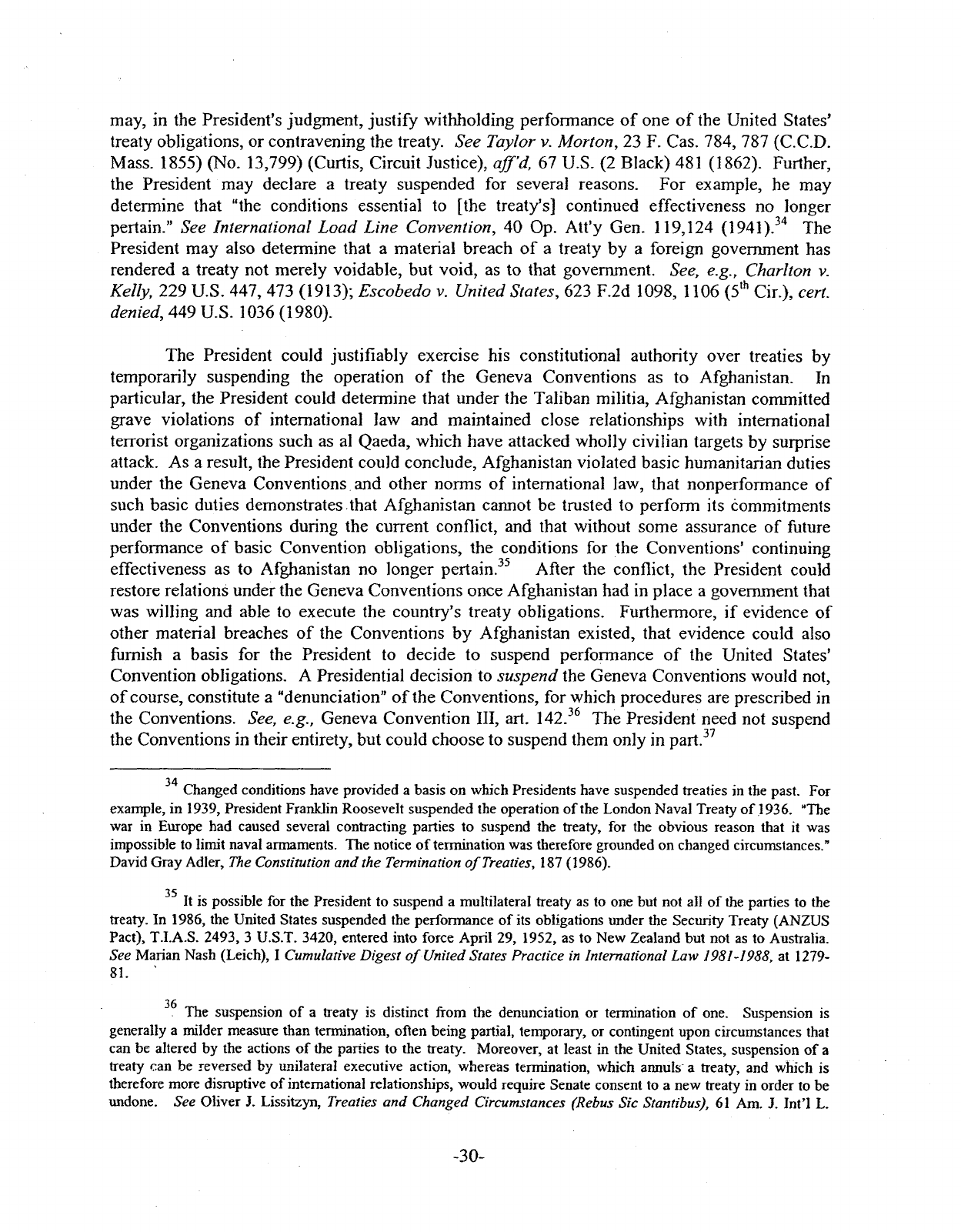
may, in the
President's
judgment,
justify
withholding
performance of one of the
United
States'
treaty obligations, or contravening the treaty. See
Taylor
v.
Morton,
23 F. Cas. 784, 787 (CCD.
Mass. 1855) (No. 13,799) (Curtis,
Circuit
Justice), aff'd, 67 U.S. (2 Black) 481 (1862). Further,
the President may declare a treaty
suspended
for several
reasons.
For example, he may
determine that "the conditions essential to [the treaty's] continued effectiveness no longer
pertain."
See International
Load
Line
Convention, 40 Op.
Att'y
Gen. 119,124 (1941).
34
The
President may also determine that a material breach of a treaty by a foreign government has
rendered a treaty not merely voidable, but
void,
as to that government. See, e.g., Charlton v.
Kelly,
229 U.S. 447, 473 (1913);
Escobedo
v.
United
States, 623 F.2d 1098, 1106 (5
t h
Cir.),
cert,
denied, 449 U.S. 1036 (1980).
The President could
justifiably
exercise his constitutional authority over treaties by
temporarily
suspending the operation of the Geneva Conventions as to Afghanistan. In
particular,
the President could determine that under the Taliban
militia,
Afghanistan committed
grave violations of international law and maintained close relationships
with
international
terrorist
organizations such as al
Qaeda,
which
have
attacked
wholly
civilian
targets
by surprise
attack. As a result, the President could conclude, Afghanistan violated
basic
humanitarian duties
under the Geneva Conventions and other norms of international law, that nonperformance of
such
basic
duties
demonstrates
that Afghanistan cannot be trusted to perform its commitments
under the Conventions during the current
conflict,
and that
without
some
assurance
of future
performance of
basic
Convention obligations, the conditions for the Conventions' continuing
effectiveness as to Afghanistan no longer pertain.
35
After
the
conflict,
the President could
restore relations under the Geneva Conventions
once
Afghanistan had in place a government that
was
willing
and able to execute the country's treaty obligations. Furthermore, if evidence of
other material
breaches
of the Conventions by Afghanistan existed, that evidence could also
fumish
a
basis
for the President to decide to
suspend
performance of the
United
States'
Convention
obligations. A Presidential decision to suspend the Geneva Conventions
would
not,
of
course, constitute a "denunciation" of the Conventions, for
which
procedures are prescribed in
the Conventions. See, e.g., Geneva Convention
III,
art. 142.
36
The President need not
suspend
the Conventions in their
entirety,
but could
choose
to
suspend
them
only
in part.
Changed
conditions have provided a basis on which Presidents have suspended treaties in the past. For
example, in 1939, President
Franklin
Roosevelt suspended the operation of the
London
Naval
Treaty
of 1936. "The
war
in Europe had caused several contracting parties to suspend the treaty, for the obvious reason that it was
impossible to limit naval armaments. The notice of termination was therefore grounded on changed circumstances."
David
Gray
Adler,
The
Constitution
and the
Termination
of
Treaties, 187 (1986).
3 5
It is possible for the President to suspend a multilateral treaty as to one but not all of the parties to the
treaty. In 1986, the United States suspended the performance of its obligations under the Security Treaty
(ANZUS
Pact),
T.I.A.S.
2493, 3
U.S.T.
3420, entered into force
April
29, 1952, as to New Zealand but not as to
Australia.
See
Marian
Nash
(Leich),
I Cumulative
Digest
of United
States
Practice in International Law
1981-1988,
at 1279-
81.
36
The
suspension of a treaty is distinct from the denunciation or termination of one. Suspension is
generally a milder measure than termination,
often
being
partial,
temporary, or contingent upon circumstances that
can
be altered by the actions of the parties to the treaty. Moreover, at least in the United States, suspension of a
treaty can be reversed by unilateral executive action, whereas termination, which annuls a treaty, and which is
therefore more disruptive of
international
relationships, would require Senate consent to a new treaty in order to be
undone. See
Oliver
J.
Lissitzyn,
Treaties and Changed Circumstances (Rebus Sic Stantibus), 61 Am. J.
Int'l
L.
-30-
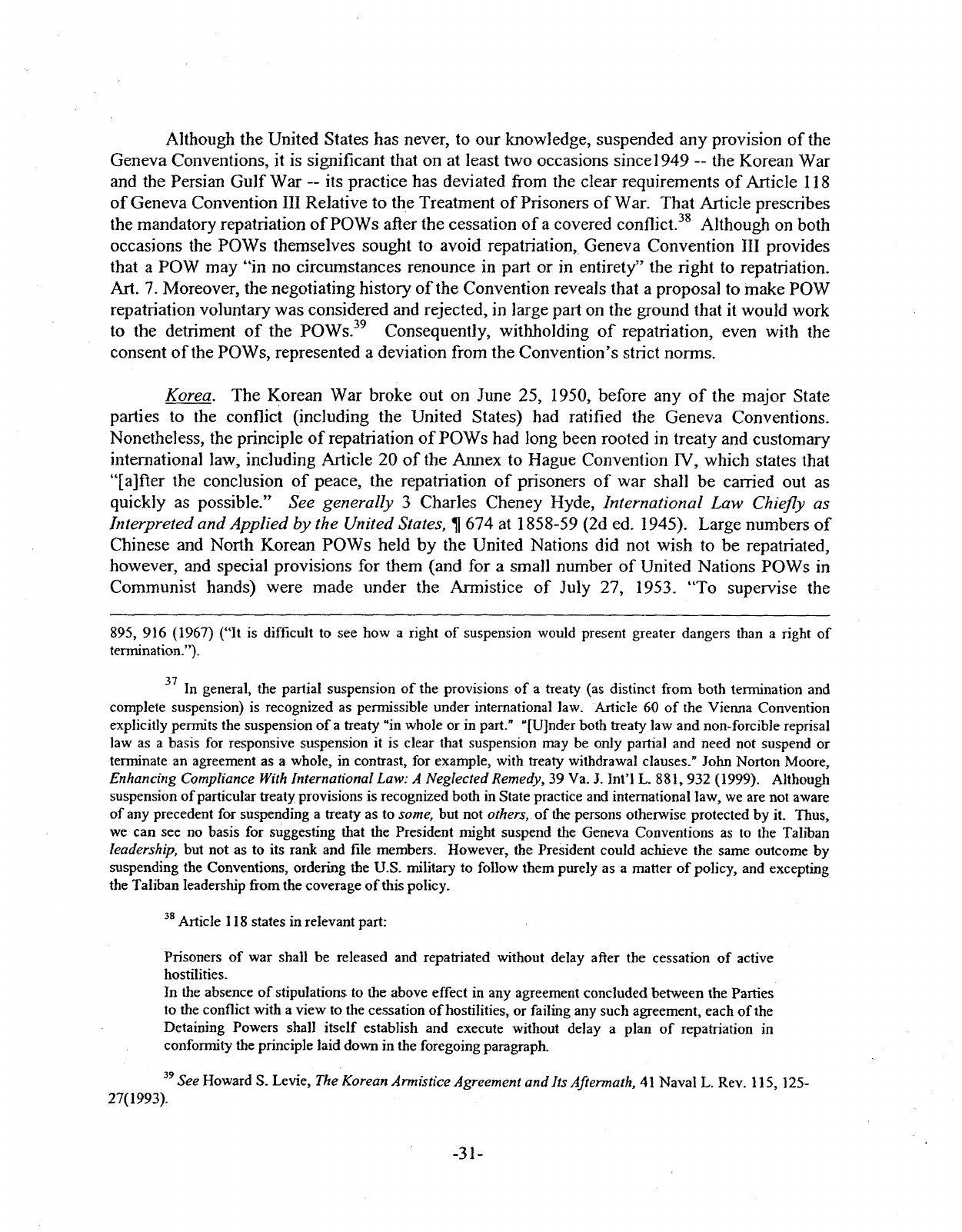
Although
the
United
States
has never, to our knowledge,
suspended
any
provision
of the
Geneva Conventions, it is significant that on at
least
two occasions since 1949
—
the Korean War
and the Persian
Gulf
War
—
its practice has deviated
from
the clear requirements of
Article
118
of
Geneva Convention
III
Relative to the Treatment of Prisoners of
War.
That
Article
prescribes
the mandatory
repatriation
of
POWs after the cessation of
a
covered
conflict.
38
Although
on both
occasions the POWs themselves sought to
avoid
repatriation, Geneva Convention
III
provides
that a POW may "in no circumstances renounce in part or in entirety" the
right
to repatriation.
Art.
7. Moreover, the negotiating history of the Convention reveals that a proposal to make POW
repatriation
voluntary
was considered and rejected, in large part on the ground that it
would
work
to
the detriment of the POWs.
39
Consequently,
withholding
of repatriation, even
with
the
consent
of
the POWs, represented a deviation
from
the Convention's strict norms.
Korea.
The Korean War broke out on
June
25, 1950, before any of the major
State
parties to the
conflict
(including
the
United
States)
had
ratified
the Geneva Conventions.
Nonetheless, the
principle
of
repatriation
of POWs had
long
been
rooted in treaty and customary
international
law,
including
Article
20 of the Annex to Hague Convention
IV,
which
states
that
"[a]fter
the conclusion of
peace,
the repatriation of prisoners of war shall be carried out as
quickly
as possible." See generally 3 Charles Cheney Hyde, International Law Chiefly as
Interpreted
and
Applied
by the
United
States,
^|
674 at 1858-59 (2d ed. 1945). Large numbers of
Chinese and
North
Korean POWs held by the
United
Nations did not
wish
to be repatriated,
however, and special provisions for them (and for a small number of
United
Nations POWs in
Communist
hands) were
made
under the
Armistice
of July 27, 1953. "To supervise the
895, 916 (1967) ("It is difficult to see how a right of suspension would present greater dangers than a right of
termination.").
37
In
general, the
partial
suspension of the provisions of a treaty (as distinct from both termination and
complete suspension) is recognized as permissible under international law. Article 60 of the Vienna Convention
explicitly permits the suspension of
a
treaty "in whole or in
part."
"[U]nder
both treaty law and non-forcible
reprisal
law
as a basis for responsive suspension it is clear that suspension may be only
partial
and need not suspend or
terminate an agreement as a whole, in contrast, for example, with treaty withdrawal clauses." John Norton Moore,
Enhancing
Compliance
With
International
Law: A
Neglected
Remedy,
39
Va.
J.
Int'l
L.
881, 932 (1999). Although
suspension of
particular
treaty provisions is recognized both in State practice and international law, we are not aware
of
any
precedent for suspending a treaty as to
some,
but not others, of the persons otherwise protected by it.
Thus,
we can see no basis for
suggesting
that the President might suspend the Geneva Conventions as to the
Taliban
leadership, but not as to its
rank
and file members. However, the President could achieve the same
outcome
by
suspending the Conventions, ordering the U.S. military to follow them purely as a matter of policy, and excepting
the
Taliban
leadership
from
the coverage of this policy.
3 8
Article
118
states
in relevant part:
Prisoners
of war shall be released and repatriated without delay after the cessation of active
hostilities.
In
the absence of stipulations to the above
effect
in any agreement concluded
between
the Parties
to the conflict with a view to the cessation of hostilities, or failing any such agreement, each of the
Detaining
Powers shall itself establish and
execute
without delay a plan of repatriation in
conformity the principle
laid
down in the foregoing
paragraph.
3 9
See
Howard
S.
Levie,
The
Korean Armistice
Agreement
and
Its
Aftermath,
41 Naval
L .
Rev. 115, 125-
27(1993).
-31-

repatriation,
the armistice created a Neutral Nations Repatriation Commission, composed of
representatives
from
Sweden, Switzerland, Poland, Czechoslovakia, and India.
Within
sixty
days
of signing the
Armistice,
prisoners who desired repatriation were to be directly repatriated
in
groups to the side to
which
they belonged at the time of their capture. Those prisoners not so
repatriated were to be
released
to the Neutral Nations Repatriation Commission .. . for further
disposition."
David
M . Morriss,
From
War to
Peace:
A Study of
Cease-Fire
Agreements and
the
Evolving
Role
of the
United
Nations, 36 Va. J.
Int'l
L. 801, 883 (1996). Altogether
approximately
23,000 POWs refused repatriation. The
majority
(not quite 22,000) eventually
went
to
Taiwan.
Id. at 885.
The
Persian
Gulf
War. At the cessation of hostilities in the Persian
Gulf
War,
some
13,418
Iraqi
POWs held by
Allied
forces were
unwilling
to be repatriated for fear of suffering
punishment
from
their government for having surrendered. Notwithstanding the repatriation
mandate
of Geneva Convention
III,
the
United
States
and its
Allies
executed an agreement
with
Iraq
providing
for
only
voluntary repatriation through a program administered by the
International
Committee
of
the Red Cross. See id .at
931
& n.633.
D.
Suspension
Under
International Law
Although
the President has the constitutional authority to determine either that
Afghanistan
is a
failed
State
or that the Geneva Conventions should be
suspended
under the
present
circumstances, there remains the distinct question whether such Presidential actions
would
be
valid
as a matter of international law.
4 0
We emphasize that the resolution of the
question, however, has no bearing on the
President's
constitutional powers - or on the
application
of the
WCA.
Rather,
these
issues
are
worth
consideration as a
means
of
justifying
any suspension decision by the President in the
world
of international
politics.
While
a close
question, we believe that the better
view
is that, in certain circumstances, countries can
suspend
the Geneva Conventions consistently
with
international law.
International
law has long recognized that the material breach of a treaty can be grounds
for
the party
injured
by the breach to terminate or withdraw
from
the treaty. See
Legal
Consequences
for States of the Continued
Presence
of South
Africa
in Namibia (South West
Africa)
Notwithstanding Security
Council
Resolution 276, 1971 I.C.J. 16, 47 U 98
(Advisory
Opinion
June
21,
1971)
(holding
it to be a "general
principle
of
law
that a
right
of
termination
on
account of breach must be presumed to exist in
respect
of all treaties, except as
regards
provisions
relating to the protection of the human person contained in treaties of a humanitarian
character. . .. The silence of a treaty as to the existence of such a
right
cannot be interpreted as
implying
the exclusion of a
right
which
has its
source
outside of the treaty, in general
international
law[.]").
Under customary international law, the general rule is that breach of a
multilateral
treaty by a
State
Party
justifies
the suspension
of
that treaty
with
regard to that
State.
"A
material breach of a multilateral treaty by one of the parties entitles .. . [a] party specially
affected
by the breach to invoke it as a ground for suspending the operation
of
the treaty in whole
In
general, of
course,
a decision by a State not to discharge its treaty obligations, even when
effective
as
a
matter of domestic law,
does
not necessarily relieve it of possible international liability for non-performance. See
.
generally
Pigeon River
Improvement,
Slide & Boom Co. v. Charles W. Cox, Ltd., 291 U.S.
138,160
(1934).
-32-

or
in part in the relations between
itself
and the defaulting State." Vienna Convention art.
60(2)(b).
Assuming that Afghanistan
could
be
found
to be in material breach for having violated
"a
provision
essential to the accomplishment of the object or purpose of the [Geneva
Conventions],"
suspension
of
the Conventions
would
(thus far) be
justified.
Id. art. 60(3).
We
note, however, that
these
general rules authorizing suspension "do not apply to
provisions
relating to the protection of the human person contained in treaties of a humanitarian
character, in particular to provisions
prohibiting
any
form
of reprisals against
persons
protected
by
such treaties." Id. art. 60(5).
41
Although
the
United
States
is not a party to the Vienna
Convention,
some
lower courts have said that the Convention embodies the customary
international
law of treaties, see
Fujitsu
Ltd. v.
Federal
Express
Corp.,
247 F.3d 423, 433 (2d
Cir.),
cert.
denied, 122 S. Ct. 206 (2001), and the
State
Department has at various times taken the
same
view.
4 2
The Geneva Conventions must be regarded as "treaties of a humanitarian
character," many of whose provisions "relat[e] to the protection of the human person."
43
Arguably,
therefore, a Presidential determination that the Geneva Conventions were inoperative
as to Afghanistan or a decision to suspend them,
might
put the
United
States
in breach of
customary
international
law.
In
addition, the Geneva Conventions
could
themselves be read to preclude suspension.
Common
Article
1
pledges the
High
Contracting Parties "to respect and to
ensure
respect for the
present Convention in all circumstances" (emphasis added). Some commentators argue that this
provision
should be read to bar any
State
party
from
refusing to enforce their provisions, no
matter the conduct of its adversaries. In other words, the duty of performance is absolute and
does
not depend upon reciprocal performance by other
State
parties. See, e.g., Draper, The Red
Cross
Conventions,
supra,
at 8; see
also
Military
and Paramilitary
Activities
In and Against
Nicaragua
(Nicaragua
v.
United
States),
76
I.L.R.
at 448, U 220. Under this approach, the
substantive terms of the Geneva Conventions
could
never be
suspended,
and thus any
violation
would
always be
illegal
under
international
law.
This
understanding of the Vienna and Geneva Conventions cannot be correct. There is
no textual
provision
in the Geneva Conventions that
clearly
prohibits
temporary suspension. The
drafters included a
provision
that
appears
to preclude
State
parties
from
agreeing to absolve each
other of
violations.
See, e.g., Geneva Convention
III ,
art. 131. They also included careful
The
Vienna Convention
seems
to prohibit or restrict the suspension of
humanitarian
treaties if the
sole
ground for suspension is
material
breach.
It
does
not squarely address the case in which suspension is based, not on
particular
breaches by a party, but by the party's disappearance as a State or on its incapacity to perform its treaty
obligations.
42
See
Moore, supra n.37, at 891-92 (quoting 1971 statement by Secretary of State
William
P. Rogers and
1986 testimony by Deputy
Legal
Adviser
Mary
V.
Mochary).
43
See
Sir
Ian
Sinclair,
The
Vienna
Convention on the Law of
Treaties
191 (2d ed. 1984) (explaining intent
and
scope of reference to
"humanitarian"
treaties). Indeed, when the drafters of the Vienna Convention added
paragraph
5 to article 60, the Geneva Conventions were specifically mentioned as coming within it. See
Harris,
supra n.19, at 797.
-33-
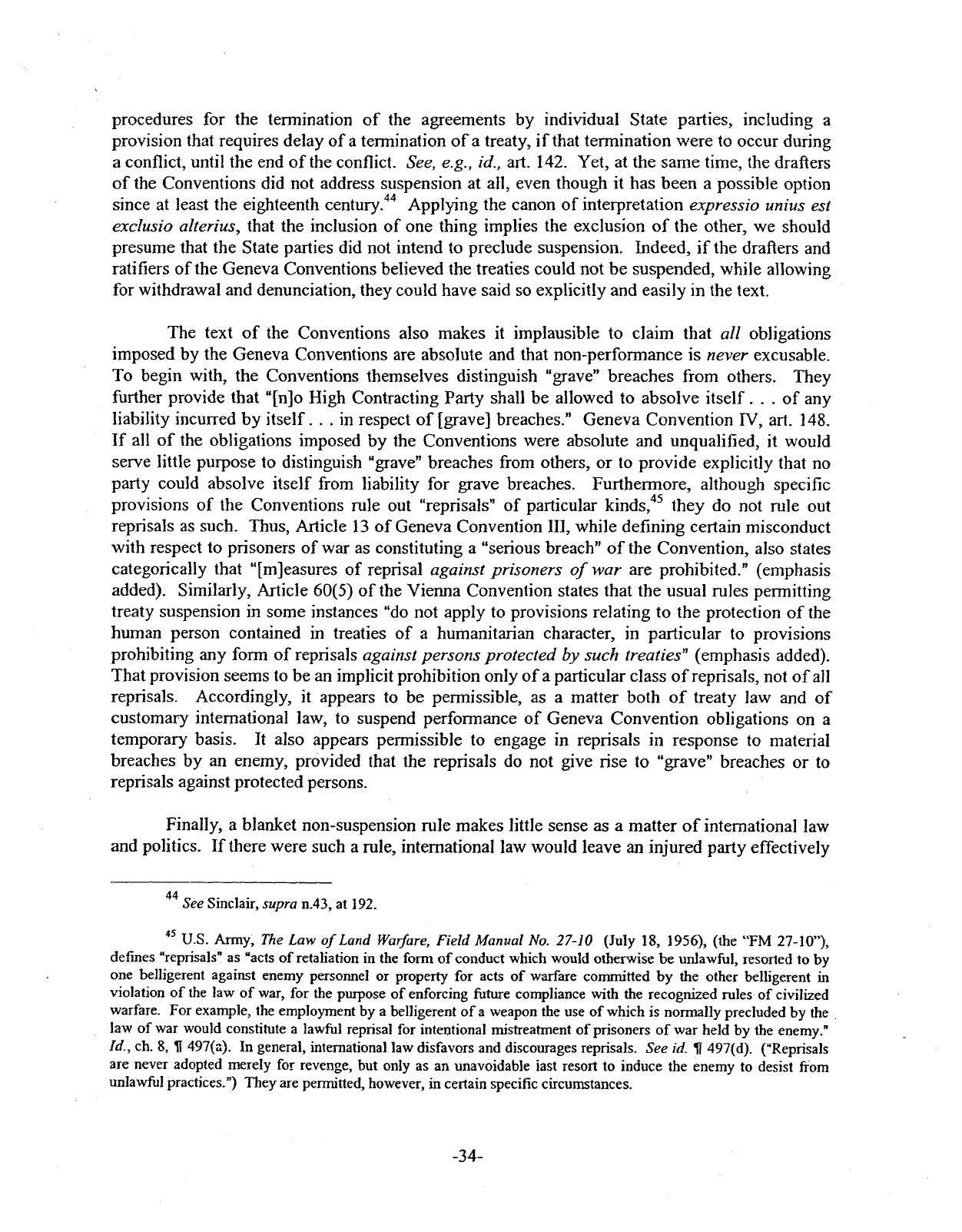
procedures for the termination of the
agreements
by
individual
State
parties,
including
a
provision
that requires delay of
a
termination
of
a treaty,
if
that termination were to occur during
a
conflict,
until
the end of the
conflict.
See, e.g., id., art. 142. Yet, at the
same
time,
the drafters
of
the Conventions did not
address
suspension at
all,
even though it has been a possible
option
since at least the eighteenth century.
44
Applying
the canon of interpretation
expressio
unius est
exclusio
alterius,
that the
inclusion
of one
thing
implies the exclusion of the other, we should
presume that the
State
parties did not intend to preclude suspension. Indeed,
i f
the drafters and
ratifiers
of the Geneva Conventions believed the treaties
could
not be
suspended,
while
allowing
for
withdrawal
and denunciation, they
could
have said so
explicitly
and easily in the text.
The text of the Conventions also makes it implausible to
claim
that all obligations
imposed
by the Geneva Conventions are absolute and that non-performance is never excusable.
To
begin
with,
the Conventions themselves distinguish "grave"
breaches
from
others. They
further
provide that "[n]o
High
Contracting Party shall be allowed to absolve
itself
.. . of any
liability
incurred by
itself...
in respect of
[grave]
breaches."
Geneva Convention
IV,
art. 148.
If
all of the obligations imposed by the Conventions were absolute and unqualified, it
would
serve
little
purpose to distinguish "grave"
breaches
from
others, or to provide
explicitly
that no
party
could
absolve
itself
from
liability
for grave
breaches.
Furthermore, although specific
provisions
of the Conventions rule out "reprisals" of particular kinds,
4 5
they do not rule out
reprisals as such. Thus,
Article
13 of Geneva Convention
III,
while
defining
certain misconduct
with
respect to prisoners of war as constituting a "serious breach" of the Convention, also
states
categorically
that "[m]easures of reprisal against
prisoners
of war axe prohibited." (emphasis
added).
Similarly,
Article
60(5) of the Vienna Convention
states
that the usual rules
permitting
treaty suspension in
some
instances "do not apply to provisions relating to the protection of the
human person contained in treaties of a humanitarian character, in particular to provisions
prohibiting
any
form
of reprisals against persons protected by such treaties" (emphasis added).
That
provision
seems
to be an
implicit
prohibition
only
of
a particular
class
of
reprisals, not of
all
reprisals.
Accordingly,
it
appears
to be permissible, as a matter both of treaty law and of
customary international law, to suspend performance of Geneva Convention obligations on a
temporary
basis. It also
appears
permissible to
engage
in reprisals in
response
to material
breaches
by an enemy, provided that the reprisals do not give rise to "grave"
breaches
or to
reprisals against protected persons.
Finally,
a blanket non-suspension rule makes
little
sense
as a matter of
international
law
and
politics.
I f
there were such a
rule,
international law
would
leave an
injured
party
effectively
See
Sinclair,
supra n.43, at 192.
4 5
U.S.
Army,
The Law
of
Land
Warfare,
Field
Manual No. 27-10
(July
18, 1956), (the
"FM
27-10"),
defines
"reprisals"
as "acts of
retaliation
in the form of conduct which would otherwise be unlawful, resorted to by
one belligerent against enemy personnel or property for acts of warfare committed by the other belligerent in
violation of the law of
war,
for the purpose of enforcing future compliance with the recognized rules of civilized
warfare.
For
example, the employment by a belligerent of
a
weapon the use of
which
is normally precluded by the
law
of
war
would constitute a lawful
reprisal
for intentional mistreatment of
prisoners
of
war
held by the enemy."
Id.,
ch. 8,
%
497(a). In general, international law disfavors and discourages
reprisals.
See id. f 497(d). ("Reprisals
are
never adopted merely for revenge, but only as an unavoidable last resort to induce the enemy to desist from
unlawful
practices.") They
are
permitted, however, in certain specific circumstances.
-34-
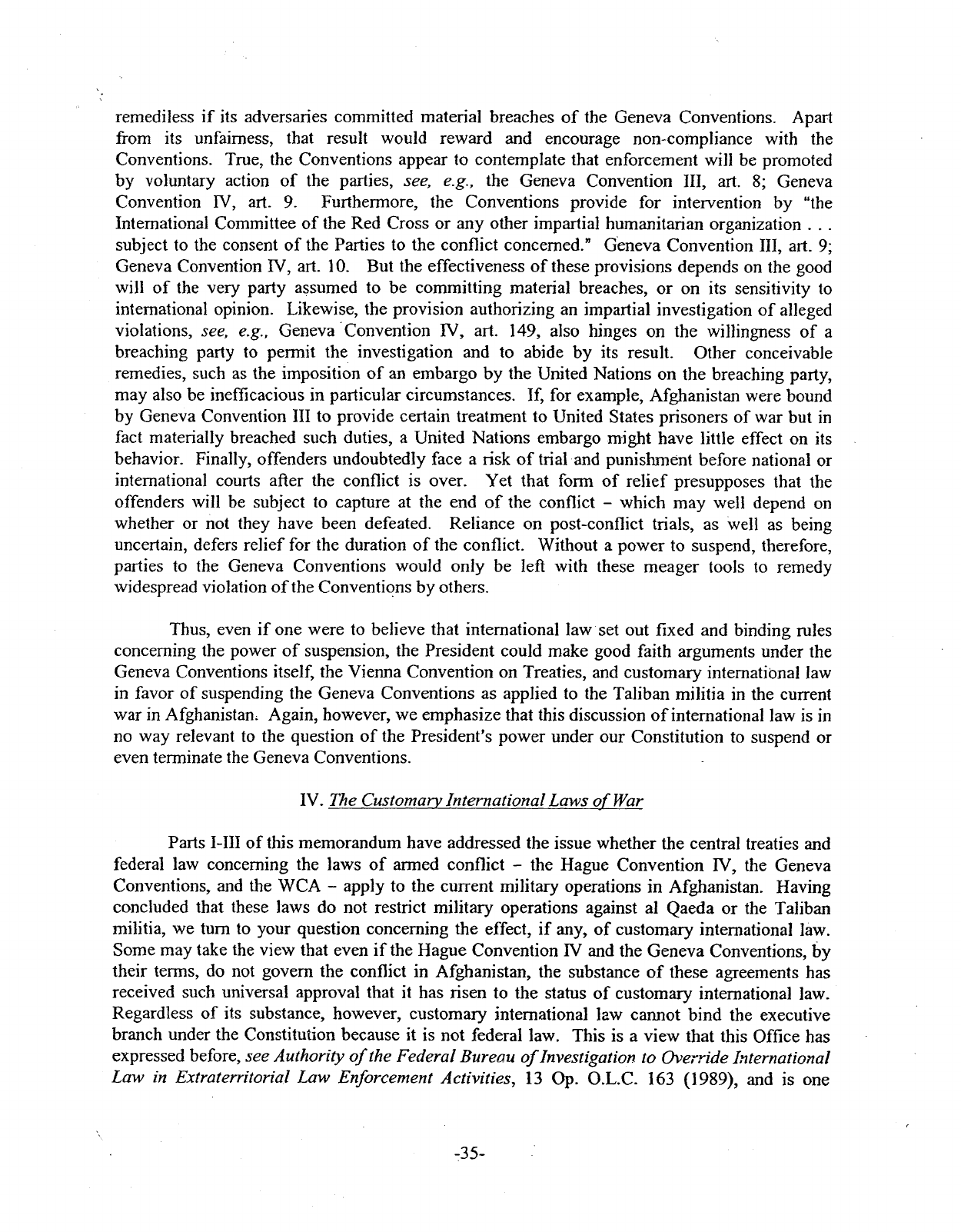
remediless if its
adversaries
committed material
breaches
of the Geneva Conventions. Apart
from
its unfairness, that result
would
reward and
encourage
non-compliance
with
the
Conventions. True, the Conventions
appear
to contemplate that enforcement
will
be promoted
by
voluntary action of the parties, see, e.g., the Geneva Convention III , art. 8; Geneva
Convention
IV, art. 9. Furthermore, the Conventions provide for intervention by "the
International
Committee of the Red
Cross
or any other
impartial
humanitarian organization . . .
subject to the consent of the Parties to the
conflict
concerned." Geneva Convention
III,
art. 9;
Geneva Convention IV, art. 10. But the effectiveness of
these
provisions
depends
on the good
will
of the very party
assumed
to be committing material
breaches,
or on its sensitivity to
international
opinion.
Likewise, the provision authorizing an
impartial
investigation of alleged
violations,
see, e.g., Geneva Convention IV, art. 149, also hinges on the willingness of a
breaching party to permit the investigation and to abide by its result. Other conceivable
remedies, such as the imposition of an embargo by the
United
Nations on the breaching party,
may also be inefficacious in particular circumstances. If, for example, Afghanistan were bound
by
Geneva Convention
II I
to provide certain treatment to
United
States
prisoners of war but in
fact
materially breached such duties, a
United
Nations embargo might
have
little
effect on its
behavior.
Finally,
offenders undoubtedly face a
risk
of
trial
and punishment before national or
international
courts after the
conflict
is over. Yet that
form
of
relief
presupposes
that the
offenders
will
be subject to capture at the end of the
conflict
-
which
may
well
depend on
whether or not they
have
been
defeated. Reliance on post-conflict trials, as
well
as being
uncertain, defers
relief
for the duration of the
conflict.
Without
a power to
suspend,
therefore,
parties to the Geneva Conventions
would
only
be
left
with
these
meager
tools to remedy
widespread
violation
of
the Conventions by others.
Thus, even i f one were to believe that international law set out
fixed
and binding rules
concerning the power of suspension, the President could make good
faith
arguments under the
Geneva Conventions itself, the Vienna Convention on Treaties, and customary international law
in
favor of suspending the Geneva Conventions as applied to the Taliban
militia
in the current
war
in Afghanistan,
Again,
however, we emphasize that this discussion
of
international
law is in
no way relevant to the question of the
President's
power under our Constitution to
suspend
or
even terminate the Geneva Conventions.
IV.
The Customary International
Laws
of
War
Parts
I-III
of this memorandum
have
addressed
the
issue
whether the central treaties and
federal
law concerning the laws of armed
conflict
- the Hague Convention IV, the Geneva
Conventions, and the WCA - apply to the current
military
operations in Afghanistan. Having
concluded that
these
laws do not restrict
military
operations against al
Qaeda
or the Taliban
militia,
we
turn
to your question concerning the effect, if any, of customary international law.
Some may take the
view
that even
if
the Hague Convention IV and the Geneva Conventions, by
their
terms, do not govern the
conflict
in Afghanistan, the
substance
of
these
agreements
has
received such universal approval that it has risen to the
status
of customary international law.
Regardless
of its
substance,
however, customary international law cannot
bind
the executive
branch under the Constitution
because
it is not federal law. This is a
view
that this
Office
has
expressed
before, see Authority
of
the
Federal
Bureau
of
Investigation
to
Override
International
Law
in
Extraterritorial
Law Enforcement
Activities,
13 Op.
O.L.C.
163 (1989), and is one
-35-

consistent
with
the views of the federal courts, see, e.g., United States v. Alvarez-Machain, 504
U.S.
655 (1992), and
with
executive branch arguments in the courts, see, id. at 669-70;
Committee of United States Citizens
Living
in Nicaragua v. Reagan, 859 F.2d 929, 935-36 (D.C.
Cir.
1988);
Garcia-Mir
v.
Meese, 788 F.2d 1446, 1453-55
(1 l
,t h
Cir.),
cert, denied, 479 U.S. 889
(1986).
As a result, any customary international law of armed
conflict
in no way binds, as a
legal
matter, the President or the operation of the U.S. Armed Forces.
A.
Is Customary International Law
Federal
Law?
Under the view promoted by many international law
academics,
any presidential
violation
of customary international law is presumptively unconstitutional.
46
These
scholars
argue
that customary international law is federal law, and that the
President's
Article
I I duty
under the Take
Care
Clause
requires him to
execute
customary international law as
well
as
statutes
lawfully
enacted
under the Constitution. A President may not violate customary
international
law, therefore, just as he cannot violate a statute,
unless
he believes it to be
unconstitutional.
Relying upon
cases
such as The Paquete Habana, in
which
the
Supreme
Court
observed that "international law is part of our law," 175 U.S. 677, 700 (1900), this position often
claims that the federal
judiciary
has the authority to invalidate executive action that runs counter
to
customary international law.
4 7
This
view of customary international law is seriously mistaken. The constitutional text
nowhere brackets presidential or federal power
within
the confines of international law. When
the Supremacy
Clause
discusses
the
sources
of federal law, it
enumerates
only "this Constitution,
and the Laws of the United
States
which
shall be
made
in
Pursuance
thereof; and all Treaties
made,
or
which
shall be
made,
under the
Authority
of the United
States."
U.S. Const, art.
VI.
International
law is nowhere mentioned in the Constitution as an independent
source
of federal
law
or as a constraint on the
political
branches
of government. Indeed, if it were,
there
would
have
been
no
need
to grant to
Congress
the power to "define and punish . . . Offenses against the
See, e.g., Michael J. Glennon, Raising the
Paquete
Habana: Is Violation of
Customary
International
Law by the Executive Unconstitutional?, 80 Nw. U. L.
REV.
321, 325 (1985); Louis Henkin, International Law As
Law in the United
States,
82
MICH.
L.
REV.
1555, 1567 (1984); Jules
Lobel,
The Limits of Constitutional Power:
Conflicts
Between
Foreign Policy and International Law, 71
VA.
L.
REV.
1071, 1179 (1985); see
also
Jonathan R.
Chamey,
Agora: May the President
Violate
Customary
International
Law?,
80
AM. J. INT'L L.
913 (1986).
47
Recently, the status of customary international law within the federal legal system has
been
the subject
of sustained
debate
with legal academia. The legitimacy of incorporating customary international law as federal law
has
been
subjected in
these
exchanges
to crippling doubts. See
Curtis
A. Bradley &
Jack
L .
Goldsmith,
Customary
International Law As Federal Common Law: A Critique of the Modern Position, 110
Harv.
L . Rev. 815, 817
(1997); see
also
Phillip R. Trimble, A Revisionist View of
Customary
International Law, 33
UCLA
L. Rev. 665,
672-673
(1986);
Arthur
M. Weisburd, The Executive Branch and International Law, 41
Vand.
L .
Rev. 1205, 1269
(1988). These claims have not
gone
unchallenged. Harold H. Koh, Is International Law
Really
State
Law?, 111
Harv.
L .
Rev. 1824, 1827 (1998);
Gerald
L .
Neuman, Sense and Nonsense About
Customary
International Law: A
Response to Professors
Bradley
and Goldsmith, 66 Fordham
L .
Rev. 371, 371 (1997); Beth Stephens, The Law of
Our
Land:
Customary
International Law As Federal Law After
Erie,
66 Fordham L . Rev. 393,
396-97
(1997).
Bradley
and Goldsmith have responded to their critics several times. See
Curtis
A. Bradley &
Jack
L.
Goldsmith,
Federal
Courts and the Incorporation
of
International Law, 111
Harv.
L. Rev.
2260
(1998);
Curtis
A. Bradley &
Jack
L . Goldsmith, The Current
Illegitimacy
of
International
Human Rights Litigation, 66 Fordham
L .
Rev. 319,
330(1997).
-36-

Law
of
Nations."
U.S. Const, art.
I,
§ 8. It is also clear that the
original
understanding of the
Framers was that "Laws of the
United
States"
did not include the law of
nations,
as international
law
was called in the late eighteenth century. In explaining the
jurisdiction
of the
Article
III
courts to
cases
arising "under the Constitution and the Laws of the
United
States,"
for example,
Alexander
Hamilton
did not include the law
of
nations as a source
of
jurisdiction.
The
Federalist
No.
80, at 447-49 (Alexander
Hamilton)
(Clinton
Rossiter ed., 1999). Rather,
Hamilton
pointed
out,
claims
involving
the laws of nations
would
arise in either
diversity
cases
or maritime
cases,
id.
at 444-46,
which
by
definition
do not
involve
"the Laws of the
United
States."
Little
evidence
exists that
those
who attended the Philadelphia Convention in the summer of 1787 or the
state
ratifying
conventions believed that federal law
would
have included customary
international
law,
but
rather that the law of nations was part of a general common law that was not true federal
law.
4 8
Indeed,
allowing
customary international law to rise to the
level
of federal law
would
create
severe
distortions in the structure of the Constitution. Incorporation of customary
international
law
directly
into
federal law
would
bypass
the delicate procedures established by
the Constitution for amending the Constitution or for enacting
legislation.
Cf. INS
v.
Chadha,
462 U.S. 919 (1983)
(invalidating
legislative veto for
failure
to undergo bicameralism and
presentment as required by
Article
I ,
Section 8 for all
legislation).
Customary international law
is
not approved by two-thirds of Congress and three-quarters of the
state
legislatures, it has not
been
passed
by both
houses
of Congress and signed by the President, nor is it made by the
President
with
the advice and consent of
two-thirds
of the
Senate.
In other words, customary
international
law has not undergone the
difficult
hurdles that stand before enactment of
constitutional
amendments, statutes, or treaties. As such, it can have no legal effect on the
government or on
American
citizens
because
it is not
law.
49
Even the
inclusion
of
treaties in the
Supremacy Clause
does
not render treaties automatically self-executing in federal court, not to
mention
self-executing against the executive branch. See, e.g.,
Foster
v.
Neilson, 27
U.S.
(2 Pet.)
253,
314
(1829).
I f
even treaties that have undergone presidential signature and senatorial advice
and consent can have no
binding
legal effect in the
United
States,
then it certainly must be the
case
that a source of rules that never undergoes any
process
established by our Constitution
cannot be
law.
5 0
See,
e.g., Stewart Jay,
The
Status
of
the Law
of
Nations in Early American Law, 42
Vand.
L .
Rev. 819,
830-37 (1989);
Bradford
R.
Clark,
Federal
Common
Law: A Structural Reinterpretation, 144 U. Pa.
L.
Rev. 1245,
1306-12 (1996);
Curtis
A. Bradley &
Jack
L .
Goldsmith, The
Current
Illegitimacy
of
International
Human
Rights
Litigation, 66
Fordham
L .
Rev. 319, 333-36 (1997).
49
In
fact, allowing customary international law to bear the force of federal law would create significant
problems under the Appointments Clause and the non-delegation doctrine, as it would be law made completely
outside the American legal system through a process of international practice, rather than either the legislature or
officers of the United States authorized to do so.
5 0
See John C. Yoo, Globalism and the Constitution: Treaties, Non-Self-Execution, and the Original
Understanding, 99
Colum.
L. Rev. 1955 (1999) (non-self-execution of treaties justified by the original
understanding);
John C. Yoo, Treaties and Public Lawmaking: A Textual and Structural Defense of
Non-Self-
Execution,
99
Colum.
L. Rev. 2218 (1999) (demonstrating that constitutional
text
and structure require
implementation of treaty obligations by federal statute).
-37-
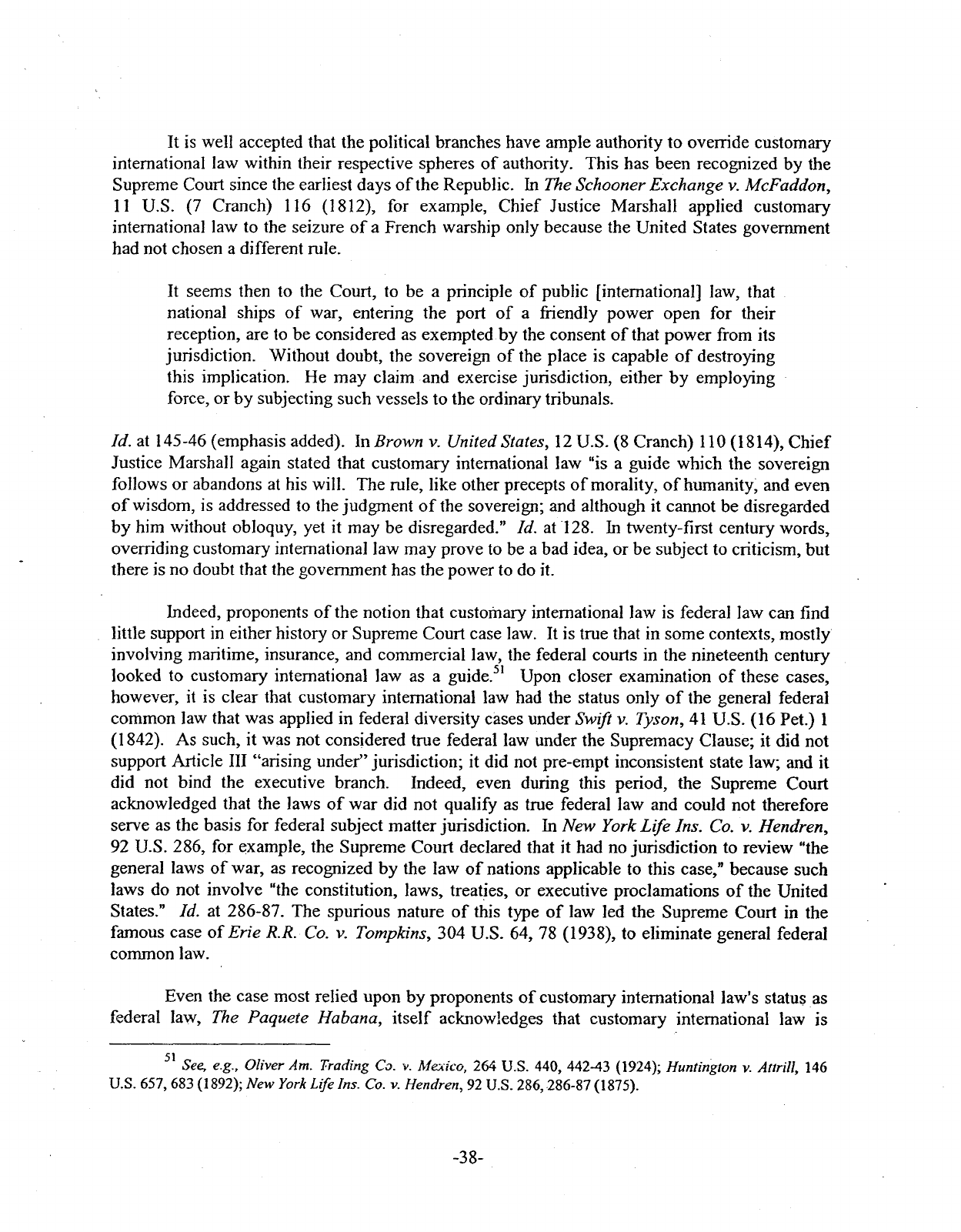
It
is
well
accepted that the
political
branches
have
ample authority to override customary
international
law
within
their respective
spheres
of
authority.
This has
been
recognized by the
Supreme Court since the earliest
days
of
the Republic. In The Schooner
Exchange
v.
McFaddon,
11
U.S. (7 Cranch) 116 (1812), for example,
Chief
Justice Marshall applied customary
international
law to the seizure of a French warship
only
because
the
United
States
government
had not chosen a different rule.
It
seems
then to the Court, to be a principle of public [international] law, that
national
ships of war, entering the port of a
friendly
power open for their
reception, are to be considered as exempted by the consent of that power
from
its
jurisdiction.
Without
doubt, the sovereign of the place is capable of destroying
this
implication.
He may
claim
and exercise
jurisdiction,
either by employing
force,
or by subjecting such
vessels
to the ordinary tribunals.
Id.
at 145-46 (emphasis added).
InBrown
v.
United
States,
12 U.S. (8 Cranch) 110 (1814),
Chief
Justice Marshall again stated that customary international law "is a guide
which
the sovereign
follows
or
abandons
at his
will.
The rule,
like
other
precepts
of
morality,
of
humanity,
and even
of
wisdom,
is
addressed
to the judgment of the sovereign; and although it cannot be disregarded
by
him
without
obloquy, yet it may be disregarded." Id. at 128. In twenty-first century words,
overriding
customary international law may prove to be a bad idea, or be subject to
criticism,
but
there is no doubt that the government has the power to do it.
Indeed, proponents of the notion that customary international law is federal law can
find
little
support in either history or Supreme Court
case
law. It is true that in
some
contexts, mostly
involving
maritime, insurance, and commercial law, the federal courts in the nineteenth century
looked
to customary international law as a guide.
51
Upon closer examination of
these
cases,
however, it is clear that customary international law had the
status
only
of the general federal
common
law that was applied in federal diversity
cases
under Swift v.
Tyson,
41 U.S. (16 Pet.) 1
(1842).
As such, it was not considered true federal law under the Supremacy Clause; it did not
support
Article
II I
"arising under"
jurisdiction;
it did not pre-empt inconsistent
state
law; and it
did
not
bind
the executive branch. Indeed, even during this period, the Supreme Court
acknowledged that the laws of war did not
qualify
as true federal law and could not therefore
serve
as the
basis
for federal subject matter
jurisdiction.
In New
York
Life
Ins. Co. v. Hendren,
92 U.S. 286, for example, the Supreme Court declared that it had no
jurisdiction
to review "the
general laws of war, as recognized by the law of nations applicable to this
case,"
because
such
laws do not
involve
"the constitution, laws, treaties, or executive proclamations of the
United
States."
Id. at 286-87. The spurious nature of this type of law led the Supreme Court in the
famous
case
of
Erie
R.R. Co. v. Tompkins, 304 U.S. 64, 78 (1938), to eliminate general federal
common
law.
Even
the
case
most relied upon by proponents of customary international law's
status
as
federal
law, The Paquete Habana,
itself
acknowledges that customary international law is
See, e.g., Oliver
Am.
Trading Co. v. Mexico, 264 U.S. 440,
442-43
(1924); Huntington v.
Attrill,
146
U.S.
657, 683 (1892); New
York
Life
Ins.
Co. v. Hendren, 92 U.S. 286, 286-87 (1875).
-38-

subject to override by the action of the
political
branches.
The Paquete Habana involved the
question whether U.S. armed
vessels
in wartime could
capture
certain fishing
vessels
belonging
to
enemy
nationals and sell them as prize. In that
case,
the Court applied an international law
rule,
and did indeed say that "international law is part of our law." Id. at 700. But
Justice
Gray
then continued, "where there is no treaty and no controlling executive or legislative act or
judicial
decision, resort must be had to the
customs
and
usages
of
civilized
nations." Id. In other
words, while it was
willing
to apply customary international law as general federal common law
(this
was the era of Swift v.
Tyson),
the Court
also
readily acknowledged that the
political
branches
and even the federal judiciary could override it at any time. No
Supreme
Court
decision in modern times has challenged that view.
5 2
Thus,
under
clear
Supreme
Court
precedent,
any presidential decision in the current
conflict
concerning the conduct of the U.S.
Armed
Forces
would
constitute a "controlling" executive act that
would
immediately and
completely override any customary international law norms.
Constitutional
text and
Supreme
Court decisions
aside,
allowing
the federal courts to rely
upon international law to restrict the
President's
discretion to conduct war
would
raise
deep
structural problems. First, i f customary international law is indeed federal law, then it must
receive all of the benefits of the Supremacy
Clause.
Therefore, customary international law
would
not only bind the
President,
but it
also
would
pre-empt
state
law and even
supersede
inconsistent federal
statutes
and
treaties
that were
enacted
before the rule of customary
international law
came
into being. This has
never
happened.
Indeed,
giving
customary
international law this power not only
runs
counter to the
Supreme
Court
cases
described
above,
but
would
have
the effect of
importing
a body of law to restrain the
three
branches
of American
government that
never
underwent any approval by our democratic
political
process.
I f
customary international law
does
not
have
these
effects, as the constitutional text, practice and
most
sensible
readings
of the Constitution indicate, then it cannot be true federal law
under
the
Supremacy
Clause.
As non-federal law, then, customary international law cannot bind the
Two
lines of cases are
often
cited for the proposition that the Supreme
Court
has found customary
international
law to be federal law. The first, which derives from Murray v. Schooner Charming
Betsy,
6 U.S. (2
Cranch)
64 (1804). The
"Charming
Betsy"
rule,
as it is
sometimes
known, is a rule of construction that a statute
should be construed when possible so as not to conflict with international law.
This
rule, however,
does
not apply
international
law of
its
own force, but instead can be
seen
as measure of
judicial
restraint:
that violating international
law
is a decision for the political branches to make, and that if they wish to do so, they should
state
clearly their
intentions. The second, Banco Nacional de Cuba v. Sabbatino, 376 U.S. 398, applied the "act of state" doctrine,
which
generally precludes courts from examining the validity of the decisions of foreign governments taken on their
own soil, as federal common law to a suit over expropriations by the
Cuban
government. As with
Charming
Betsy,
however, the
Court
developed this rule as one of
judicial
self-restraint to preserve the flexibility of the political
branches to decide how to conduct foreign policy.
Some supporters of customary international law as federal law rely on a third line of cases, beginning with
Filartiga v. Pena-lrala, 630 F.2d 876 (2d
Cir.
1980). In Fildrtiga, the Second
Circuit
read the federal Alien
Tort
Statute, 28
U.S.C.
§1350
(1994), to allow a tort suit in federal court against the former official of a foreign
government for violating norms of international human rights law, namely torture. Incorporation of customary
international
law via the Alien
Tort
Statute, while accepted by several
circuit
courts, has never received the blessings
of the Supreme
Court
and has been sharply criticized by
some
circuits, see, e.g., Tel-Oren v. Libyan Arab Republic,
726 F.2d 774,
808-10
(D.C.
Cir.1984)
(Bork,
J.,
concurring),
cert,
denied,
470 U.S. 1003 (1985), as well as by
academics, see
Curtis
A. Bradley &
Jack.
L .
Goldsmith, The Current
Illegitimacy
of
International
Human
Rights
Litigation, 66
Fordham
L .
Rev.
319,330
(1997).
-39-
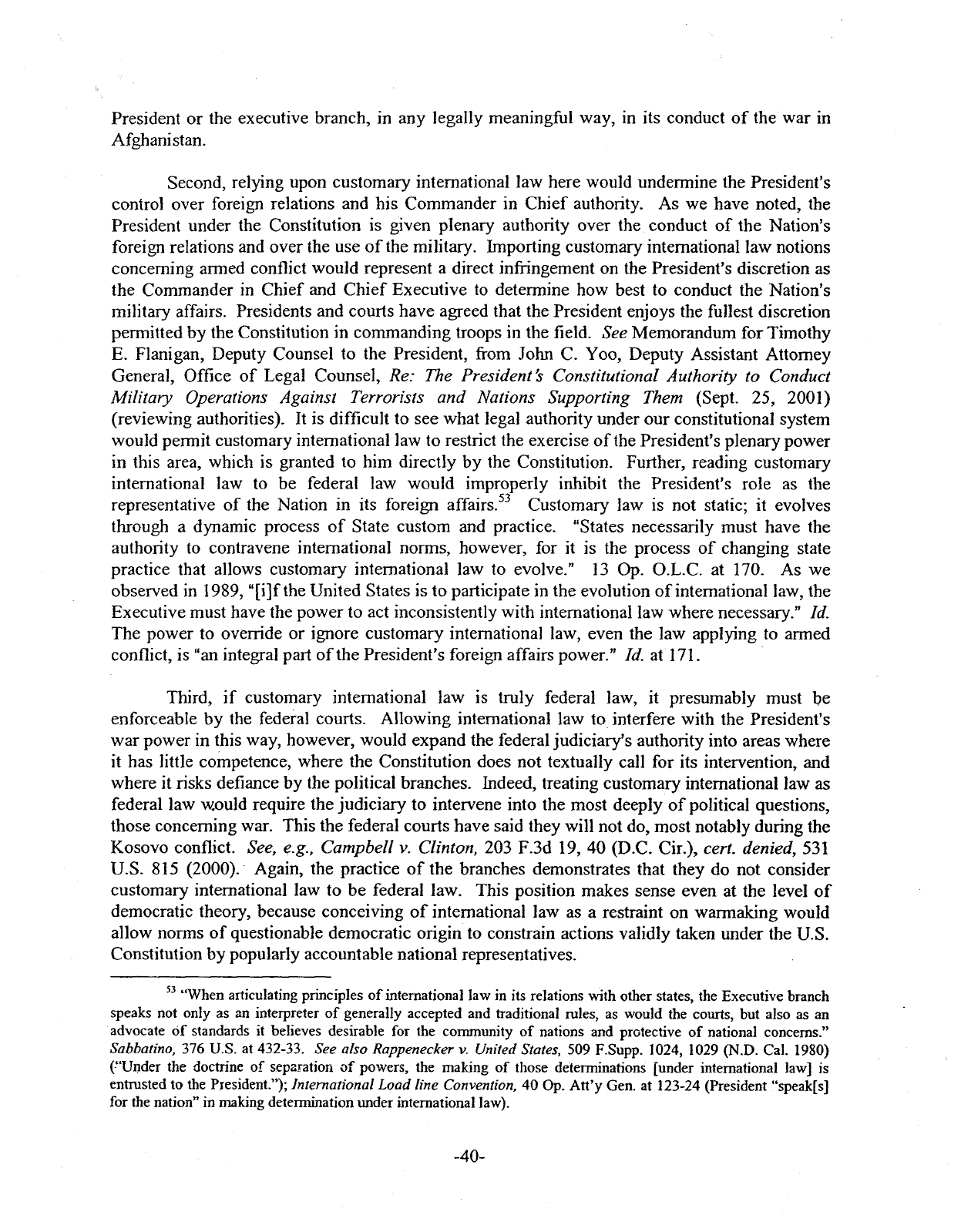
President or the executive branch, in any legally meaningful way, in its conduct of the war in
Afghanistan.
Second,
relying
upon customary international law
here
would
undermine the
President's
control
over foreign relations and his Commander in
Chief
authority. As we
have
noted, the
President under the Constitution is given plenary authority over the conduct of the Nation's
foreign
relations and over the use of the
military.
Importing
customary international law notions
concerning armed
conflict
would
represent
a direct infringement on the
President's
discretion as
the Commander in
Chief
and
Chief
Executive to determine how
best
to conduct the Nation's
military
affairs.
Presidents
and courts
have
agreed that the President enjoys the fullest discretion
permitted
by the
Constitution
in commanding troops in the
field.
See Memorandum for
Timothy
E.
Flanigan, Deputy Counsel to the President,
from
John C. Yoo, Deputy Assistant Attorney
General,
Office
of Legal Counsel, Re: The President's Constitutional Authority to Conduct
Military
Operations Against
Terrorists
and Nations Supporting Them (Sept. 25, 2001)
(reviewing
authorities). It is
difficult
to see what legal authority under our constitutional system
would
permit customary international law to restrict the exercise of the
President's
plenary power
in
this
area,
which
is granted to him directly by the Constitution. Further, reading customary
international
law to be federal law
would
improperly
inhibit
the
President's
role as the
representative of the Nation in its foreign affairs.
53
Customary law is not static; it evolves
through
a dynamic
process
of
State
custom and practice.
"States
necessarily must
have
the
authority
to contravene international norms, however, for it is the
process
of changing
state
practice that allows customary international law to evolve." 13 Op.
O.L.C.
at 170. As we
observed in 1989,
"[i]f
the
United
States
is to participate in the evolution of
international
law, the
Executive
must
have
the power to act inconsistently
with
international law where
necessary."
Id.
The power to override or ignore customary international law, even the law applying to armed
conflict,
is "an integral part
of
the
President's
foreign affairs power." Id. at 171.
Third,
i f customary international law is
truly
federal law, it presumably must be
enforceable by the federal courts.
Allowing
international law to interfere
with
the
President's
war
power in this way, however,
would
expand the federal
judiciary's
authority into
areas
where
it
has
little
competence, where the Constitution
does
not textually
call
for its intervention, and
where it risks defiance by the
political
branches.
Indeed, treating customary international law as
federal
law
would
require the
judiciary
to intervene into the most deeply of
political
questions,
those
concerning war. This the federal courts
have
said they
will
not do, most notably during the
Kosovo
conflict.
See, e.g., Campbell v.
Clinton,
203 F.3d 19, 40 (D.C.
Cir.),
cert, denied, 531
U.S.
815 (2000).
Again,
the practice of the
branches
demonstrates
that they do not consider
customary international law to be federal law. This position
makes
sense
even at the
level
of
democratic theory,
because
conceiving of international law as a restraint on warmaking
would
allow
norms of questionable democratic
origin
to constrain actions
validly
taken under the U.S.
Constitution
by
popularly
accountable national representatives.
5 3
"When articulating principles of
international
law in its relations with other states, the Executive branch
speaks not only as an interpreter of generally accepted and traditional rules, as would the courts, but also as an
advocate of standards it believes desirable for the community of nations and protective of national concerns."
Sabbatino, 376 U.S. at 432-33. See
also
Rappenecker v. United
States,
509
F.Supp.
1024, 1029 (N.D.
Cal.
1980)
("Under
the doctrine of separation of powers, the making of
those
determinations [under international law] is
entrusted to the President."); International Load line Convention, 40 Op. Att'y
Gen.
at
123-24
(President "speak[s]
for the nation" in making determination under international law).
-40-
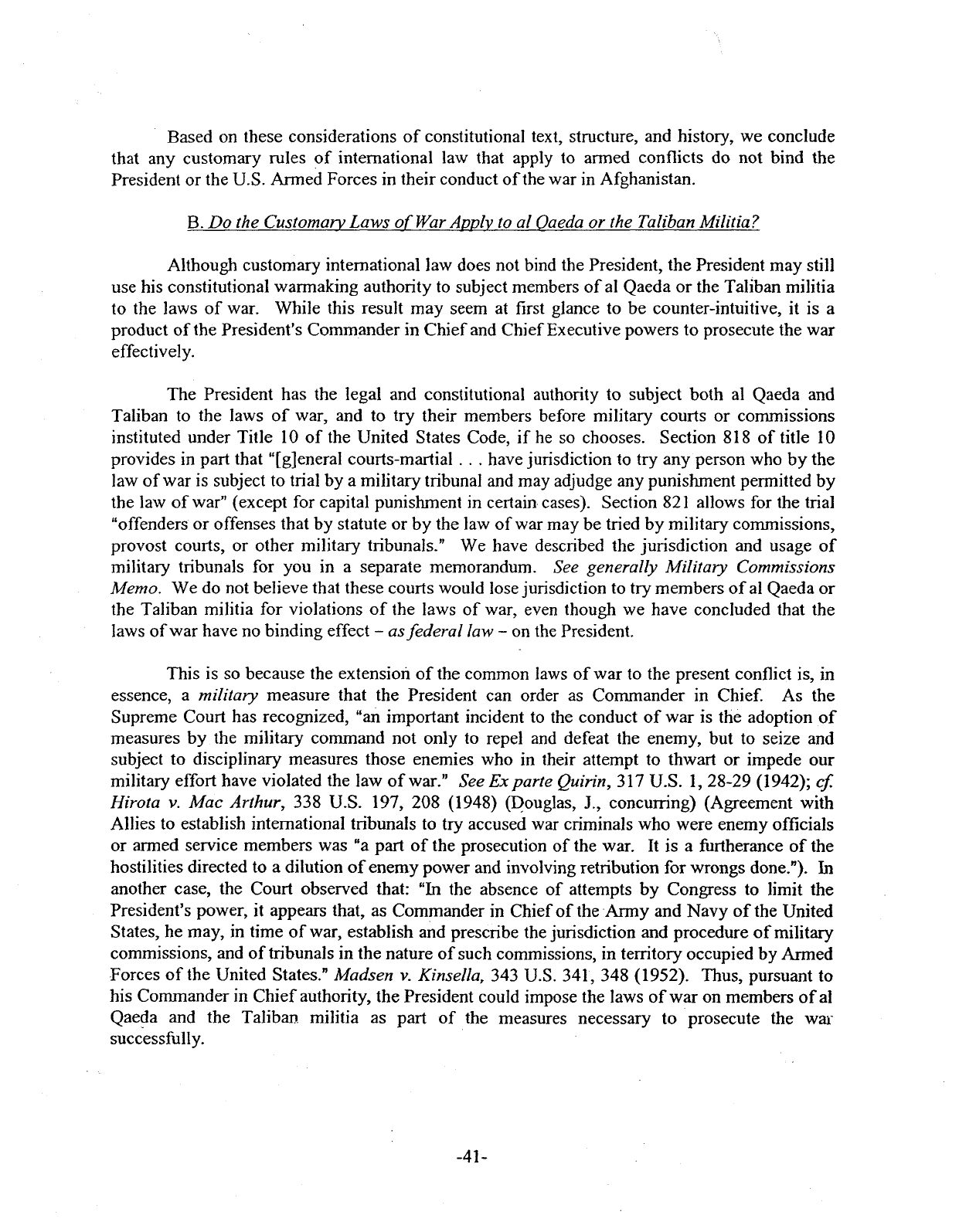
Based on
these
considerations of
constitutional
text, structure, and history, we conclude
that any customary rules of international law that apply to armed conflicts do not
bind
the
President or the
U.S.
Armed
Forces in their conduct
of
the war in Afghanistan.
B.
Do the Customary
Laws
of
War
Apply to al
Qaeda
or the
Taliban
Militia?
Although
customary international law
does
not
bind
the President, the President may
still
use his
constitutional
warmaking authority to subject members of
al
Qaeda
or the Taliban
militia
to
the laws of war.
While
this result may
seem
at
first
glance to be
counter-intuitive,
it is a
product
of the President's Commander in
Chief
and
Chief
Executive
powers to prosecute the war
effectively.
The President has the legal and constitutional authority to subject both al
Qaeda
and
Taliban
to the laws of war, and to try their members before
military
courts or commissions
instituted
under
Title
10 of the
United
States
Code, if he so
chooses.
Section 818 of
title
10
provides in part that "[g]eneral courts-martial . . . have
jurisdiction
to try any person who by the
law
of
war
is subject to
trial
by a
military
tribunal
and may adjudge any punishment permitted by
the law of
war"
(except for capital punishment in certain
cases).
Section 821 allows for the
trial
"offenders or offenses that by statute or by the law of
war
may be
tried
by
military
commissions,
provost
courts, or other
military
tribunals." We have described the
jurisdiction
and
usage
of
military
tribunals for you in a
separate
memorandum. See generally
Military
Commissions
Memo.
We do not believe that
these
courts
would
lose
jurisdiction
to
try
members of
al
Qaeda
or
the Taliban
militia
for violations of the laws of war, even though we have concluded that the
laws
of
war
have no
binding
effect -
as
federal
law - on the President.
This
is so
because
the extension of the common laws of war to the present
conflict
is, in
essence,
a military
measure
that the President can order as Commander in Chief. As the
Supreme Court has recognized, "an important incident to the conduct of war is the adoption of
measures
by the
military
command not
only
to repel and defeat the enemy, but to
seize
and
subject to disciplinary
measures
those
enemies who in their attempt to thwart or impede our
military
effort
have violated the law of
war."
See Ex parte
Quirin,
317 U.S. 1, 28-29 (1942); cf
Hirota
v. Mac Arthur, 338 U.S. 197, 208 (1948) (Douglas, J., concurring) (Agreement
with
Allies
to establish international tribunals to try accused war
criminals
who were enemy
officials
or
armed service members was "a part of the prosecution of the war. It is a furtherance of the
hostilities
directed to a
dilution
of enemy power and
involving
retribution
for wrongs done."). In
another
case,
the Court observed that: "In the
absence
of attempts by Congress to
limit
the
President's power, it
appears
that, as Commander in
Chief
of the
Army
and Navy of the
United
States,
he may, in time of
war,
establish and prescribe the
jurisdiction
and procedure of
military
commissions, and of
tribunals
in the nature
of
such commissions, in
territory
occupied by
Armed
Forces of the
United
States."
Madsen v.
Kinsella,
343 U.S. 341, 348 (1952). Thus, pursuant to
his
Commander in
Chief
authority,
the President
could
impose the laws of war on members of
al
Qaeda
and the Taliban,
militia
as part of the
measures
necessary
to prosecute the war
successfully.
-41-
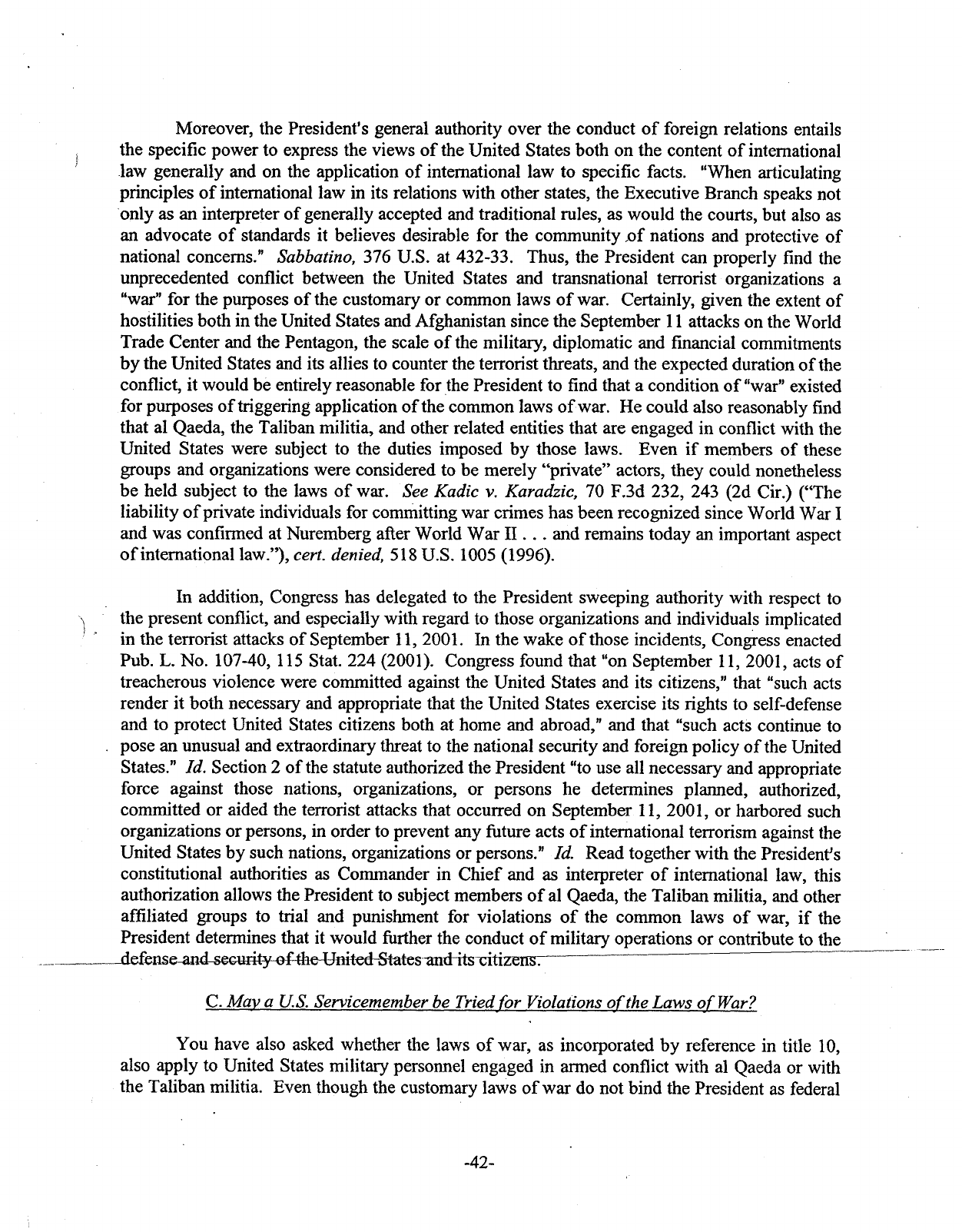
Moreover,
the
President's
general authority over the conduct of foreign relations entails
the specific power to
express
the views of the
United
States
both on the content of
international
law
generally and on the application of
international
law to specific facts. "When articulating
principles
of
international
law in its relations
with
other
states,
the Executive Branch
speaks
not
only
as an interpreter of generally accepted and
traditional
rules, as
would
the courts, but also as
an advocate of
standards
it believes desirable for the community ,of nations and protective of
national
concerns." Sabbatino, 376 U.S. at 432-33. Thus, the President can properly
find
the
unprecedented
conflict
between the
United
States
and transnational terrorist organizations a
"war"
for the
purposes
of the customary or common laws of
war.
Certainly, given the extent of
hostilities
both in the
United
States
and Afghanistan since the September 11 attacks on the
World
Trade Center and the Pentagon, the
scale
of the
military,
diplomatic and financial commitments
by
the
United
States
and its allies to counter the terrorist threats, and the expected duration
of
the
conflict,
it
would
be
entirely
reasonable
for the President to
find
that a
condition
of
"war"
existed
for
purposes
of
triggering
application
of
the common laws
of
war.
He could also reasonably
find
that al
Qaeda,
the Taliban
militia,
and other related entities that are
engaged
in
conflict
with
the
United
States
were subject to the duties imposed by
those
laws. Even if members of
these
groups and organizations were considered to be merely "private" actors, they could
nonetheless
be held subject to the laws of war. See
Kadic
v.
Karadzic,
70 F.3d 232, 243 (2d Cir.) ("The
liability
of
private
individuals
for
committing
war crimes has
been
recognized since
World
War I
and was confirmed at Nuremberg after
World
War
II.. .
and remains today an important
aspect
of
international
law."),
cert, denied, 518 U.S. 1005 (1996).
In
addition,
Congress
has delegated to the President sweeping authority
with
respect
to
the
present
conflict,
and especially
with
regard to
those
organizations and individuals implicated
in
the terrorist attacks of September
11,
2001. In the wake of
those
incidents,
Congress
enacted
Pub.
L.
No. 107-40, 115 Stat. 224 (2001).
Congress
found that "on September 11, 2001,
acts
of
treacherous
violence were committed against the
United
States
and its citizens," that "such
acts
render it both
necessary
and appropriate that the
United
States
exercise its rights to self-defense
and to protect
United
States
citizens both at home and abroad," and that "such
acts
continue to
pose
an unusual and extraordinary threat to the national security and foreign
policy
of
the
United
States."
Id. Section 2
of
the
statute
authorized the President "to use all
necessary
and appropriate
force
against
those
nations, organizations, or
persons
he determines planned, authorized,
committed
or aided the terrorist attacks that occurred on September 11, 2001, or harbored such
organizations or
persons,
in order to prevent any future
acts
of
international
terrorism against the
United
States
by such nations, organizations or
persons."
Id. Read together
with
the
President's
constitutional
authorities as Commander in
Chief
and as interpreter of international law, this
authorization
allows the President to subject members of
al
Qaeda,
the Taliban
militia,
and other
affiliated
groups to
trial
and punishment for violations of the common laws of war, if the
President determines that it
would
further the conduct of
military
operations or contribute to the
defense
and security of the
United
States
and its citizens.
C.
May a
U.S.
Servicemember be
Tried
for Violations
of
the
Laws
of
War?
You
have
also asked whether the laws of war, as incorporated by reference in
title
10,
also apply to
United
States
military
personnel
engaged
in armed
conflict
with
al
Qaeda
or
with
the Taliban
militia.
Even though the customary laws
of
war
do not
bind
the President as federal
-42-

law,
the President may
wish
to extend
some
or all of such laws to the conduct of
United
States
military
operations in this
conflict,
or to the treatment of members of al
Qaeda
or the Taliban
captured in the
conflict.
It is
within
his
constitutional
authority as Commander in
Chief
to
do so.
The common laws of war can be viewed as rules governing the conduct of
military
personnel in
time
of combat, and the President has undoubted authority to promulgate such rules and to
provide
for their enforcement.
54
The
Army's
Manual on the Law of Land Warfare,
which
represents
the
Army's
interpretation of
the
customary
international
law governing armed
conflict,
can be expanded, altered, or overridden at any time by presidential act, as the Manual
itself
recognizes. FM 27-10, ch. 1, f 7(c). This
makes
clear that the
source
of authority for the
application
of the customary laws of war to the armed forces
arises
directly
from
the President
through
his Commander in
Chief
power.
Moreover,
the President has
authority
to
limit
or
qualify
the
application
of such rules. He
could
exempt, for example, certain operations
from
their coverage, or apply
some
but not all of
the common laws
of
war
to this
conflict.
This,
too, is an
aspect
of
the
President's
Commander
in
Chief
authority.
In narrowing the
scope
of the substantive
prohibitions
that apply in a particular
conflict,
the President may
effectively
determine the
jurisdiction
of
military
courts and
commissions. He
could
thus preclude the trials of
United
States
military
personnel on specific
charges
of
violations
of
the
common laws
of
war.
Finally,
a presidential determination concerning the application of the substantive
prohibitions
of
the
laws
of
war
to the Afghanistan
conflict
would
not preclude the normal system
of
military
justice
from
applying to members of the U.S.
Armed
Services. Members of the
Armed
Services
would
still
be subject to
trial
by courts
martial
for any
violations
of
the
Uniform
Code of
Military
Justice (the
"UCMJ").
Indeed,
if
the President were to
issue
an order,
listing
certain
common laws
of
war
for the
military
to
follow,
failure
to obey that order
would
constitute
an offense under the
UCMJ.
10 U.S.C. § 892 (2000). Thus, although the President is not
constitutionally
bound by the customary laws of war, he can
still
choose
to require the U.S.
Armed
Forces
to obey them through the
UCMJ.
The
President has broad authority under the Commander in
Chief
Clause
to take action to superintend
the military that overlaps with Congress's power to create the armed forces and to make rules for their regulation.
See
Loving v. United
States,
517 U.S. 748, 772 (1996) ("The President's duties as Commander in Chief... require
him
to take responsible and continuing action to superintend the military, including
courts-martial.");
United
States
v. Eliason, 41 U.S. (16 Pet.) 291, 301 (1842) ("The power of the executive to establish rules and regulations for the
government of the army, is undoubted."). The executive branch has long asserted that the President has "the
unquestioned power to establish rules for the government of the
army"
in the absence of legislation, Power
of
the
President to Create a Militia Bureau in the
War
Department,
10 Op. Att'y
Gen.
11, 14 (1861). Indeed, at an early
date, Attorney
General
Wirt
concluded that regulations issued by the President on his independent authority
remained
in force even after Congress repealed the statute giving them legislative sanction "in all cases where they
do not conflict with positive legislation." Brevet Pay
of
General
Macomb,
1
Op.
Att'y
Gen.
547, 549 (1822). These
independent powers of
the
President as commander in chief
have
frequently been exercised in
administering
justice
in
cases involving members of
the
Armed
Forces:
"[i]ndeed, until 1830,
courts-martial
were convened solely on [the
President's] authority as
Commander-in-Chief."
Congressional Research Service, The Constitution of
the
United
States
of
America: Analysis and
Interpretation
479 (1987).
-43-

Thus,
our
view
that the customary international laws of armed
conflict
do not
bind
the
President
does
not, in any way, compel the conclusion that members of the U.S.
Armed
Forces
who
commit
acts
that
might
be considered war crimes
would
be free
from
military
justice.
Conclusion
For
the foregoing
reasons,
we conclude that,
based
on appropriate presidential
determinations, the neither the federal War Crimes Act, the Hague Convention IV, nor the
Geneva Conventions
would
apply to the operations of the U.S.
Armed
Forces against the al
Qaeda
terrorist organization or the Taliban
militia,
or to the treatment of members of
those
groups captured by U.S.
Armed
Forces in this
conflict.
We also conclude that customary
international
law has no
binding
legal effect on either the President or the
military
because
it is
not
federal law, as recognized by the Constitution. Nonetheless, we also believe that the
President, as Commander in Chief, has the
constitutional
authority
to impose the customary laws
of
war
on both the al
Qaeda
and Taliban groups and the
U.S.
Armed
Forces.
Please
let us know
i f
we
can provide further
assistance.
-44-
